Talking Roots
‘We need to manage the blight actives we have left’ February
POTATOES
Page 18
Managing PCN threat without nematicides
Pages 26-31
RESEARCH IN ACTION
Delving into septoria defence collapse
Pages 46-47
MACHINERY
Latest kit shines at the LAMMA Show
Pages 52-63
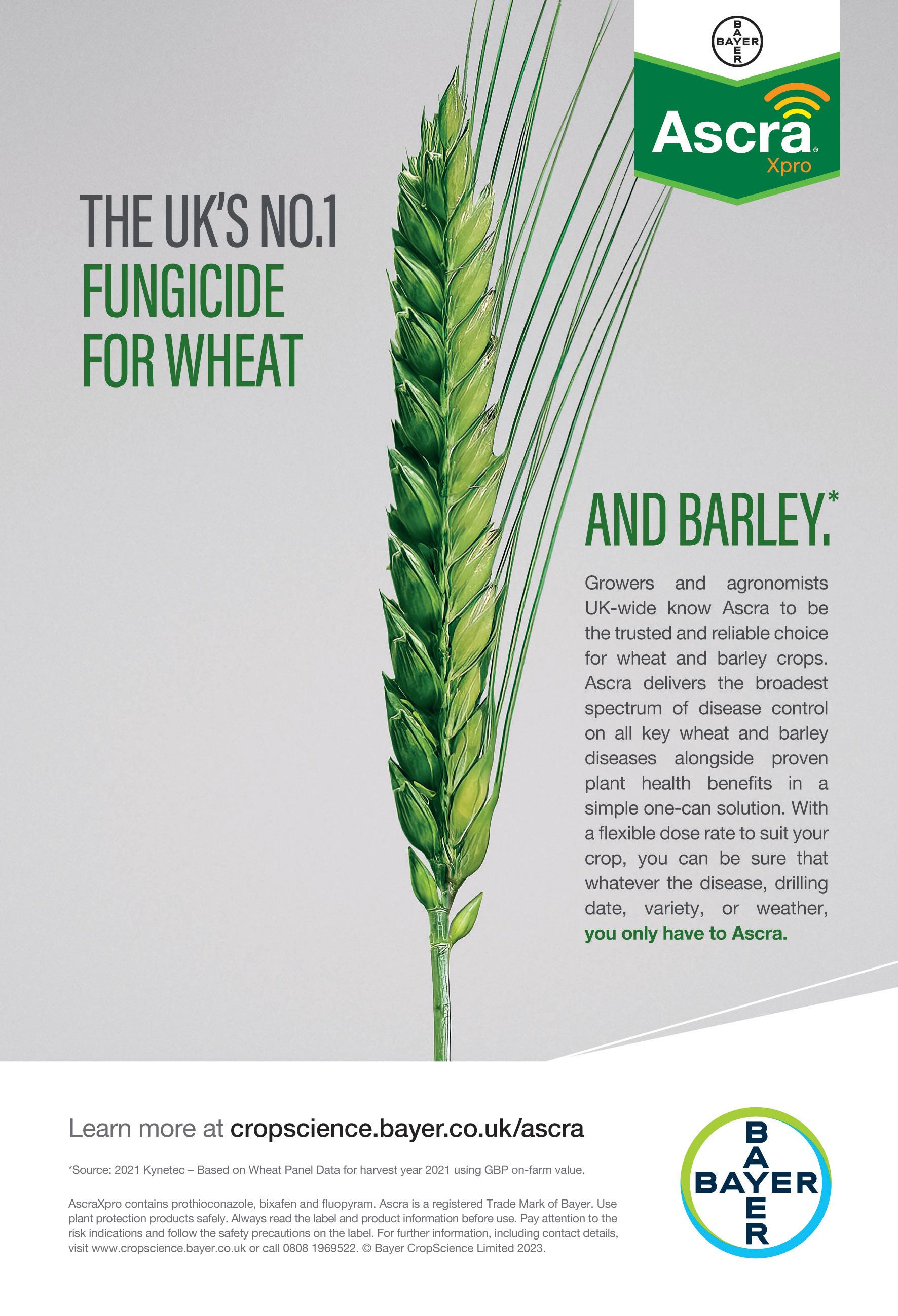
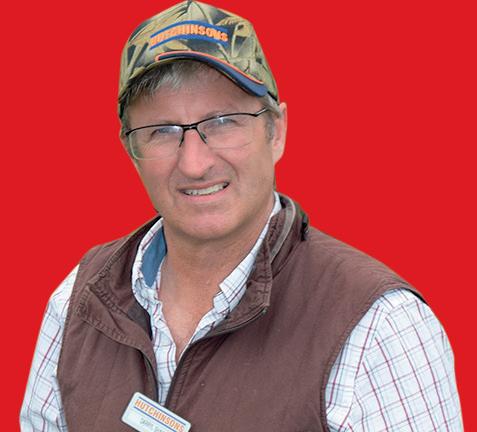
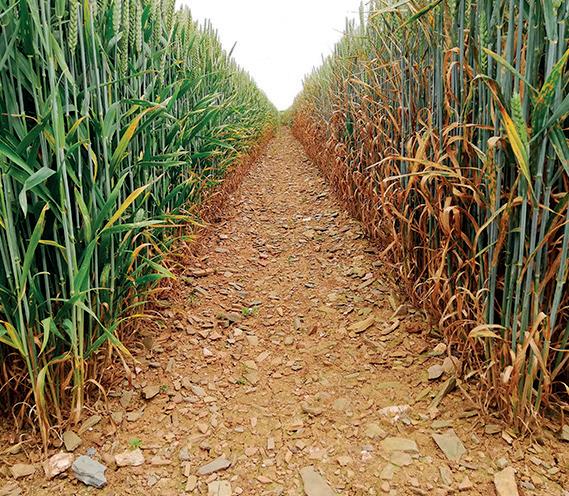


Innovation in action for progressive arable farmers
2023
Volume 46 Issue 2
SPRING CLEAN FOR GRASS WEEDS
LARGER OVERWINTERED WILD OATS AND RYEGRASS THIS SEASON WILL HAVE A SIGNIFICANT IMPLICATION FOR AXIAL® PRO SPRING CONTROL STRATEGIES, ADVISES SYNGENTA TECHNICAL MANAGER, PETE HAWKINS.
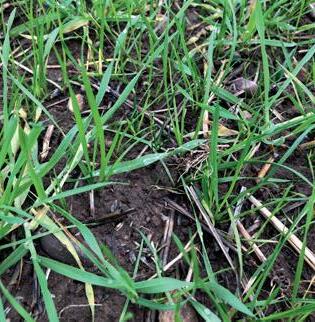

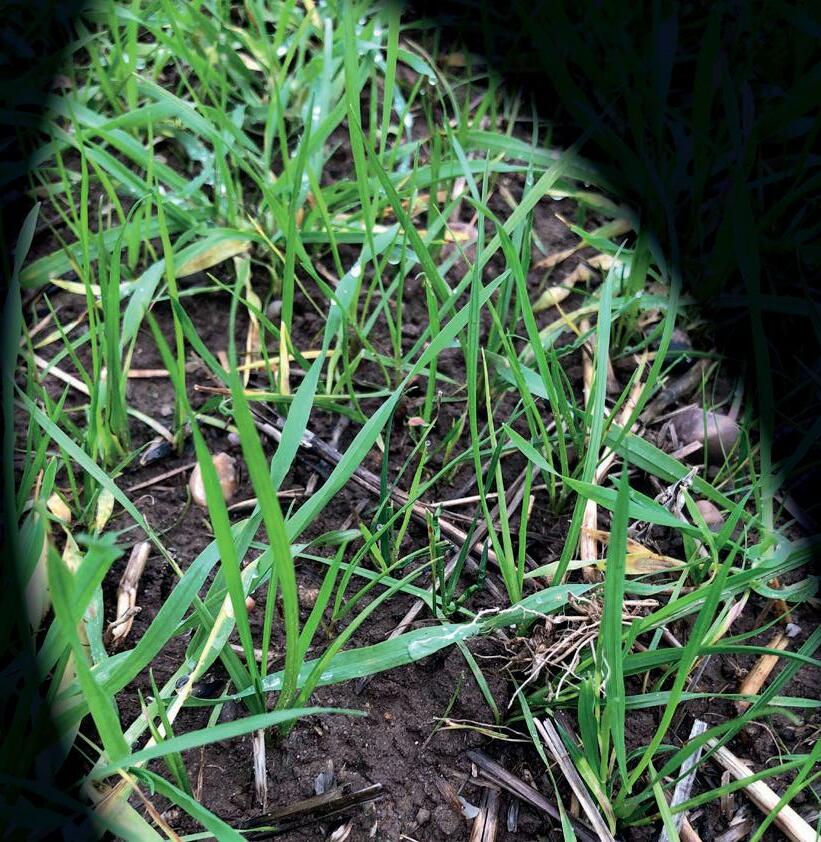

“Weed size and populations are very variable this season. With many crops drilled early in an open autumn and the variability of success from preemergence programmes - which depended largely on rainfall and soil moisture - some fields now contain relatively large weeds.”
“Take advantage of any good application opportunity to target grass weeds early this spring,” advises Pete Hawkins.






New NIAB research with Syngenta has shown that it’s these larger, overwintered grass weeds that have the greatest effect on yield loss and produce higher numbers of viable seeds to perpetuate problems in the future.

“The cold weather in December may have checked growth, but most weeds have recovered strongly,” he warned. “Large weeds are also often associated with bigger crops, which can make targeting with herbicides more difficult.”
Pete advocates treatment of wild oats and ryegrass with AXIAL Pro as soon as weather conditions allow when weeds are actively growing from the 1st February. Good growth of target weeds means the herbicide is more effectively translocated down into the root, to achieve a complete kill.

“While there may be a temptation to delay treatment, to allow later germinating grass weeds to come up, the research has shown these later emerging weeds pose far less threat to the crop and produce a much lower seed return at maturity.”
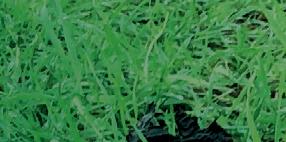
“Holding off grass weed control will result in more competition on crop yields and could prove more difficult to control larger weeds – requiring higher AXIAL Pro rates and a greater challenge for application.”
With overwintered wild oats, for example, up to growth stage 29, an AXIAL Pro rate of 0.6 l/ha is advised increasing up to the maximum 0.82 l/ha once the oats are beyond growth stage 30. If growing conditions are sub-optimal consider delaying application or use the higher dose rate. For larger weeds, up to growth stage 39, and for all ryegrass treatments, the higher rate of 0.82 l/ha would be the default, he added.
Pete pointed out that tank mixing AXIAL Pro with a compatible broad-leaved weed herbicide can achieve a complete spring clean-up in a single spray, to help reduce workload and cost.
But where it is being used in a herbicide sequence that includes SU/ALS or hormone broad-leaved weed treatments, applying AXIAL Pro first ensures the grass weeds can be taken out at the optimum time, shortly followed by broad-leaved weeds seven days later. Otherwise, a 21-day interval is required after an ALS/ hormone herbicide has been used before the AXIAL Pro can be applied.
Early removal of grass weeds is paramount to protect yield, and to minimise seed return in a sustainable weed control strategy.
PETE’S TOP TIPS FOR SPRING GRASS WEED CONTROL






• Prioritise fields with the biggest weeds
• Apply AXIAL Pro as soon as conditions permit (from 1st February)
• Don’t delay for spring weed emergence
• Adjust application rates to target weed and size
• Tank-mix with a BLW herbicide for a one-spray solution
ADVERTORIAL
Syngenta UK Ltd. Registered in England No. 849037. CPC4 Capital Park, Fulbourn, Cambridge CB21 5XE. Tel: +44 (0) 1223 883400 Technical Enquiries: +44 (0) 800 1696058 Email: customer.services@syngenta.com. AXIAL® Pro is a Registered Trademark of a Syngenta Group Company. AXIAL Pro (MAPP 19010) contains pinoxaden. Use plant protection products safely. Always read the label and product information before use. For further product information, warning phrases and symbols refer to www.syngenta.co.uk. ©Syngenta UK Ltd. January 2023. 12511.
Growers and agronomists should be assessing crops now for the size of overwintered grass weeds, to prioritise fields for AXIAL Pro application as soon as conditions allow.
Overwintered wild oats and ryegrass (inset) are already well established this season. NIAB research has revealed October germinated winter wild oats grow on average four times bigger and are more competitive, compared to early spring germinating weeds.
The

News
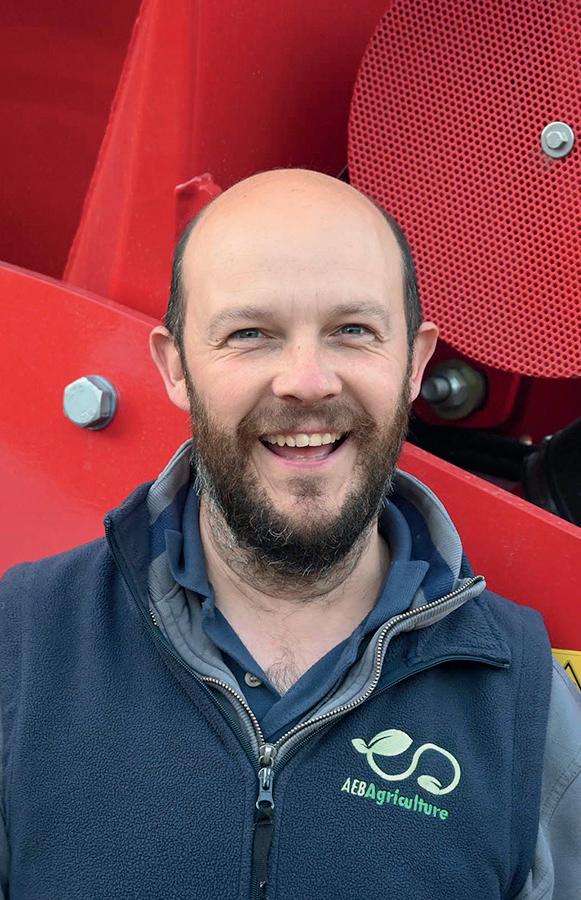
It
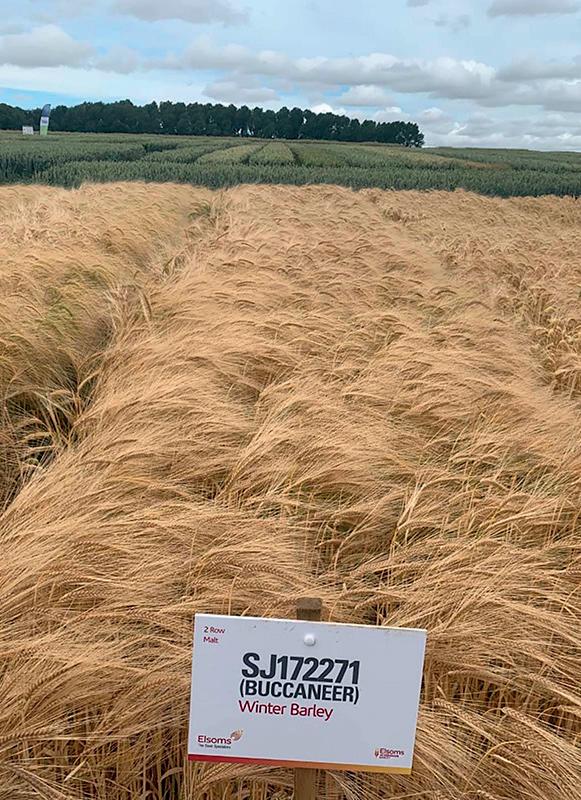
CONTENTS: REGULARS 3 FEBRUARY 2023
Talking Arable
Comment 10
cold weather has provided an opportunity to try some mechanical cover crop destruction
Talking Agronomy
a season of weather uncertainty, cover crop diversity has
18 Talking Roots
14
In
shown its worth
of a new resistant blight strain highlights the
for
of remaining actives 64 Talking Policy
need
care with use
is how we guide and respond to policy that is
Technical
Getting PCN trap crops off to the best start
team of farmers, potato agronomists and researchers is
PCN trap crop establishment
Recommended Lists get a small but mighty boost
look at what newcomers to the AHDB
PGRO
36 IPM approach needed for sugar beet weed control
a combination of cultural
weeds going forward 42 Study gives OSR confidence boost Oilseed rape growers report their autumn 2022 crop establishment experiences 44 Inoculate to accumulate with wheat Bugs can be beneficial, according to a British firm developing bacterial seed treatments LAMMA 2023 show report 52 Latest tractor and loader developments 54 Trailers and tankers on show 56 Technology and robotics highlights 58 Sprayer and spray tech news 61 New kit for cultivations and crop establishment Podcast 65 Staffing advice in the cost of living crisis Arable Farming’s Alice Dyer gets some expert advice on attracting and retaining good staff BASIS News 66 Fresh future for NRoSO What is in store as the professional register for sprayer operators moves to BASIS administration? FEBRUARY 2023 VOLUME 46 ISSUE 2
10 52 32
ultimately what matters
26
A
digging down into
32
A
and
variety lists bring to the field
Why
and chemical approaches will be needed to control
In this issue of
19 Weeds
Grass-weed control
How SCUs are putting weed seeds through the mill
28 Potatoes
Crop protection
Expert opinion on managing the PCN threat without nematicides

38 Agronomy
Spring weed control
Why careful use of post-emergence herbicides can counter ryegrass
46 Research in Action
Cereal disease
Plant scientists are unravelling the genetics behind septoria defence collapse
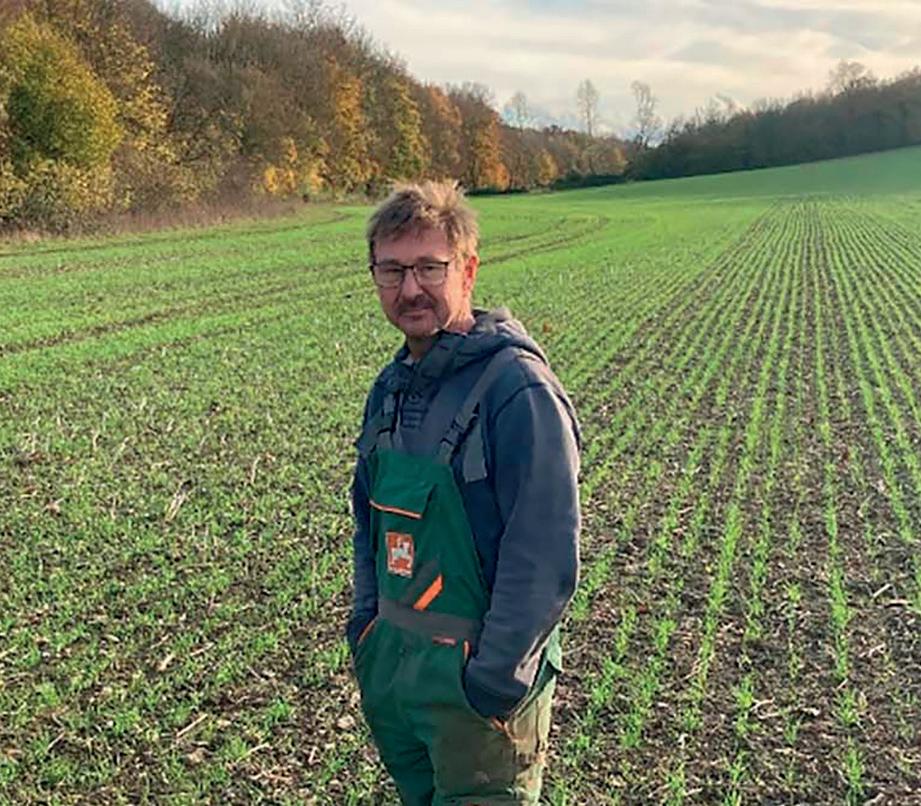
48 Machinery
Farm robotics
Can teams of robots work together to improve soil health testing?

CONTENTS: FEATURES 4 FEBRUARY 2023 19 38 48
a word from the editor
Contacts
Group Editor – Arable


Teresa Rush 01787 282 822 teresa.rush@arablefarming.com
Senior Arable Technical Specialist
Alice Dyer 07966 445 458 alice.dyer@arablefarming.com
Arable Technical Specialist
Ash Burbidge, 07786 190 188 ashleigh.burbidge@agriconnect.com
Machinery Editor
Toby Whatley 07583 054 831 toby.whatley@arablefarming.com
Head of Creative Services
Gillian Green, 01772 799 417 gillian.green@agriconnect.com

Picture Editor
Marcello Garbagnoli 01772 799 445 marcelllo.garbagnoli@arablefarming.com
Account Manager
Jane Newton 01948 780 783 jane.newton@arablefarming.com
Account Manager
Mark Jackson 01322 449 624 mark.jackson@arablefarming.com
Account Manager
Chris Knowles 01772 799 550 chris.knowles@arablefarming.com
Head of Commercial Solutions
Mike Hartley 01772 799 532 mike.hartley@arablefarming.com
Advertising Production
Justine Sumner 01772 799 437 justine.sumner@arablefarming.com
For circulation queries, to request a copy or subscribe, please contact Emma Williamson 01772 799 452 emma.williamson@arablefarming.com
Subscriptions
Contact: 03303 330 056 help@subscribe.farmers-guardian.com
© Agriconnect 2023
All rights reserved. No part of this publication may be reproduced or transmitted in any form or by any means, electronic or mechanical including photocopying, recording, or any information storage or retrieval system without the express prior written consent of the publisher.
The contents of Arable Farming are subject to reproduction in information storage and retrieval systems. ISSN 0269-6797

The mud is back. The recent run of frosts meant hard ground and clean boots, but with the return of milder weather and some rain, I am trudging around my morning walk accompanied by a steady build-up of Hanslope Series on my footwear.
Conditions are certainly not fit for a sprayer to travel and, with the cut-off date fast approaching, I suspect some oilseed rape crops will not get their planned application of propyzamide.
I cannot quite believe January is almost over. LAMMA has come and gone – it was good to see packed halls and feel the buzz again – and there are signs of spring appearing. But as we well know, there is a long way to go until spring is truly here.
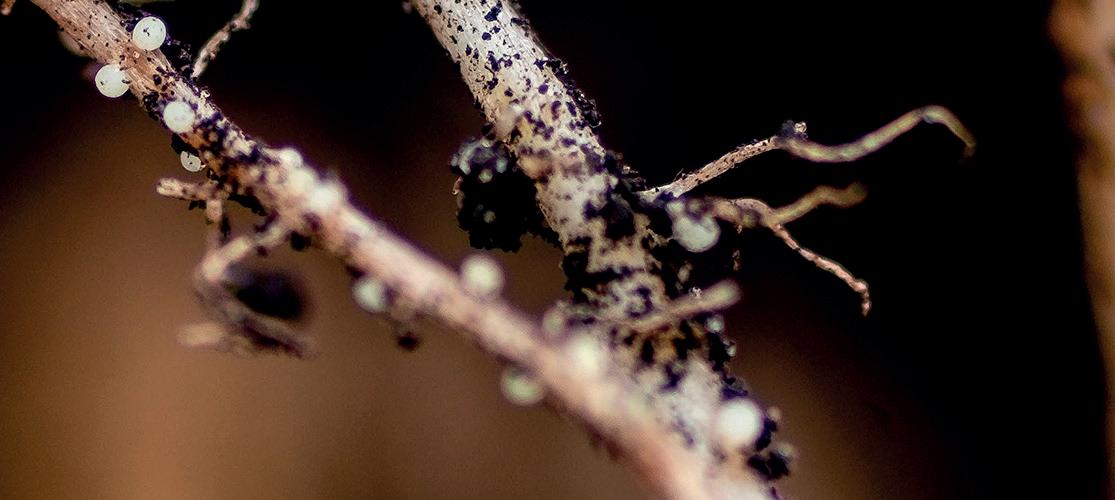
As this issue goes to press, further details on the latest Environmental Land Management (ELM) scheme updates are emerging from Defra.
Early responses from industry leaders indicate there has been a cautious welcome of information on six new standards, payment rates and Country Stewardship developments, but it would seem concerns remain over inclusivity, with the Soil Association pointing to zero recognition of the significant contribution that an organic, whole-farm system approach already delivers.
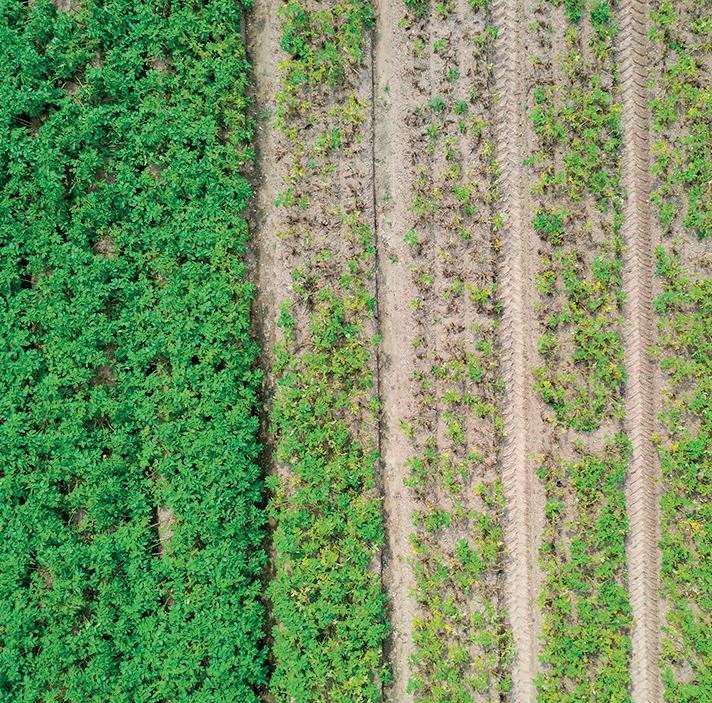

Potatoes
is time of year provides an opportunity to reect on some of the information imparted at the various conferences and technical meetings that traditionally take place over winter.
I spent two days in December at the Cambridge University Potato Growers Research Association conference and, while the potato sector is without doubt going through an extremely tough time, it was heartening to hear about some of the work that
is going on to support potato producers as they endeavour to grow profitable crops. Potato cyst nematode (PCN) is a massive challenge for the sector and in this issue we report on one senior agronomist’s views on the agronomic challenges of growing potatoes without nematicides (see p28-31).
And, staying with potatoes, the news from Denmark of a new blight strain resistant to the CAA group of fungicides (p18) is concerning. While the EU_41_A1 strain has not yet been detected in the UK, there is clearly a need in the coming season to manage blight programmes with this threat in mind. Elsewhere in the issue, we bring news of work to unravel the genetics behind varietal resistance to septoria (p46-47). And, while you wait for spring, there is time to catch up with the latest kit developments in our round-up of highlights from LAMMA (p52-63).
www.croptecshow.com November 23-24, 2023 5 FEBRUARY 2023 Origination by Farmers Guardian, Unit 4, Fulwood Business Park, Caxton Road, Preston, Lancashire, PR2 9NZ. Published by Agriconnect. Printed by Precision Colour Printing, Halesfield 1, Stirchley, Telford TF7 4QQ. No responsibility can be accepted by Arable Farming for opinions expressed by contributors. 28
Arable Farming, Unit 4, Fulwood Business Park, Caxton Road, Preston, Lancashire PR2 9NZ
Pressure on livestock production is leading to reduced animal feed production, which makes the inclusion of feed grains in biofuel mixes even more important. Cedric Porter reports.
Falling animal production hits feed grain use
The amount of grain and oil crop cake used to make animal feed in the five months to the end of November was 5.5% lower than the same period the year before at 4.53 million tonnes, with the slowdown in usage accelerating more recently, according to the AHDB.
In November last year, usage of all feed ingredients was at 907,300t, 6.4% less than the same month the year before. Production between July and November was the smallest for six years.
The biggest drops in usage have taken place in barley –down 25.8% to 460,600t in the five-month period – and oats –down 34.8% to 32,400t.
Wheat usage fell by just 4.2% to 1.355mt. The rising cost of grain over the last year means feed manufacturers have used more whole and flaked maize, with volumes up 19.5% to 168,400t.
The figures show which livestock sectors are under pressure. Production of feed for cattle slipped by just 1.8% in the five months to the end of November, with a 0.8% increase in dairy feed output reflecting strengthening milk prices and a lack of forage because of last year’s drought.
There was also a small increase in sheep feed production. But that
Pig production costs and sale prices (p/kg)
kg to produce UK pigs. However, the average price is still only a little over 200p/kg, resulting in continued large-scale losses.
Carol Davis, lead farm economics analyst at AHDB, says: “With pig producers experiencing continued negative margins since October 2020, it is estimated [based on the total pig slaughter numbers] the industry has lost £737m in the last two years.”

contrasted with a big drop in feed production in the feed-intensive pig and poultry industries. Pig feed production fell by 8.9% to 813,900t, with off-farm poultry feed output down by a similar margin to 1.634mt. Feed output on integrated poultry units was down 2.9% to 844,400t, resulting in a drop of 6.4% in total poultry feed production.
Peter Collier, a senior analyst at CRM AgriCommodities, says: “The strong performance of imported ingredients such as maize probably reflects pre-season hedging by feed processors who anticipated higher prices of home-grown grains, such as wheat and barley.
“What has been surprising is the decline in usage of barley which has been trading at a discount to

wheat. The recent fall in UK grain prices will probably make UK grains more attractive to feed ingredient buyers.”
Pigs and poultry
The feed usage and production figures reflect a fall in pig and poultry production. The number of pigs slaughtered in the UK in December was 7.1% lower than December 2021 and the smallest volume since the same month in 2018. Meanwhile, the number of sows and boars slaughtered was the highest since 2018, reflecting a shrinking of breeding pig numbers.
Pig prices have risen in recent months as supply has tightened but it is still not enough to return production to profitability. Latest AHDB figures for October estimate it cost an average of 237p/
In the first six months of 2022, pig producers were losing more than £50 a head, according to AHDB figures. Aside from farmgate prices not increasing rapidly enough, much of that loss has been down to higher feed prices. In the last 12 years, feed has made up as little as 55% of total pig production costs. In the second quarter of 2022, that rose to almost 73%.
Egg production in the third quarter of 2022 was at its lowest three-month total since the third quarter of 2015 at just 213.2m dozen, according to Defra data. That total was 9.6% less than in Q3 2021, with further declines expected in the last three months of the year as pressure on margins continued and flock keepers had to keep birds indoors to prevent the spread of bird flu.
The free-range egg price has risen from 103p/dozen to 116p/ dozen since October 2022, according to the British Free Range
6 BUSINESS FEBRUARY 2023
2010 2011 2012 2013 2014 2015 2016 2017 2018 2019 2020 2021 2022 300 250 200 150 100 50 0
Total production cost Feed cost Average sale price
SOURCE: AHDB
Falling levels of production in the livestock sector have seen a drop in grain usage in animal feed.
Egg Producers Association, but the breakeven price is still at 136p/ dozen, resulting in continuing heavy losses. It has called for greater commitment and contracts from retailers to ensure production is profitable and supply reliable.
Production of poultrymeat has been more consistent over the last year, down by only 2.2% to 1.155m birds.
Bioethanol bonus
Although the usage of grain for feed may have dropped this season, usage for bioethanol has increased. The UK’s two major bioethanol plants can take more than 1.5mt of wheat a year.
Both are operating this season, with higher oil prices and a requirement for 10% biofuel in petrol allowing for production. However, Cleveland-based Ensus has only committed to stay open until March. Meanwhile, Vivergo in Hull is operating for the first time since 2018 and is not at full capacity.
Mr Collier says: “It is difficult to know how much wheat is being used for bioethanol, but premiums for wheat sold into the north east of England suggest there is demand.”
In mid-January, feed wheat delivered into North Humberside for May 2023 was trading at a £10/t premium over delivered East Anglian feed wheat at £243/t, according to AHDB data.
The amount of UK wheat used for human and industrial use, which includes bioethanol, was 6.8% higher in the July to November 2022 period than the year before at 2.138mt.
Anthony Speight, senior analyst at AHDB, says: “The figures suggest the increase in bioethanol production may have compensated for some if not all the drop in animal feed usage.
“However, it has to be remembered that half the grain used in
bioethanol production is returned as animal feed, which could add to supply pressure for feed.”
He believes the availability and price of wheat will continue to make it attractive to feed processors and the bioethanol plants.
An important question for livestock and arable farmers is how long lasting a reduction in livestock production may be. A severe squeeze on pig margins in the late 1990s led to a reduction in numbers by a third between 1998 and 2001,

while dairy cow numbers are 10% down on 2006 levels.
The number of laying hens may increase if profits are made once again, but that could lead to over-production in the egg industry and another reduction in price and then production.

Other possible long-term pressures on feed usage include a reduction in meat and dairy consumption and the increased usage of non-grain feed ingredients, such as insects.
GB animal feed ingredient usage and feed production (1,000s of tonnes)
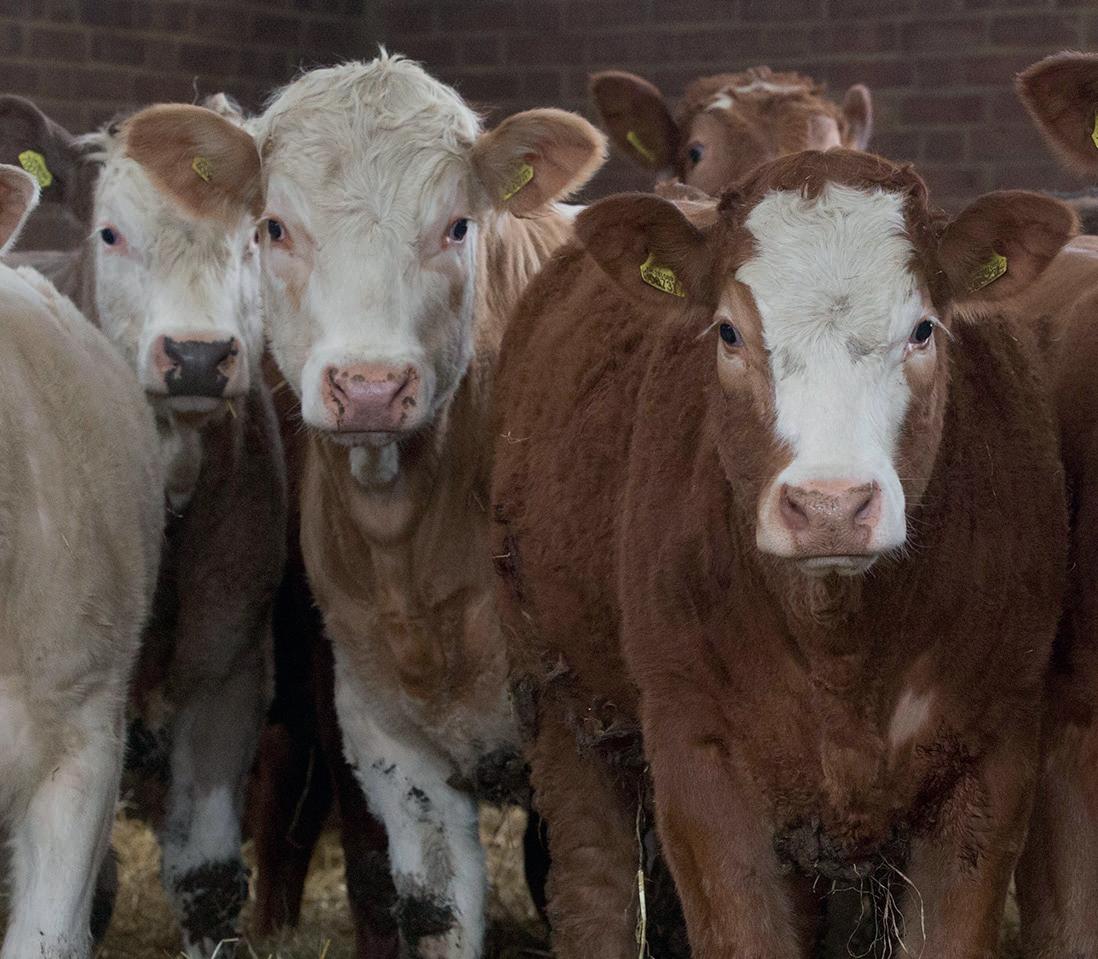
7 BUSINESS FEBRUARY 2023
November Change on July to Change on July to ’22 November ’21 November ’22 November ’21 Feed ingredient 907.3 -6.4% 4,530 -5.5% usage total Wheat 260.3 -11.6% 1,354.8 -4.2% Barley 94.6 -17.7% 460.6 -25.8% Oats 7 -47.4% 32.4 -34.8% Whole and 30.5 21% 168.4 19.5% flaked maize Vegetable oil 225.4 3.4% 1,078.9 -1% cake and meal Other usage 289.5 -3.4% 1,434.9 -2.6% Feed production 909.2 -7.1% 4,567.2 -5.4% Cattle and calf feed 347.8 -1.5% 1596 -1.8% Dairy feed 254.1 3.5% 1,181.3 0.8% Pig feed 154.9 -15.4% 813.9 -8.9% Poultry feed 295.8 -10.5% 1,634.2 -8.9% Integrated poultry 154 -7.6% 844.4 -2.9% unit feed Total poultry feed 449.8 -8.7% 2,478.6 -6.4% Sheep feed 51 -4.9% 215.4 10.3%
Source: AHDB
Defra grants EA for beet seed treatment
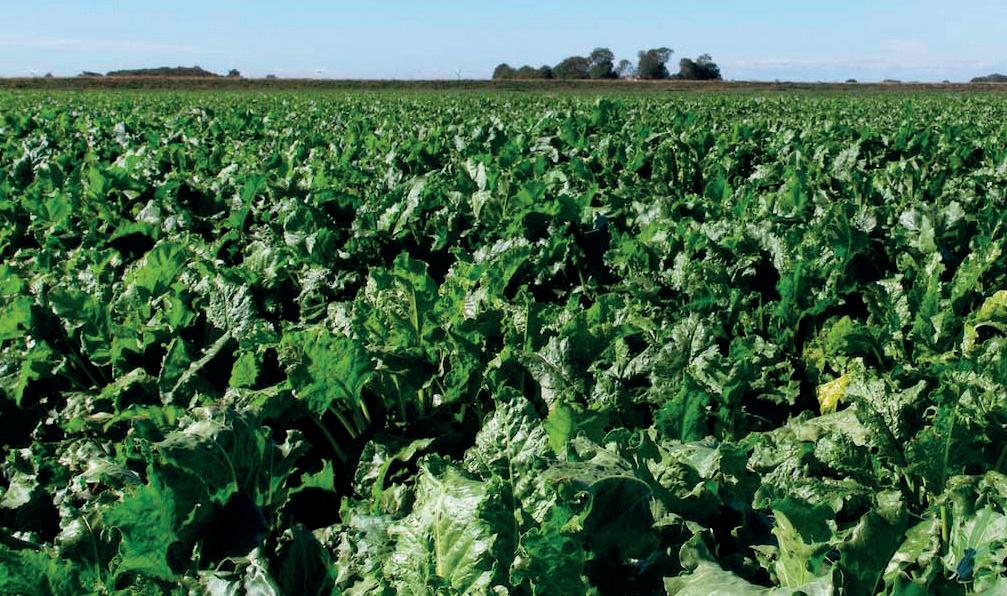
Defra has granted an Emergency Authorisation (EA) for the use of the neonicotinoid seed treatment, Cruiser SB (thiamethoxam), should conditions mean it is required for the 2023/24 crop.
In a statement announcing the EA, British Sugar said: “As with our previous EA applications, the use of Cruiser SB is subject to the outcome of the predetermined, independent Rothamsted Virus Yellows model, which predicts the pressure for the growing season ahead.
“We are currently evaluating
the threshold that has been set for this year, and waiting for the stewardship conditions, to understand the practicalities in more detail.”
‘Fortify’ farms call after surge in diesel thefts
JFarmers are being urged to fortify their farmyards to deter thieves from draining their fuel tanks after diesel thefts more than doubled over the past 12 months.
Rural insurer NFU Mutual said the cost of diesel thefts jumped to more than £880,000 in 2022, an increase of 145% on the previous year, as soaring diesel prices made fuel tanks an increasingly tempting target for thieves.
With diesel prices remaining
close to record highs, the insurer said it was concerned that diesel raids could continue in coming months.
It suggested farmers review and upgrade their security systems to help deter thieves and prevent their businesses from being targeted.
Andy Manson, managing director of NFU Mutual Risk Management Services, said ensuring the farmyard had effective security was the first step to deterring thieves.
Pool price is announced
JUnited Oilseeds has announced that growers in its 2022 Harvest Pool received a price of £645.38 per tonne for
their OSR. The pool delivered a base price of £580.02/tonne and an average quality bonus of £65.36.
The decision has met with opposition from some environmental groups.
Soil Association head of farming policy Gareth Morgan
said: “The Government has ignored scientific evidence and abandoned their own commitment to protect pollinators for the third year running.
Harm
“The UK’s approval for emergency use of bee-harming neonicotinoids came just days after the EU banned this course of action, in recognition of the harm they are proven to cause our vital pollinators – and the threat that poses to everyone’s future.
“Neonicotinoids simply have no place in a sustainable farming system, and farmers need support and guidance to end reliance on them.”
Phosphorus use strategy published
JScientists have published the UK’s first comprehensive strategy setting out how the management of phosphorus could be transformed.
It provides a roadmap for better management of the vital element, which plants need to grow and is essential for food production, but which is also behind environmental pollution in rivers and lakes.
The UK Phosphorus Transformation Strategy has been drawn up by scientists from UK Centre for Ecology and Hydrology (UKCEH) and other institutes .
It outlines a need for new solutions and scaling-up of existing innovations to prevent future damage to aquatic biodiversity and habitat, reduce reliance on volatile import markets and to unlock new opportunities for agriculture.
Crop and livestock production in
the UK is almost entirely dependent on imported P – around 174,000 tonnes annually – contained within feeds and fertilisers.
However, less than half is used productively to grow food due to inefficiencies in its application and management. And billions of pounds worth of phosphorus are locked in UK top soil from decades of applications of fertiliser and manure. Accessing and managing this legacy phosphorus ‘bank’ is central to improving efficiency and reducing imports, says the team of scientists behind the new strategy.
The strategy’s recommendations, jointly developed with farmers and other stakeholders include developing and deploying new technologies and innovations that can recover P from animal manure, wastewater and food waste.
8 NEWS REVIEW FEBRUARY 2023
Defra’s decision to allow use of a neonicotinoid seed treatment on the new season sugar beet crop has met with some opposition.
CNH retains UK tractor sales crown for 2021
JCNH Industrial remained the largest manufacturer by volume to supply the UK agriculture market in 2021, recent figures from the Agricultural Engineers Association (AEA) reveal.
CNH, which owns the New Holland and Case IH brands, supplied 4,037 tractors into the UK market in 2021, claiming some 28.7% of the total market share. The total figure was split, with 2,682 machines coming from New Holland and 1,355 from Case IH.
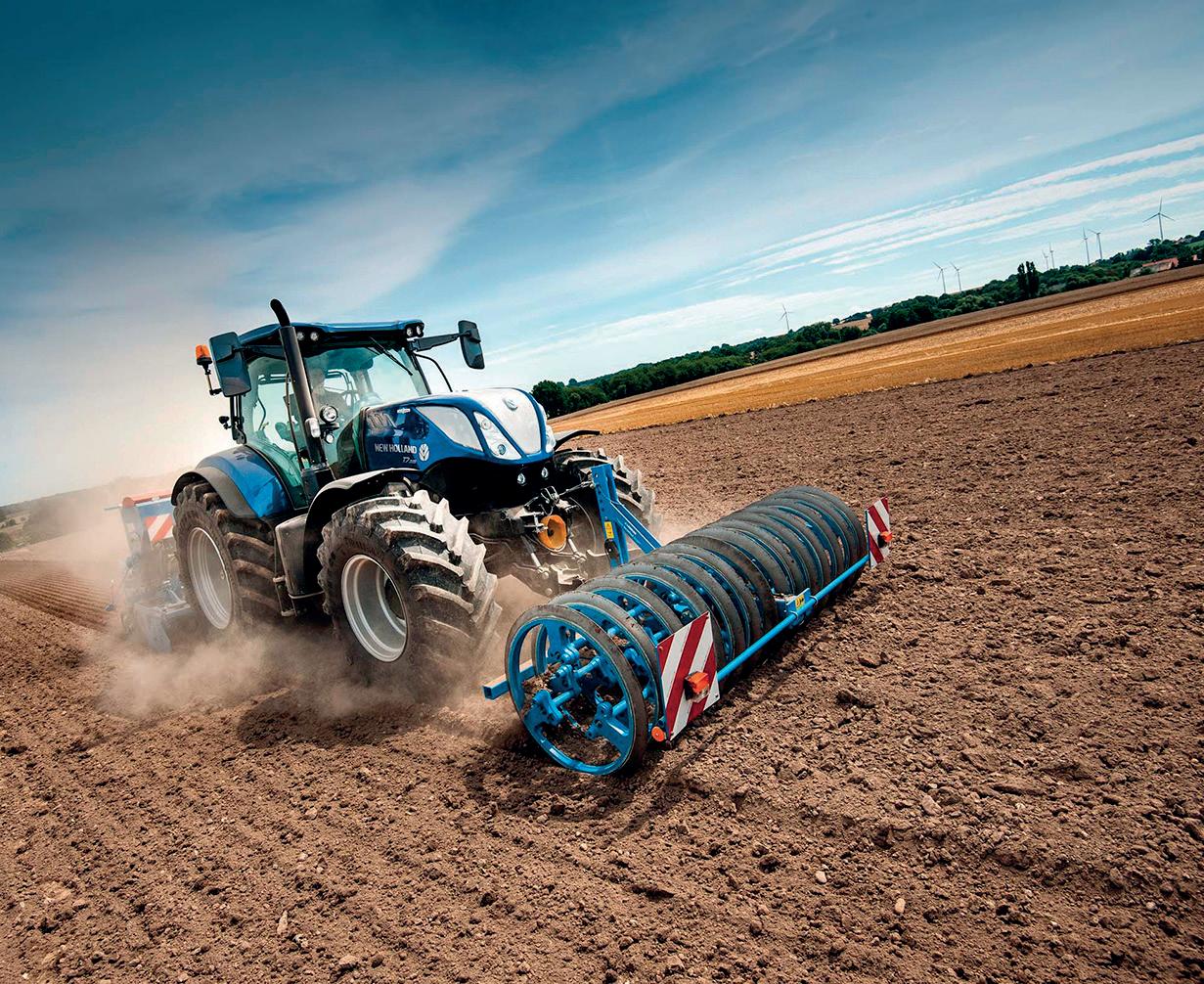
Following with a 25.3% and 3,558 units was John Deere which had, up until 2020 remained the number one UK manufacturer since 2004.
Taking the third position
with a 21.9% market share was Agco, which was broken down into the three UK brands; Massey Ferguson (1,530 units) Fendt (911 units) and Valtra (646 units). Overall, Agco saw its market influence decrease by 4.4 per cent compared to 2020.
Brands
Across its brands, only Fendt increased unit sales, by selling 13 more tractors, when balanced with 2020 figures.
Further down the rankings
Claas delivered 557 units (4% market share).
JCB achieved 261 units –though these figures only record sales of its Fastrac products.
Fresh advice on Inatreq fungicide after breakdowns

JCorteva Agriscience, the manufacturer of Inatreq active, has offered fresh advice on the fungicide’s application for the 2023 season.


The updated advice is in response to reports from farmers using Univoq, which contains the active, that spray
nozzle diaphragms and other components were breaking down last season.
After a six-month investigation to find out why a number of sprayers in the UK experienced equipment failures, Corteva says no single factor has emerged as a root cause, and claims that

Inatreq was the sole cause of these failures were not proven. It also ruled out faulty batches of Inatreq.
Resilient
Corteva has published new Best Practice Guidelines, available on the Corteva Agriscience UK







Get Back Control
website, that address the need to use the most resilient component materials when replacing sprayer parts and to practice good sprayer hygiene and regular maintenance, particularly in relation to the regular replacement of consumable parts.

Machine Key Features:




9 NEWS REVIEW FEBRUARY 2023
• Electronic rate control • Fitted to rollers up to 16m • 200L, 400L & 1200L hoppers • High capacity hydraulic fan • 0.5m nozzle spacings (no drift) • Metering unit designed for Avadex • Also apply OSR or slug pellets
CNH outsold its competitors in the UK tractor market in 2021, latest AEA figures reveal.
ROB Beaumont
Rob farms on the Worcestershire/Herefordshire border with his parents and young family, growing combinable and forage crops with a mix of owned, tenanted and contracted land. An agronomist for Edaphos, Rob also hosts AHDB Monitor Farm events.
January, urgh, grim. I’ve never understood why the new year should start in the middle of winter. Wouldn’t it be much better to start it in March when things are looking a bit more hopeful?
Anyway, one of the things that winter has enabled us to do is try some mechanical cover crop destruction. In December we got down below -5degC for several nights, which was the perfect opportunity to get out with the crimper and have a go at terminating some covers.
I’m keen to reduce the amount of glyphosate we are applying as much as is practicable. Hopefully to save cost but also to reduce the negative impacts on the soil environment (Mn and Zn chelation in particular). After all, it is a known antibiotic and if increasing soil biology is the aim of the game, then applying a chemical which disrupts it seems counterproductive.
October they grew like the clappers. In early December, before the hard frosts, we cut out a sq. metre of fresh material, weighed it and sent a sample off for analysis to see what the nutrient content was. The results surprised me somewhat. We had managed to capture per ha, 207kg N, 30kg P, 185kg K, 147kg Ca.
Farm facts
rFamily farm covering 200 hectares of mainly silty/clay loams, growing combinable and forage crops
rRob is BASIS and FACTS qualified, having also received a post graduate diploma in sustainable agriculture from Harper Adams
rCurrently in the third year of strip till establishment
rFarming operation is focused on reducing inputs and maintaining profitability

rRob is using cover crops and organic manures to build fertility

rUsing integrated pest management practices to reduce pesticide usage
The cover crops were planted following wheat in mid-August. We establish them with our Pottinger Aerosem drill which has a short-disc unit to replace the power harrow it normally sits on. It’s cheap and quick and provides just enough tilth to get the necessary seed to soil contact for germination. This year we went for a mixture of buckwheat, radish, vetch, phacelia, linseed and berseem clover which cost £35/hectare. They were extremely slow to get going in September and I was a bit worried that we’d wasted our money. However, once the moisture came in
When you consider how much that would have been to buy in a bag, I don’t think it’s a bad return on investment. Not to mention the benefits to all the soil biology that will have feasted on the sugars exudated from the roots of the growing plants. I was quite surprised by the quantity of worm casts that appeared as the crop started to romp away. How much of our captured nutrition will be available for the next crop is up for question. However, experience has shown me that often the benefits appear in the second crop when the soil has had the chance to cycle through the dead plant material. Which in this case will be winter wheat, exactly when we want it.
Back to the crimper. After seeking advice from some of my colleagues at Edaphos we decided to allow the cover to have a couple of hard frosts before we tried to terminate them with the crimper. This was to ensure that the ground was sufficiently hard and that the crop had already suffered some frost damage. In true bleary-eyedarable-farmer-in-winter mode the alarm was set for 4.30am. After waking the family and being shouted at, I set off in earnest. The temperature
10 FEBRUARY 2023
Experience has shown me that often the benefits appear in the second crop when the soil has had the chance to cycle through the dead plant material
ROB BEAUMONT
Rob went for a mixture of buckwheat, radish, vetch, phacelia, linseed and berseem clover.
outside was -8degC and the crimper made short order of the covers. As the plants were so cold they basically shattered under impact. With a 3m roller I was doing 14km/hour and just under 4ha/hr using two litres/ha in fuel. A rough cost of £10/ha (about 1.2 litres/ha glyphosate).
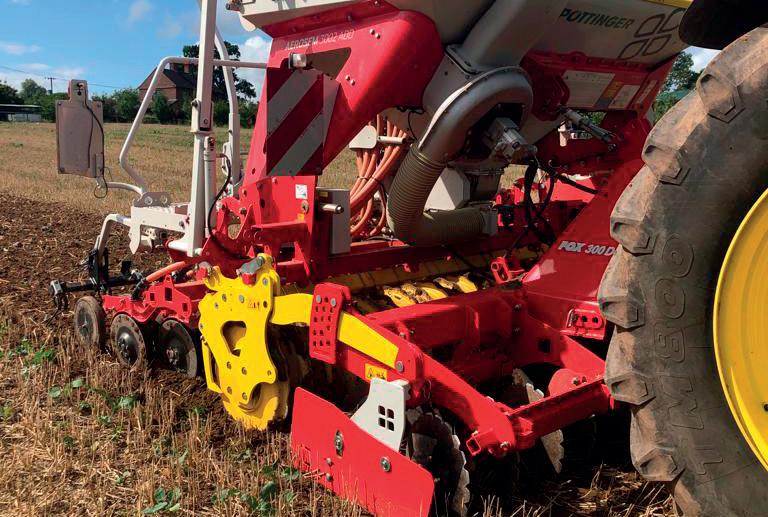
Five weeks later and the crimped covers have died back, the only green plants are the volunteer cereals. It is particularly pleasing to see the radish has been completely killed. In my non-crimped covers the frost has also done a decent job on its
own. However, there is still plenty of radish left alive and this will require at least three litres/ha of 360g glyphosate plus citric and fulvic acid to ensure its demise (£25/ha approximately).
On the crimped areas, 1.5 litres/ha glyphosate plus citric and fulvic acid should suffice to take out the volunteer cereals (£13.35/ha). You could argue that cost-wise it’s roughly the same, however, it will have enabled me to reduce chemical usage which will have its own benefits. Now back to work, oh look, it’s raining.
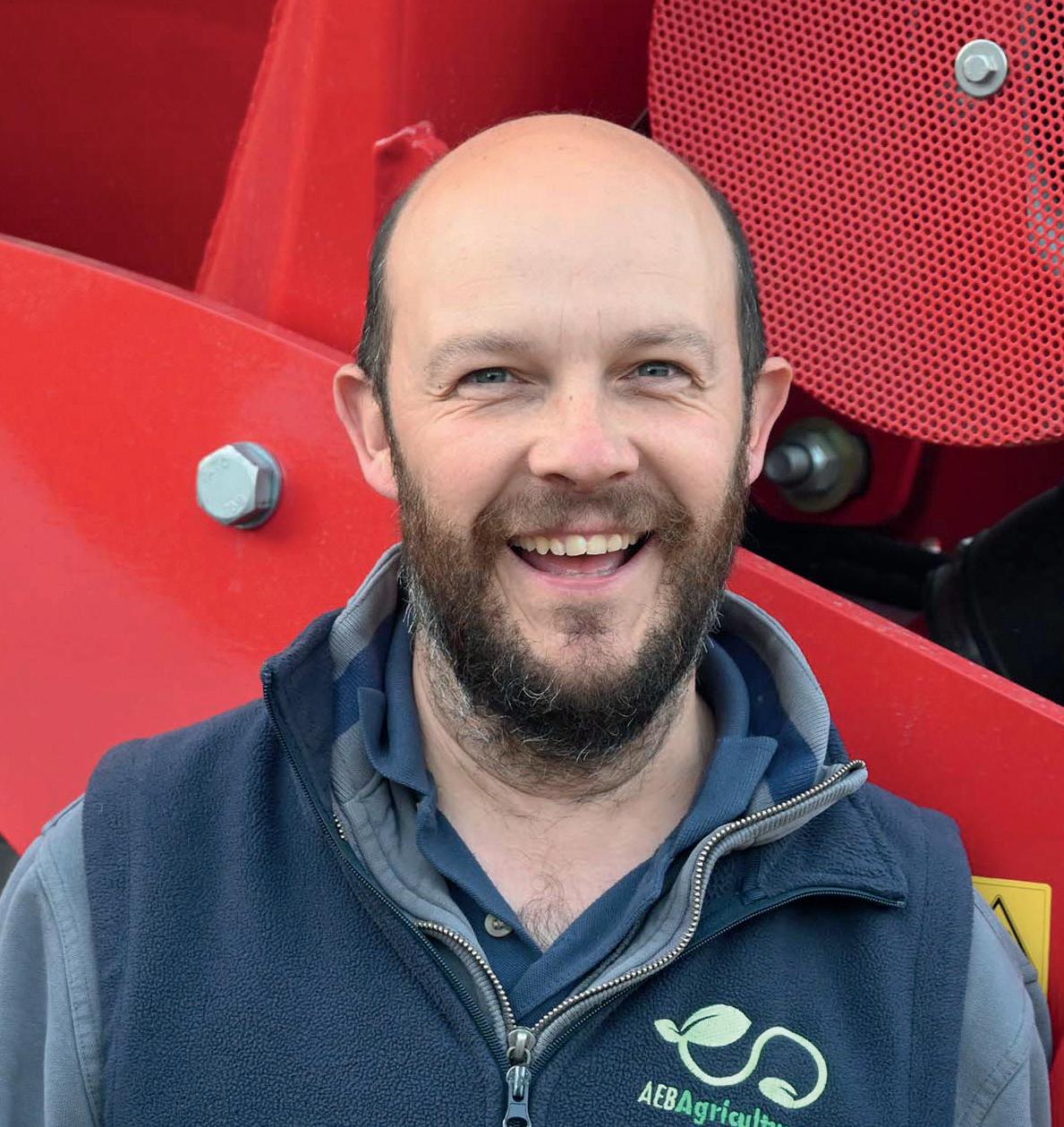
Safe, Simple, ReliableThe Ultimate Nutrition Package
Use YaraMila 52 S followed by YaraBela AXAN in your crop nutrition programme this season.

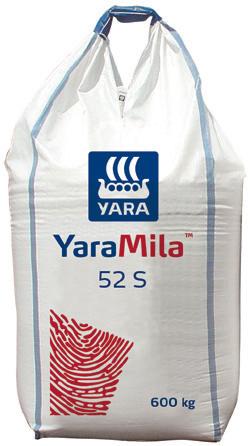



Both include essential sulphur for increased Nitrogen Use Efficiency, meaning less nutrient wastage and more yield for your money.
First apply YaraMila 52 S (20.6 - 8.2 - 11.6 + 6.5%SO3)
Followed by YaraBela AXAN (27% N + 9% SO3)

11 TALKING ARABLE FEBRUARY 2023
Yara UK agronomy.uk@yara.com www www.yara.co.uk
@Yara_UK
The cover crops were planted following wheat in mid-August.
OLLIEMartin
Ollie Martin is responsible for the arable and grain business enterprise across Bedfordia Farms’ 2,450-hectare operation, with 27,000 tonnes of grain storage, near Bedford. He studied agribusiness management at Writtle University College and has had previous farm management roles in Norfolk, Hertfordshire and Fife.
Aweek of hard frosts has made crop walking a much less laborious experience of late — without the 3kg of Bedfordshire’s finest clay clinging onto each boot.
As expected, grass-weed pressure looks like it could be as significant, as it has been for some time in the wheat, the dry autumn hindering efforts to create a stale seedbed and placing far greater pressure on a nonetheless robust stack and sequence of residual chemistry.
Where black-grass is concerned, resistance to ALS herbicides means there is little more to be done, the remaining options at this stage being to either live with it, or bring out the glyphosate.
the lack of slug damage. It has to be said that our no-tilled wheat does look happier with life than the wheat established after cultivations, most likely down to moisture retention at drilling. Purely aesthetic at this stage of course.
Keeping our feathered foes off the oilseed rape (OSR) is nearly a full-time job in the cold weather, with every available thing that flies, rotates, flashes, wails or goes bang, deployed to good effect.

Contrary to the AHDB Early Bird Survey, I am convinced, looking around, that there are significantly fewer OSR acres in the locality compared to previous years. As such, we appear to be hosting more than our quota of woodies.
Farm facts
rBedfordia Farms has more than 2,400 hectares of combinable crops including wheat, barley and beans

rThe business also provides grain testing in its on-site lab and has 27,000 tonnes of grain storage and processing capacity
rThere are 27 soil types across the farms, but most of the land consists of Hanslope clay, Faulkbourne and Stretham, which are classified as chalky clay, becoming waterlogged in winter
rThe farm utilises a number of precision technologies and has two pig units totalling 1,100 breeding sows


I am probably more concerned about brome, in particular soft bromes, which we seem to be seeing more of. Residual chemistry appears to do little to control it and with EMR resistance to ALS chemistry confirmed in the UK, cultural control and the use of herbicides with alternative modes of action in break crops are of the utmost importance. That reminds me to order some more plough metal.
The wheat itself looks splendid, with plant populations mostly about right and little to no sign of yellow rust or mildew at this stage.
One upside of the dry weather in the autumn is
Markets
With the cost of fertiliser remaining considerable and fungicide costs looking set to be circa 20% inflated on last year, I won’t be the only one carefully monitoring cost of production and estimating margin over input.
Moreover, as the Black Sea grain corridor continues to exceed expectations, wheat and oilseed markets are broadly bearish at the time of writing, which may lead to challenging times ahead. While fundamentally there is still profit to be made, cash management will be the most important factor for many arable businesses going
12 FEBRUARY 2023
Cash management will be the most important factor for many arable businesses going forward
OLLIE MARTIN
Keeping pigeons off the oilseed rape is nearly a fulltime job in the cold weather.
forward. I enjoyed a couple of hours of tyre kicking at LAMMA last month. The halls were full of kit that continues to increase in price at an alarming rate and, speaking to exhibitors, most new orders wouldn’t make it on farm within 12 months anyway.
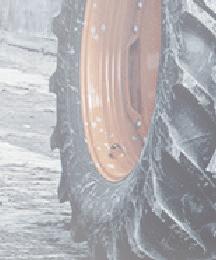


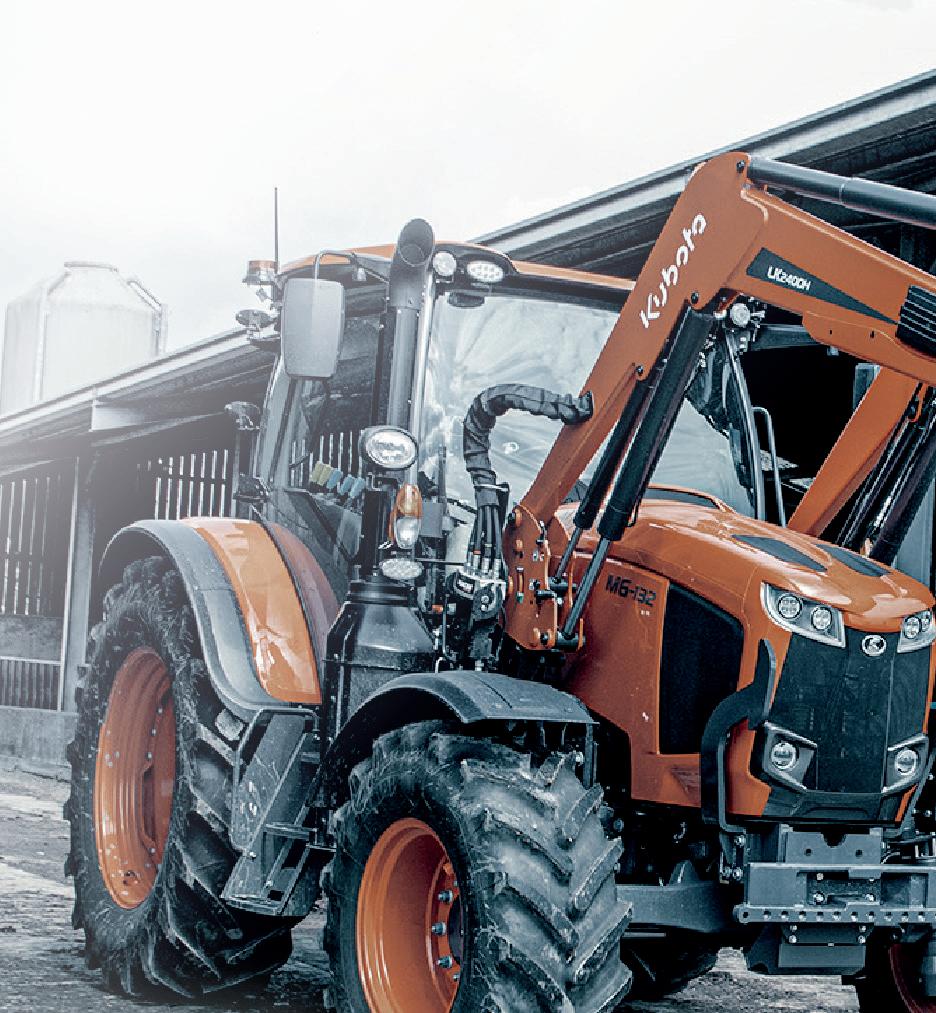

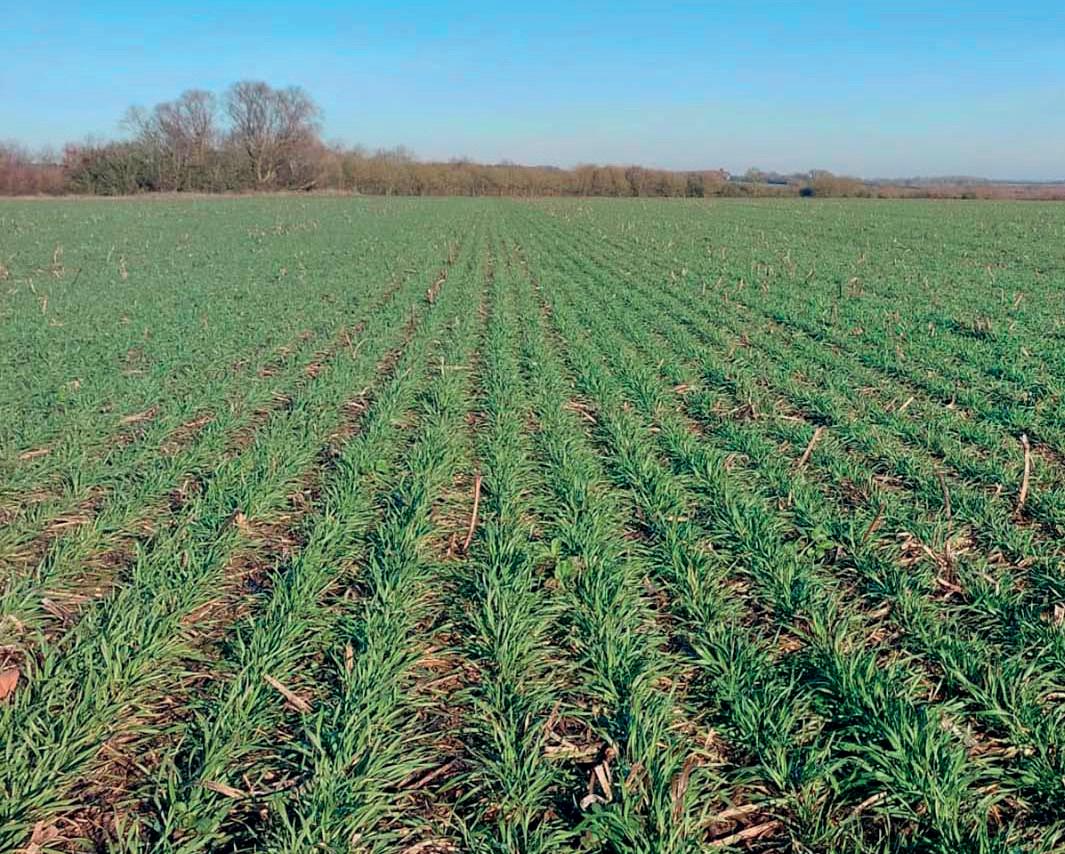
The cynical side of me wonders if the big players may just be shorting the market so as to justify higher prices. How much longer can ‘component supply issues’ caused by Brexit
and/or Covid-19 really be legitimised?

I have to say, I felt the show was a great improvement over last year’s Covid-19disrupted event, with the halls buzzing with conversation.
I can’t have been the only one to feel rather put out by the parking charge, however.

Back in Bedfordshire, we have been busy in the workshop giving the trailer line-up a



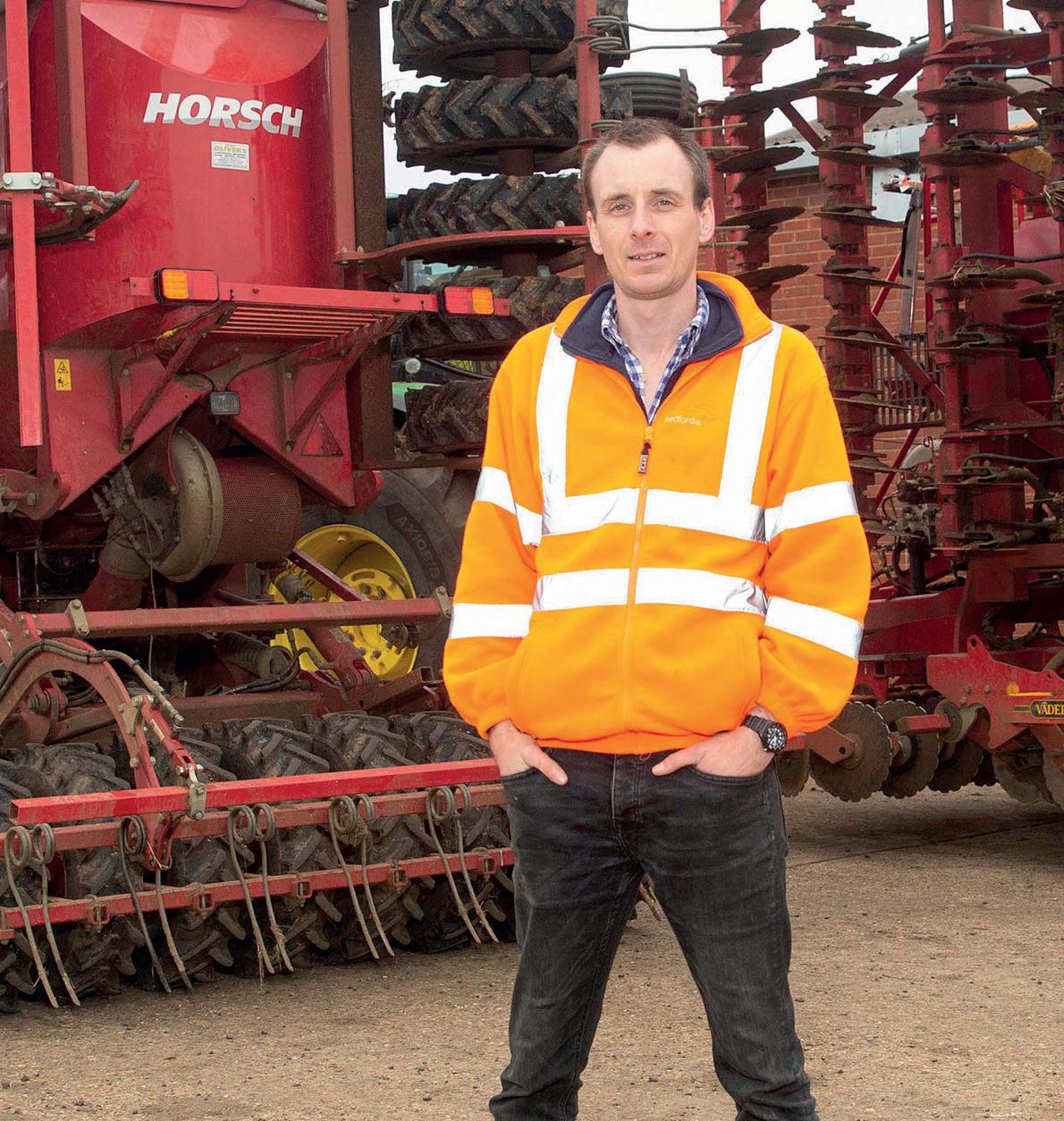
full medical ahead of brake testing next month.
In addition to inspection and adjustment of the brakes, we have also been replacing wheel bearings and slack adjusters, in addition to rewiring and replacing light fittings as required. I sleep much better at night knowing that anything turning out of the drive is safe to be on the road. I would strongly encourage others to follow suit.

TALKING
ARABLE
Stock available now – talk to your local dealer today. *Terms and conditions: Finance for business purposes only. Subject to acceptance and affordability checks. Applicant must be 18 or over. 5-year/3000 hour extended warranty. Promotion valid until 31st March 2023. 0% nance available on new equipment only. The equivalent of 2 monthly rentals due in advance followed by 22 monthly rentals. Finance is available on up to 50% of the RRP. The nance product offered under this promotion is Hire Purchase. First payment, full VAT and a documentation fee of £100 are due on signing. An option-to-purchase fee of £100 (plus VAT) will be collected with the nal payment. You will own the machine when all payments have been made. Alternative nance options are available. Terms and Conditions apply. Images are for illustrative purposes only. As funder we may pay a commission, fee or other remuneration to credit brokers who introduce business to us, please contact them if you require more information. Kubota Finance is a trading style of BNP Paribas Leasing Solutions Limited. Finance provided by BNP Paribas Leasing Solutions Limited, Northern Cross, Basing View, Basingstoke RG21 4HL. Registered in England No. 901225. One thing you can depend on. Save more with the smart, allrounder M6002 Series. www.kubota.co.uk Download brochure + + 0 2+22 xed monthly payments 1st Class nationwide dealer network % * 5YRS /3000 hrs Kubota CARE extended warranty * Terms & Conditions apply. Business users only.
Wheat plant populations are about right and there is little sign of yellow rust or mildew.
GREG Taylor
Weather oscillating from one extreme to the other is underlining the value of the steady improvements we are making in the resilience of our soils and systems through ‘better farming’ –in particular, less tillage, wider rotations and organic matter-building.
After the ridiculous mildness of November, and deep December cold followed by more unseasonal warmth, we have had plenty enough rain already. It turned cold again in mid-January, but only for a few days. And, before we know it, we will be into a spring that could well be bone dry again. Or very wet. Or very cold. Or all three, every other fortnight.
More than anything else, this puts the premium on having our eggs in several
Agronomist facts
JGreg Taylor has been an Agrii agronomist for more than a decade, servicing around 6,000 hectares of mainly combinable cropping across a broad range of soil types in Oxfordshire, Warwickshire and Buckinghamshire.
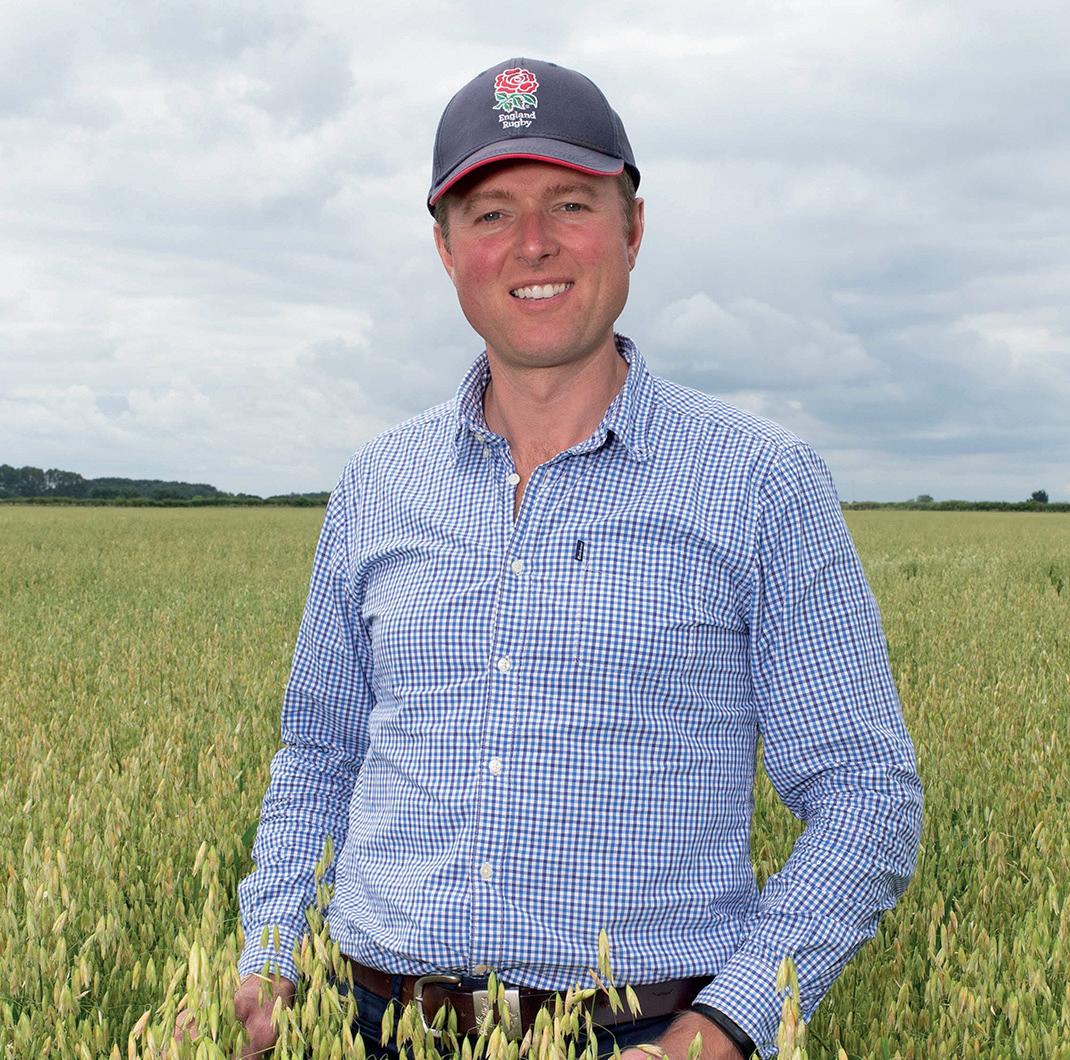
As a Harper Adams graduate, he has worked on farms in New Zealand and the USA, and is now responsible for the trials and demonstration work on the Brackley i-Farm.
He is particularly engaged with direct drilling, soil improvement and regenerative agriculture and is an ardent rugby fan and marathon runner in his spare time.
baskets – and very strong ones at that. Nowhere has this been more evident than with our cover crops. We have always valued diversity in our mixtures for the biology it builds. This season, though, broad species mixes have been as valuable for the assurance they have given us of decent development.
Especially useful have been mixtures of larger-seeded cereals that cope better with early dryness, mustard that always seems to take off well and vetches that come into their own later, combined with fibrous-rooting phacelia and deeper-penetrating linseed, tillage radish and sunflowers.
Well-grown though most of these covers were, the December cold opened them up nicely, which should help with the glyphosate that will be going on as soon as we can travel.
Leaving them to die back naturally and drilling ‘on the green’ seemed logical approaches in our original regen thinking. After several years of trial (and error) though, we know active, early destruction is crucial on our heavier soils to avoid wetness and trash getting in the way of drilling. So, the very last thing we need is to miss the early spraying boat.
Another boat we can’t afford to miss is early winter crop top dressing. All but our latest sown wheats are well-established and tillered. Considering the start they had, we have been remarkably fortunate with our OSRs too. And even the winter barley is standing up well to the waterlogging it never appreciates either.
Regardless of how much nutrition remains in our soils, the wetness has made it even more important all these crops get enough N in particular as soon as their growth picks up. That
way we have better rooted, stronger and heathier plants better able to use N more efficiently and stand-up to disease and pest pressures.
Early application is especially important with the slower-release urea we are having to rely on in place of AN these days. And – of course – in case everything turns dry again.
Not neglecting drainage while cutting back on cultivation has been the key to the much better ability much of our ground now has to withstand today’s weather pressures. Just like marathon running, it is a matter of building things steadily and getting the groundwork right. Which is why low disturbance metal at depth wherever and whenever necessary remains central to our heavy land recipe.
Bearing down hard on grass-weeds is paying valuable dividends too in a season in which drilling ahead of much weed emergence may bring many wheat crops down to earth with a bump.
Yet again, we have found we cannot rely on the weather to give us a decent black-grass flush ahead of drilling. Instead, minimal seed return, the least soil disturbance at drilling and robust chemical alongside cultural controls mean the earlier drilled crops our whole weed management efforts are aimed at allowing remain pleasingly clean as well as well-grown. Fingers firmly crossed.
With such wet soils and CSFB larval uncertainties, our fingers are also well-crossed for the OSR as it goes into its ‘make-or-break’ time. While we can’t do anything about these pressures, managing the pigeons that are so often the straw that breaks the camel’s back remain another immediate priority.
TALKING AGRONOMY 14 FEBRUARY 2023
In a season of weather uncertainty the value of cover crop diversity is evident






































Use plant protection products safely. Always read the label and product information before use. For further product information including warning phrases and symbols refer to www.agricentre.basf.co.uk. Revystar ® XE contains mefentri uconazole (Revysol®) and uxapyroxad (Xemium ® ). Revystar ® XE, Revysol® , and Xemium® are registered Trademarks of BASF. ©BASF 2023. All rights reserved.
I’ll be walking the elds in my boots at dawn, years of planning comes down to one day, and Revystar ® XE will protect my wheat.
TALKING AGRONOMY
BEN Boothman
The welcome mid-January spell of cold weather has helped to manage disease levels
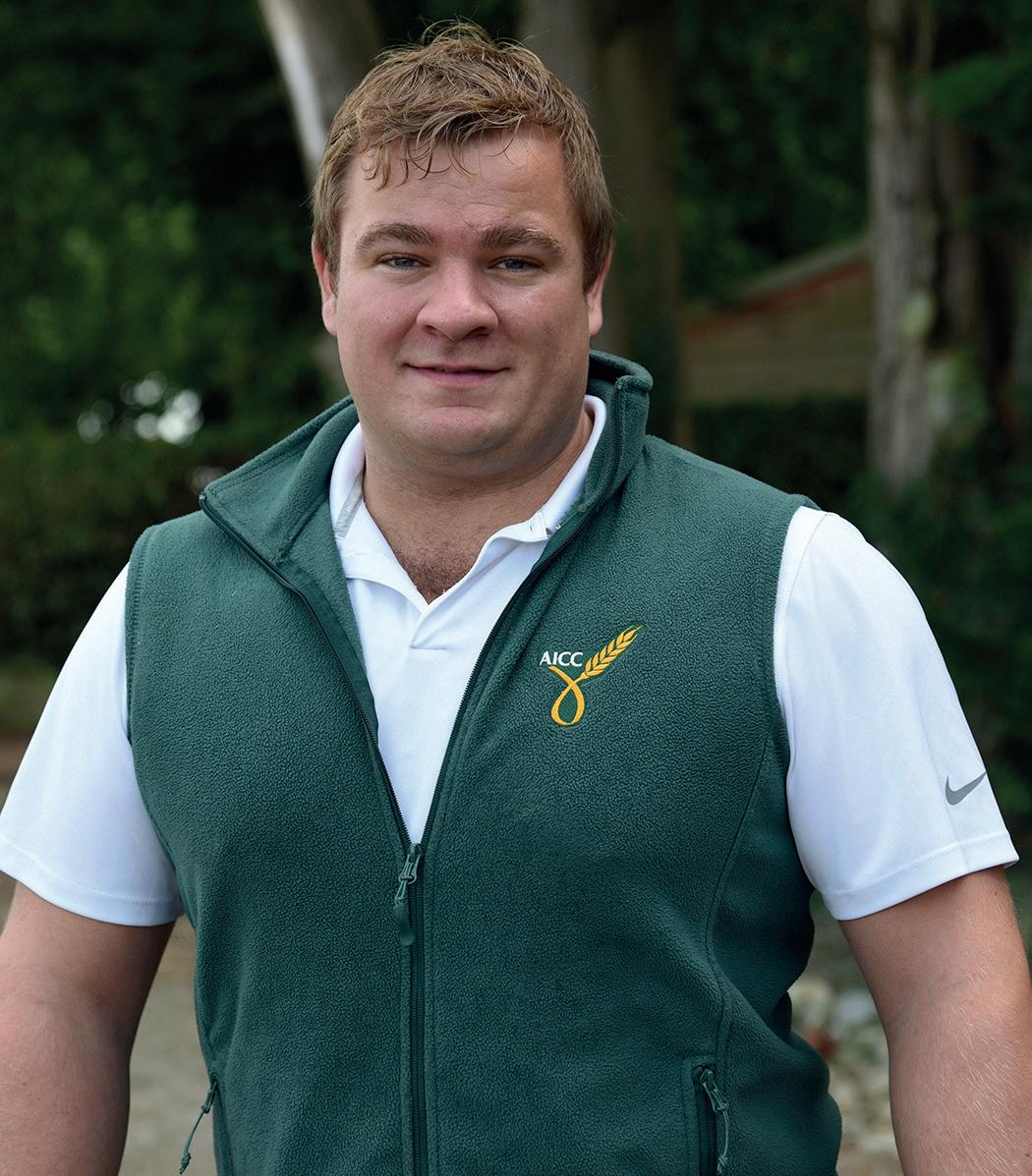
It has been a mixed bag here in North Yorkshire in terms of weather since the start of the new year.
Early January saw plenty of rain arrive, helping fields reach capacity and rivers rise out of their beds with an end result of some localised flooding.
Not long though had the retreat started when a cold snap appeared resembling that of its predecessor in December.
With nighttime temperatures averaging -6degC for more than a week and daytime conditions rarely peaking above freezing it seemed like a good chance to catch up on things post-Christmas in the cosy office.
This cold snap was welcome for the land but not the rugby fields. While crops had the chance to shed excess water, the concrete-like playing fields were condemned for playing on, with another postponed fixture to add to the tally.
Mid-January always marks that time of year
Agronomist facts
for the Association of Independent Crop Consultants (AICC) technical conference and, as with the previous two years, it has been delivered via an online format.
These can be quite hard to schedule and providing content interesting enough to stop people from drifting off to catch the second half of ‘Bangers and Cash’ can sometimes be a challenge.
I, however, have to applaud all who organised and presented over the three days, as I feel it was one of the best to date — both content and speakers ticked every box. It just means I’ll have to wait to see what the 1971 Ford Capri reached at auction at a later time.
All my OSR crops should have now received their Kerb (propyzamide) or Astrokerb (propyzamide and aminopyralid) applications and, if they haven’t, have only a few days left to do so.
While it has been a long time coming, effects on grass-weed and broad-leaved weeds are now starting to be apparent.
Many grass-weeds seemed to be shrugging off the treatment, but over the past couple of weeks plants are wilting off and even those healthier ones are displaying the bulbous base like a spring onion, which is a common sign that the end is near.
The recent colder temperatures accompanied with a few pigeons have helped thin some of these gargantuan crops out and is preparing them well for when early spring approaches.
Disease levels are still low and again have backed up my decision to not apply prophylactic fungicides to many of my OSR crops.
Barley crops in some cases would benefit from being silaged. Mildew crept into some of these crops during late autumn but Jack Frost got his memo from Mother Nature and has done a good job at naturally keeping on top of this sometimes overlooked disease. I will wait until my next article to mention nitrogen; my only advice at the moment would be, go on holiday.
Winter wheats are all looking near-perfect, with even those late-sown crops following potatoes or beet bringing a smile. Most crops have tillered well and look full of potential and, for the time being, are quite happy to sit and wait for the warmer temperatures to arrive.
The cold weather has helped manage disease levels, although septoria is easy to find in most crops and, as expected, more notable in those lower-scoring varieties which still seem to find their way into our cropping plans. The early spring weather always plays a big part in disease levels as this is the catalyst for disease reduction or multiplication.
Soil sampling through our precision mapping service Soil Advisor has gone from strength to strength. The hard ground conditions have allowed the buggy to be out and about earlier than previous years and make a good start to this spring’s campaign.
16 FEBRUARY 2023
JBen Boothman is an independent agronomist and member of the Arable Advisor Group and the Association of Independent Crop Consultants (AICC), covering Yorkshire and the North East. He is BASIS, FACTS and BETA qualified and studied for a degree in agriculture and crop management at Harper Adams University.
AG-LIME CALCIPRILL
The choice is clear
Maximise nutrient use efficiency by correcting soil pH to the optimum ahead of Spring fertiliser applications.

Fast-acting Calciprill is a highly efficient alternative to agricultural lime that will save you money and improve crop performance by making sure expensive NPKs are fully available to the crop.


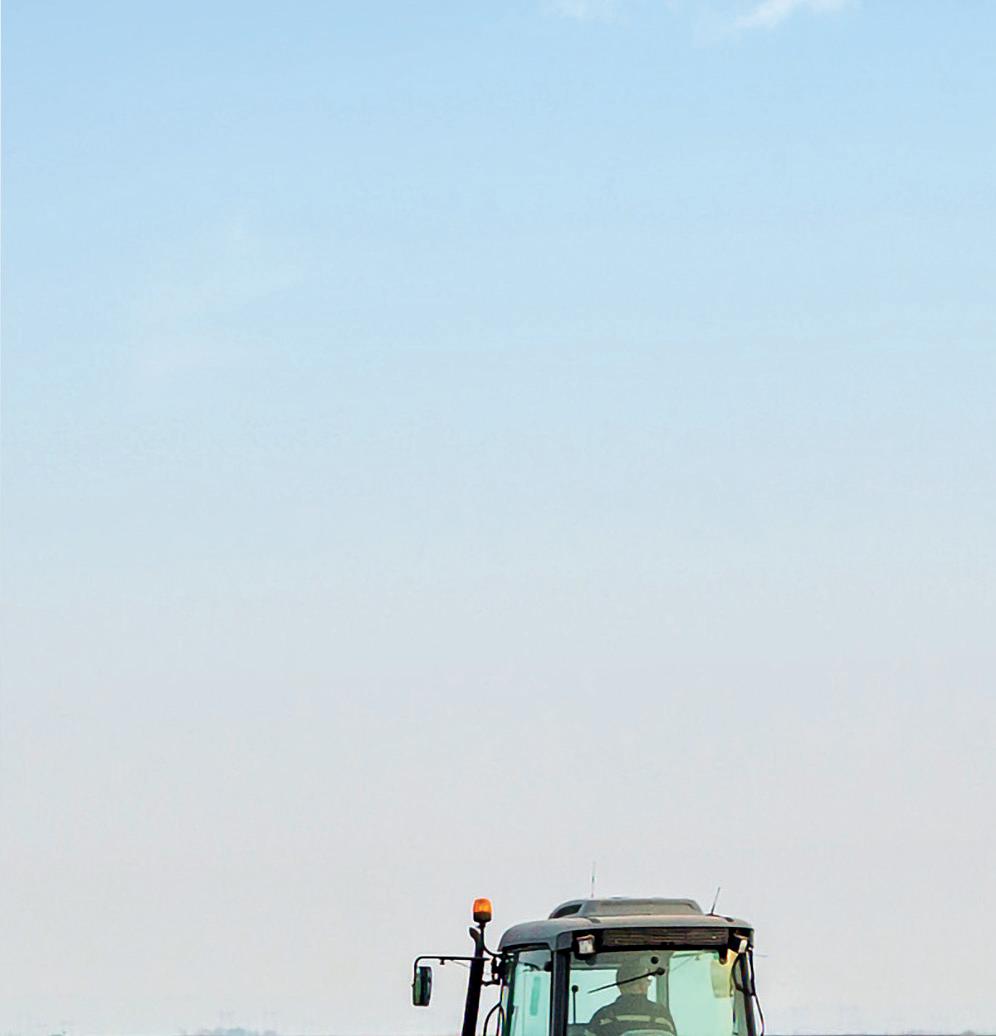
For clearly better results, choose Calciprill.
For more information: Contact David McLellan on 07710 712030 or visit www.omya-agriculture.com

• Precise
• Fast acting

• Convenient
• Efficient
FOR A MORE PRODUCTIVE WORLD
Calciprill
DARRYLShailes
We had sharp frosts just before Christmas and the pond froze over. The swans had fun, walking around on the ice.
After the frost came the rain, and we’ve had a mini flood, with just a bit of water in the garden but it soon went, so no opportunity to get the canoe out and paddle across the meadows that run up to the Waveney.
However, the rain was very welcome, and speaking to many growers, the pumps have been able to run and the reservoirs are filling up well.
That’s the first part of the puzzle hopefully sorted, as over in the East where I am based, no water for irrigation means no potato crops.
The area planted will still be down, with some growers pulling out of potatoes all together. The cost of growing potatoes is so high now that good returns are challenging and yields must be high even to stand still.
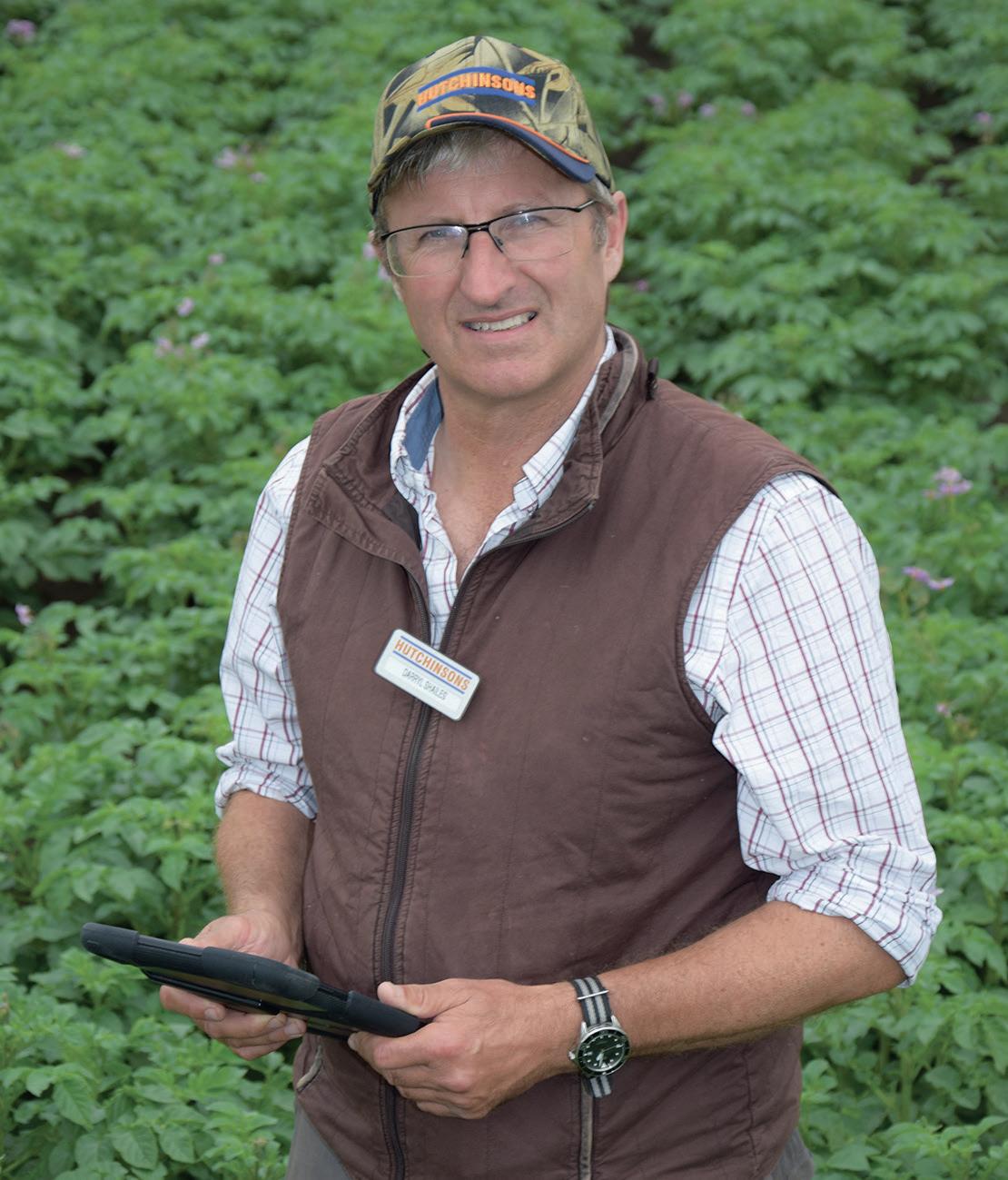
Last season was a very low season for blight and I’ve not heard of any in stores, although there are plenty of other problems.
As always blight pressure next season will depend very much on the weather but hopefully background inoculum will be pretty low from volunteers due the lack of blight in 2022.
One thing we need to keep an eye on is the announcement that Danish growers have got a strain of blight that is resistant to the CAA group of chemistries that include benthiavalicarb, dimethomorph and mandipropamid.
EU_41_ A1 has been around for a while in Denmark, Holland and Belgium but has not yet been found in the UK. However, it has only just been confirmed that some strains of the genotype are resistant to CAA chemistries.
Danish growers have not been using multi-site chemistry such a mancozeb for a number of years now, initially due to the high taxation based on the amount of active ingredient being applied and now the EU ban, so this puts pressure on the single site actives left.
Also, another factor could be that in many European countries the blight strategy has been to run with sequences of blight products unlike the UK where generally the strategy is to alternate actives and mix actives when the risk is high.
This combination of the ability of Phytophthora to generate new genotypes and the way it is controlled means it’s probably inevitable that this should happen, as we have seen changing genotypes in the EU with some
showing resistance to different chemical groups for some time now.
Initially it was with Blue 13 to phenylamide such as metalaxyl, then fluazinam and Dark Green 37. Now with EU_41 to CAAs, we need to be very careful to manage the remaining active we have left with strong anti-resistance blight programmes.
This highlights the importance of multisite chemistry such as mancozeb, and we have to hope HSE feels the same, but also the need for the industry to support the genotyping in the UK that was part of the ‘Fight against Blight’ campaign under the old AHDB Potatoes.
There has been some frost damage reported in the beet crop left in the ground after the pre-Christmas frosts, and as I’m writing in mid-January this won’t help any fields that are still to be lifted.
The lack of leaf canopy to help protect the crowns due to the combination of beet moth damage and cercospora coming in late again has not helped.
It’s important that we recognise the value of canopy cover in late-lifted crops and maybe we need to come up with some different strategies to ensure as little damage from unpredictable frosts and these new ‘continental’ problems in the future.
If we had a more normal English summer, for example, cooler and wetter, it would probably be different, but will we ever have one of those again?
18 FEBRUARY 2023 TALKING AGRONOMY ROOTS
We need to be very careful to manage the remaining blight actives we have left
JDarryl Shailes is root crop technical manager for Hutchinsons, with a nationwide remit. He has been working in potato agronomy for more than 20 years.
Agronomist facts
Harvest weed seed control could open a new window on grass-weeds that are tricky to control. Tom Allen-Stevens follows the progress of Driver Farms in Suffolk, one of three UK arable businesses taking part in farmer-led trials.
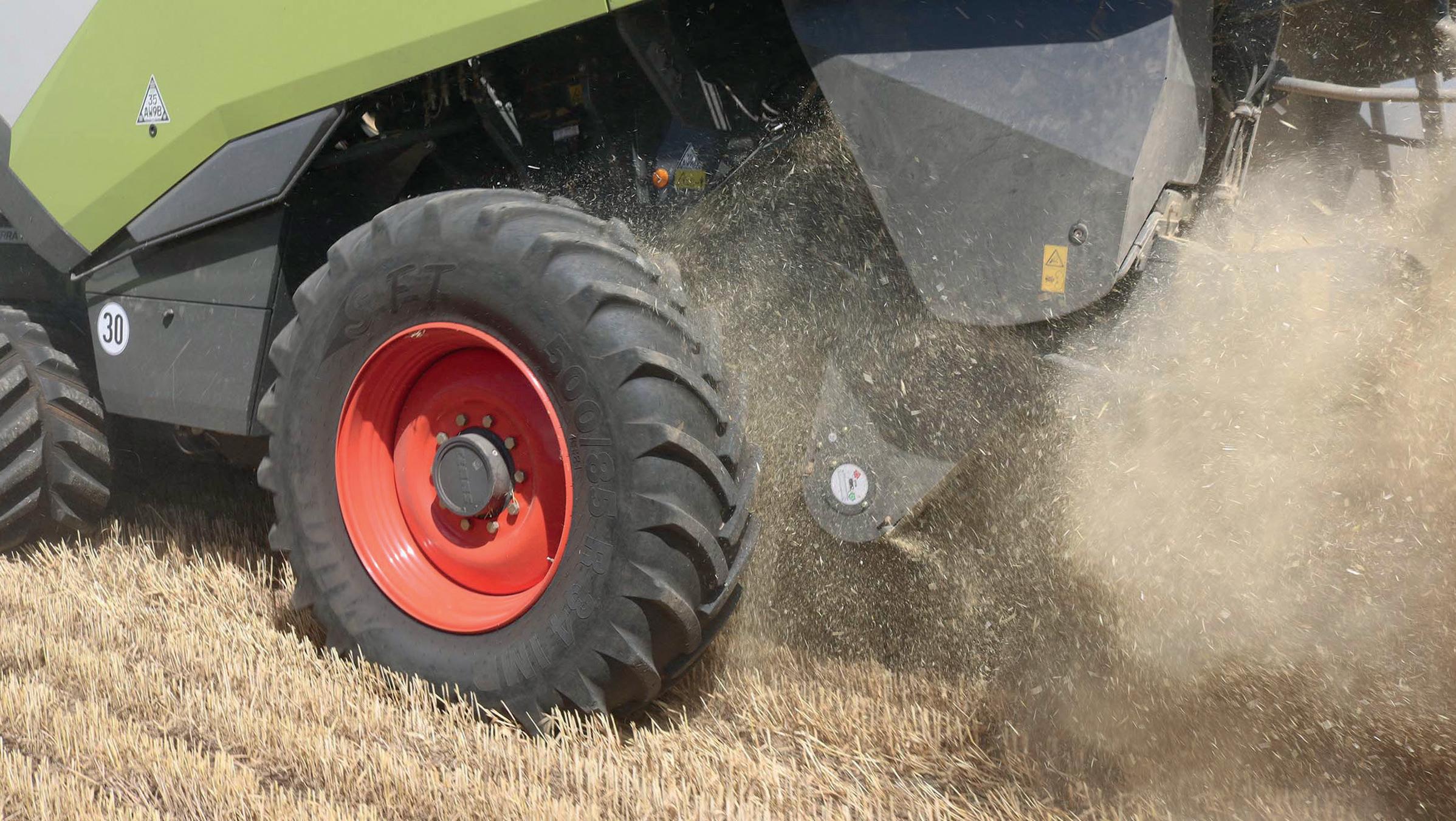
SCUs putting weed seed woes through the mill
Ablazing
Instead, it was stood up in the yard, with overall-clad legs visible at the rear of the combine evidence that the engineers they belonged to were dealing with a retrofit issue with its new seed control unit (SCU).
Adam Driver, who was
looking on at the time, did not appear too concerned – the excitement of discovery is worth the teething issues that pave the path towards it.
Chaff spreader
“What I wanted to know is whether the SCU will address the stripes of black-grass we see in the fields which seem to follow the chaff spreader,” he says.
“We have a controlled traffic farming (CTF), no-till system. Controlling the weed seed left on the surface is one of the main issues we have to address. It’s not because of CTF that this is an
issue, but it shows us very plainly where and how it is happening.”
Eliminate the seed that

19 GRASS-WEEDS TECHNICAL FEBRUARY 2023
26 Getting PCN traps crops off to the best start 28 Managing the PCN threat without nematicides 32 Recommended Lists get a small but mighty boost 36 Sugar beet will need IPM weeds approach 38 Careful use of post-ems can counter ryegrass 42 Study gives oilseed rape confidence boost 44 Inoculate to accumulate with wheat 46 Delving into septoria defence collapse Also in this section
hot day back in early July should have seen Driver Farms’ Claas Lexion 8800 combine harvester cutting swathes through the farm’s Electrum winter barley.
X
PICTURES: BOFIN FARMERS
Driver Farms’ Lexion was the first Claas combine in Europe to be fitted with the Redekop SCU.
Controlling the weed seed left on the surface is one of the main issues we have to address
ADAM DRIVER
TECHNICAL GRASS-WEEDS
comes through the chaff spreader and you reduce the problem considerably.
That is the theory being put to the test with this, the first Claas harvester in Europe to be fitted with the SCU from Canadian manufacturer Redekop. Seated at the rear of
the combine under the chopper, it mills the chaff to a fine dust, rendering up to 98% of the seed that passes through it unviable.
Potential
But little is currently known about the potential of harvest
weed seed control under UK conditions.
Hundreds of SCUs are used successfully in Canada, the United States and particularly Australia, where public-funded
The technical challenge of pulverising problem weeds
JThe Redekop SCU is a step on from an integrated unit developed by researchers at the University of South Australia, funded by the Grains Research and Development Corporation.
The chaff stream is separated from the straw and passes from the sieves into the SCU that is fitted below the straw chopper. The mill operates at 2,850rpm, flinging the chaff at 400kph through two rotary sections of columns and three stationary sections.
It is this action – hitting a weed seed hard enough at least four times – that researchers have found renders up to 98% of it unviable. Tungsten-carbide coated mills on the Redekop SCU are reversible to ensure a long life.

Redekop co-owner and president Trevor Thiessen explains the SCU was developed first for John Deere combines. He says: “Units can be retrofitted and are also now available for newer Case IH and New Holland harvesters. This is our second season working
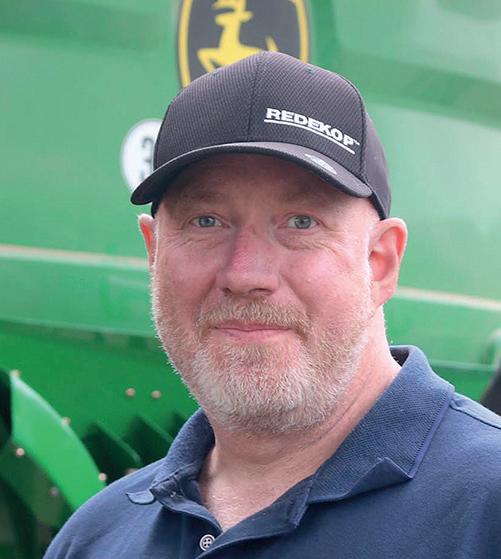
with Claas models and Driver Farms’ Lexion 8800 is the first Claas combine in Europe to be fitted with an SCU.
“In our line of work, teething issues are normal as we release products on new combine models. Sorting them out is what we do, which is how our equipment has evolved.
“Together with Oria Agriculture, our export partners, it’s always been our priority that any issue that arises as we work in a new market doesn’t become a problem. But the issue with the European version of the drive on Adam’s combine was unexpected,” he admits.
Design difference
The drive for the SCU comes from a pulley that drives the straw chopper. Slight differences in pulley design between North American and European models meant it did not run correctly when the combine was fired up and put to the test.
The problem was quickly spotted and a trans-Atlantic flurry of activity saw Redekop and Oria work closely with Claas UK Eastern and Claas
Manns to ensure Driver Farms’ harvest was back on track with minimal delay.
“The support from Claas has been awesome. This was the first of their combines in Europe to get going, so we rolled the modification out to the 20 other machines with a trial unit,” adds Mr Thiessen.
Unlike with other Redekop SCUs, no change was needed to the rear axle on the Claas to accommodate it, although the unit cannot be taken out of operation.
So how did it perform in the field? It was Carl Driver who took the Lexion fitted with the SCU through its first field of winter barley at a brisk 7kph.
“I like to push the pace as much as we can and was concerned the mill would slow us down. But we averaged 50 tonnes per hour, pushing up to 65t/hour in places. It was a dry crop of Electrum, yielding 7.5t/ha, but that’s a good throughput,” he says.
The rest of harvest was much the same, he adds, with the extra lug needed for the
work has explored its effectiveness. The increasing prevalence of herbicide-resistant blackgrass and now ryegrass, as well as meadow brome and concerns for newcomers such as rat’s tail
SCU rarely slowing down the harvest operation.
“It choked a bit going through some patches in the Blazen oilseed rape, but that was more to do with the crop than the combine. Despite reasonable grain yields, straw yields were low, so we don’t feel we have a fair idea of typical power requirement.”
In the sort of conditions and level of crop residue typical in UK cereal crops, an extra 85hp is needed for the SCU, according to Mr Thiessen. This can reduce combine speed by 10-12%, although in drier conditions this may be closer to 5%.
Results from 2021 trials on the NIAB farm at Cambridge with an SCU fitted to a Case IH 7230 suggest it uses 10% extra fuel. Feedback from customers worldwide suggest a similar figure, adds Mr Thiessen.
Like Redekop’s MAV straw chopper, the SCU spreads residue across the full combine cut width, although operates independently, so chaff can be milled and straw swathed, for example.

20
FEBRUARY 2023
over the page.
Continues
I like to push the pace as much as we can and was concerned the mill would slow us down TREVOR THIESSEN
The SCU spreads residue across the full combine cut width.
LET SMART SCIENCE GROW YOUR PROFITS
MAXIMISE YOUR PROFITABILITY WITH INDEPENDENTLY PROVEN SCIENCE.
Available as Limus® Care for granular urea and Limus® Perform for liquid fertiliser (e.g. UAN), Limus® is a dual-active, innovative urease inhibitor. Rigorous ADAS Agronomics trials and BASF testing prove it’s an innovation that works. By reducing ammonia losses, Limus® delivers equivalent yields to AN and increases the yield of urea/UAN fertilisers by 5%.***
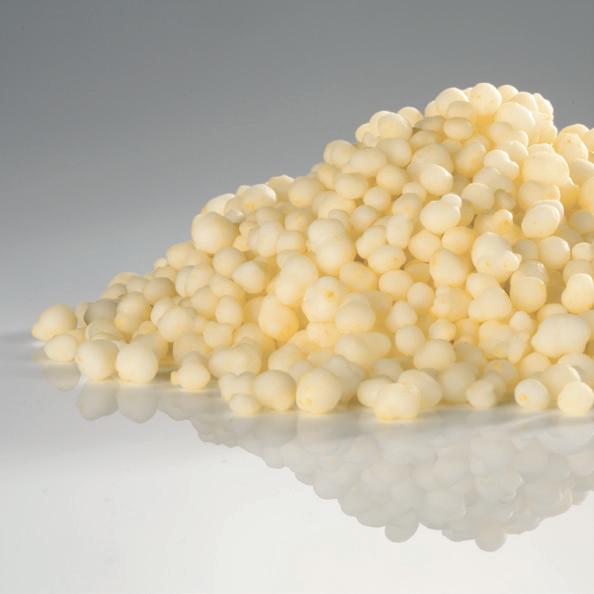
Find out more about how Limus® can help your profits grow, visit agricentre.basf.co.uk/limus
Limus® Perform +0.23t/ha yield +£39/ha MOIC (ADAS, 6 trials)*
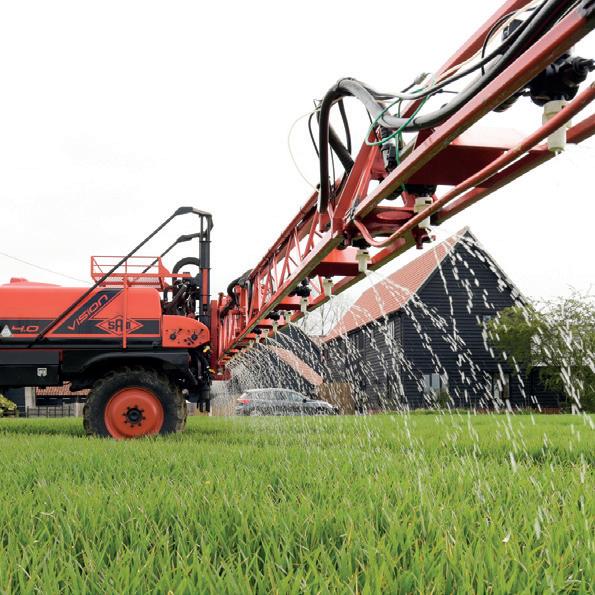

Limus® Care
Equivalent yield to AN (ADAS, 15 trials)**
*�ADAS Agronomics tramline trials with farm standard N rates and splits (BASF funded): +0.23t/ha average yield benefit of Limus® Perform + liquid fertiliser vs untreated liquid fertiliser, MOIC (Margin Over Input Cost) based on wheat at £195/T (N=6, winter wheat, 2019 & 2020) | Equivalent average yields of Limus® Care vs ammonium nitrate (N=15, winter wheat & winter barley, 2020 & 2021). ***BASF trials: +5% compared to standard urea/UAN (N=107, range of crops, BASF). Limus® contains NBPT + NPPT. Limus® is a registered Trade mark of BASF.
Urease Inhibitor Limus®
TECHNICAL GRASS-WEEDS
fescue, have prompted growers to call for efficacy trials here in the UK.
Redekop has responded and committed to support a two-year grower-led study, with NIAB and the British On-Farm Innovation Network (BOFIN). Driver Farms in Suffolk is one of three businesses in England taking part in the trial to test the SCU under UK conditions and first year results are looking promising.
Based south of Bury St Edmunds, Mr Driver runs the business in partnership with his parents, Carl and Felicity, farming 2,000 hectares of arable under various agreements, most of which is on Hanslope series chalky boulder clay.
Driver Farms is a member of Camgrain and crops are grown as much as possible for local consumer markets. These include Group 4 wheat for Shredded Wheat alongside Group 2 milling varieties, while barley choice leans towards
what’s favoured for maltings nearby. Oats, oilseed rape and beans complete the rotation.
“The move to no-till started about 10 years ago,” says Mr Driver. “We wanted to move away from a system previously based around the Vaderstad TopDown, mainly to improve soil health. But also the chemicals had stopped working on our black-grass – it’s all RRR resistant – and success of residual herbicides is highly dependent on the season.”
Rotation
Keen to bring in more cultural controls, spring barley and oats were introduced about five years ago. The rotation is kept flexible, pushing the worst fields for black-grass into the spring cropping window or to laterdrilled autumn breaks.
Most recently, hoeing crops in March with a Claydon Terrablade is achieving good, late-season control.
JThe results from the first year of trials at Driver Farms confirm what Adam Driver had seen in the field.
Weed counts taken by Will Smith of NIAB in the field in late October showed that for both black-grass and meadow brome, germination follows a classic ‘bell curve’, tracking exactly the combine runs in the CTF system.
“Over 60% of the meadow brome and 40% of the blackgrass was found directly behind where the combine had passed, showing it puts the seed into the chaff stream,” he says.
“This is really important in no-till CTF systems because there’s a cumulative effect of this seed rain on the soil surface year after year.”
Mr Driver collected seed heads standing in his wheat crop just before harvest
and sent the ears to NIAB for analysis.
Harvest
“We generally believe no more than 10% of black-grass seed would be available for harvest weed seed control in a wheat crop, although we’ve hardly any
Mr Driver is convinced the no-till, CTF regime is also better for black-grass. It is a 36-metre system, matched to the combine header width of 12.3m, with a 12m Amazone Condor taking over recently from a Horsch Sprinter for crop establishment.
The narrow chisel openers work alongside a 12m Horsch Avatar with its single disc coulter, and the two direct drills bring him the flexibility and results he needs for both
successful establishment and minimum soil disturbance.
“There’s nowhere near as much black-grass as there was when we were moving the soil and we’ve gone back to drilling in September,” he says. “But all your control happens on the surface – it’s a system that’s increasingly reliant on glyphosate.”
Regenerative agriculture systems are particularly vulnerable, according to NIAB, as a result of ‘weed seed rain’. This is the cumulative effect of weeds shedding seeds year on year in the same place that don’t get buried. The concern is this could lead to resistance to glyphosate, as has been seen in Australia.
Mr Driver says: “It’s not just black-grass. We now have problems with sterile brome and meadow brome’s creeping in – these grasses are potentially worse in no-till and we simply cannot afford for them to get as bad as the black-grass.”
The two-year trial with the
data for UK conditions to back this up,” says Mr Smith.
“But Adam’s results were staggering – 38% of his blackgrass passed through the SCU, according to the samples he took.

“Assuming 98% control, that will make a significant difference
to the seed return, especially to that critical width behind the combine. You won’t notice a difference in one year, but over time it helps make the CTF system far more sustainable from a weed-control perspective.”
This had become a concern for Mr Driver.
He says: “We have been worried about the build-up of black-grass in the strips behind
22
FEBRUARY 2023
Where the weed seed rains, it stores
There’s nowhere near as much blackgrass as there was when we were moving the soil
ADAM DRIVER
Assuming 98% control, that will make a significant difference to the seed return WILL SMITH
Redekop SCU involves taking weed counts at heading, with another count taken by Mr Driver just before harvest, to assess how much of the grass-weed population passes through the mill. A weed seed germination count in the following crop completes the picture on the SCU’s contribution to overall grass-weed control.
While the unit is constantly engaged on this first version of the SCU for the Claas combine, it can be disengaged with a simple clutch mechanism on other combines. This is the case on the other two trial units within the UK farmer-led trials.

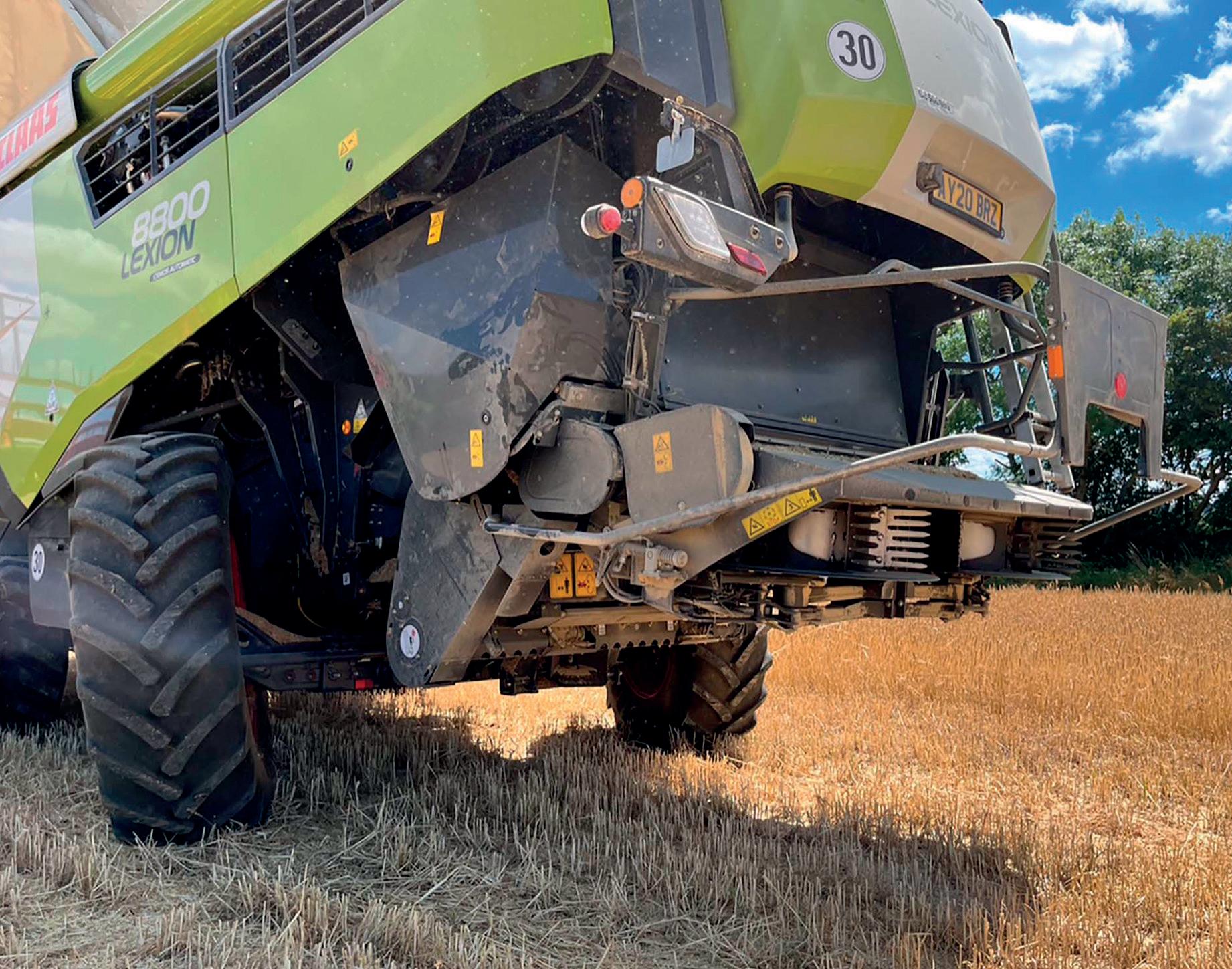
Jake Freestone, farm manager at Overbury Enterprises, Worcestershire, has a Redekop SCU fitted to his John Deere S685i combine and a bit of a problem with meadow brome. In Warwickshire, Velcourt farm manager Ted Holmes is running one on his New Holland CR9.90 and for him, ryegrass is enemy number one.
Grass-weed emergence across combine width
the combine, so it looks as if the SCU is generally doing what we want it to. The other difference has been far fewer volunteers in the following crop. This is important for malting barley following wheat, and for milling wheat after spring barley.
“We don’t have any OSR this year, but another plus will be
no lines of volunteers where we combine the previous crop with the SCU – that’s a potential saving of £15/ha we hadn’t expected,” he adds.
Benefits
Overall, it’s too early to say whether the benefits stack up against the costs. Mr Driver will
be closely monitoring results for a second year. But he’s ‘7580%’ happy, he says.

“You can’t see the difference with the black-grass, although you can with the volunteers. So it’s useful to have the data showing how it’s helping the black-grass. Also, very

importantly, I hope it’ll help us see off any burgeoning brome or ryegrass problems, being proactive rather than reactive.”
For more on the trial and results from this harvest, see the harvest weed seed control project on Trinity GFP (global) or visit bofin.org.uk
23 GRASS-WEEDS TECHNICAL FEBRUARY 2023
4m left 2m left Centre 2m right 4m right 70 60 50 40 30 20 10 0 SOURCE: NIAB, 2022, Driver Farms, Suffolk, on October 6, 2022 Black-grass Meadow brome Weed density across combine width (%)
MORE
ONLINE
Adam Driver
The effectiveness of the Redekop SCU is being tested on farms in Worcestershire, Warwickshire and Suffolk.
Maximising efficiencies managing farm risk with
In an era of extreme price volatility, BASF explains how its cloud-based digital tool, xarvio Field Manager, can help growers manage their inputs more efficiently to minimise risk and provide agronomic insights for crops.
Designed to provide datadriven crop modelling, the tool enables growers to vary their seeding and nitrogen rates to get the most out of costly inputs and assist decision-making on-farm, says BASF’s agronomy manager Richard Guest.
He says: “It also helps to identify less productive areas of land and assess their suitability for stewardship schemes.”
Having used xarvio Field
Manager since 2020, David Hurn, Eastgate Farm, north west Norfolk, explains how the tool has helped inform decisions on-farm to maximise efficiencies.
Mr Hurn says: “After trialling the system with just one field, I
EFFICIENT DOCUMENTATION
Mr Guest says: “The easy to use Field Notes tool within xarvio Field Manager will have a value whatever the farm type and comes into its own in the field, helping with documentation and recordkeeping.
“Growers can create notes with the app on their smartphone. This means written notes, voice memos and photos can be combined with a precise location pin to create a permanent record of activities or areas of interest in a field, such as crop development and variability, weed patches, or wet areas.
“This phone app feature is also useful for growers using variable rate mapping, as ‘live’ notes can improve the precision.”

Mr Hurn explains how he uses Field Notes to provide evidence for environmental land management schemes.
“This year we are in the Sustainable Farming Incentive Mid-tier scheme, which means we must keep records of establishment for inspection.
Geolocated
“I can walk into a field, take a photo on my phone, which will be time and date stamped, geolocated and uploaded to xarvio Field Manager, which saves time.”
Mr Guest adds: “It’s also a really efficient way for keeping communications open between the farm team as these notes can be easily shared through the cloud-based system with other users.
now use it across our 166-hectare arable farm.
“The key for me was the ease with which I set up the system and got it running. I had the whole farm mapped out in a day and could see it on the app on my smartphone, my tablet, the farm office PC and share this information with colleagues.
“This season I’ve used
prescription mapping to drill all my wheat and will be applying all my nitrogen variably.”
BASF grower community manager Alice Johnston explains how the wealth of data available from the digital product helps growers.
Biomass maps
She says: “Xarvio Field Manager provides in season biomass maps from satellite imagery so growers can understand their crop development and see infield variability.
“It also provides Powerzone maps which are based on up to 15 years of historic satellite biomass data, with the data consolidated to show average productivity of the field.
“It’s clear that using the wealth of information xarvio Field Manager brings together gives growers the edge, whether they just use it to streamline
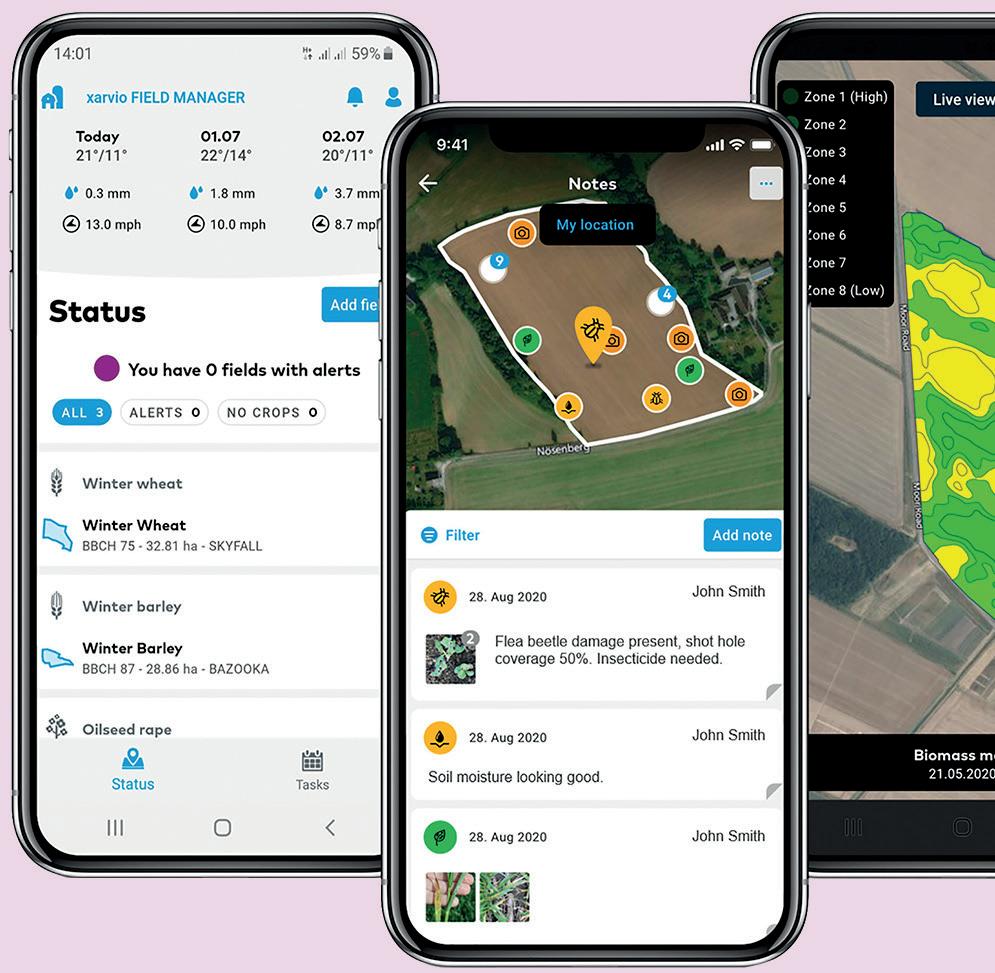
record-keeping or for prescription mapping. We therefore encourage growers to download the app to help achieve efficiencies across the farm.”

24 SPONSORED CONTENT FEBRUARY 2023
The key for me was the ease with which I set up the system and got it running David Hurn
and xarvio
“Growers are also able to import their own data, such as yield and soil maps.
“This allows growers who have spent the money on inputs to be confident they are used in the right place and most efficiently.”
And Field Manager helps make ‘good decisions’, increasing our margins per hectare, adds Mr Hurn.
By using the data within xarvio, targeted application maps for seed and fertiliser can be created to minimise inefficiencies involved in their application, Ms Johnston says.
“Differences in soil characteristics strongly influence the germination rate and yield potential within a field.
“Field Manager enables growers to create a prescription map for seeding where the base layer can be a yield map or a Powerzone map, or these data layers can be merged to create one base layer.”
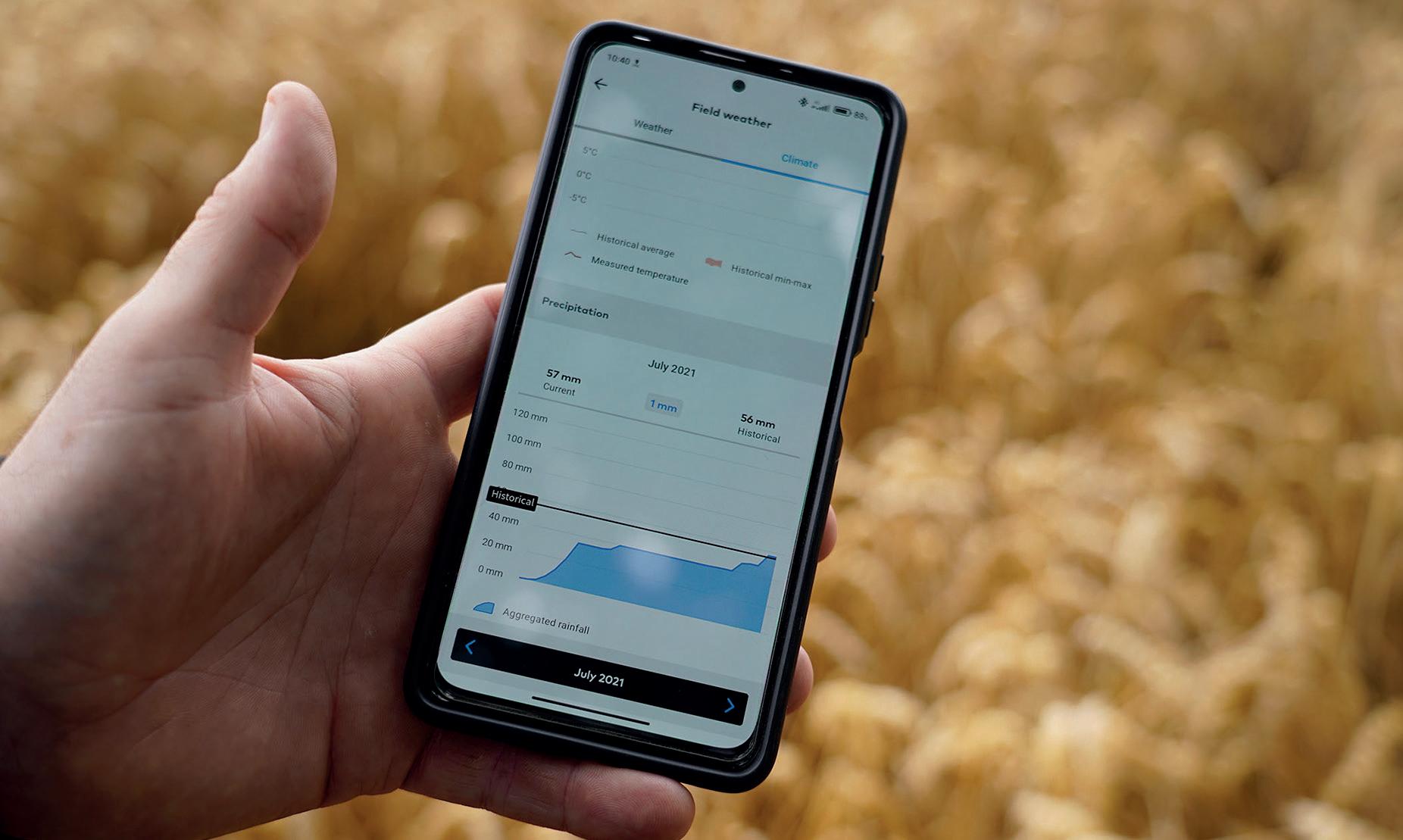
Mr Guest adds: “Growers are able to decide on the base rate for the field and vary it up or down on the prescription map.”
And when it comes to drilling, ‘it’s all about evenness’, which starts with variable seeding, adds Mr Hurn.
“We import yield information into xarvio and use these maps as a base layer to vary the seed rate.
“Our base rate for the wheat was 180kg/ha last year, with areas down to 160kg/ha, but in heavier parts we were up to 240kg/ha.”
With fertiliser costs rising, Mr Guest explains how utilising the data within xarvio has helped to
create targeted application maps, to allow for more efficient application.
“Growers are able to decide on the dose rates and where and by how much they want to vary these rates within the field,” he says.
Nitrogen
At Eastgate Farm, Mr Hurn varies his second and third applications of nitrogen.
He says: “On the second application I add more nitrogen to the areas showing less biomass on the satellite imagery maps, to even the crop out, as it’s early enough that tillering can still be encouraged.
“On the final application, we reverse the strategy and
give more nitrogen to the areas with greater biomass.”
Ms Johnston adds: “Nitrogen use efficiency not only has crop and monetary benefits, but producing more crop per tonne of fertiliser also lowers the carbon content of the end product, which is key as we move to more sustainable practices.”
But while ensuring inputs are applied efficiently to crops is important, growers must also focus on ‘making the best use of their land’, she explains.
Integrated within xarvio Field Manager is detailed environmental data, in the form of biodiversity suitability layers from the UK Centre for Ecology and Hydrology.

Ms Johnston says: “Not all areas of the farm are equally productive. Being able to see your environmental and agronomic data in the same place allows better, more informed decisions about land use to be made.”

Stewardship
Using the system to think carefully about his choice of areas to put into Countryside Stewardship schemes, Mr Hurn says Field Manager means growers are not relying on gut feeling alone.
“Practically, I want to remove areas to make the field easier to work, but obviously I don’t want to remove high yielding areas.
“With Field Manager I know the most suitable areas of the field are taken out of production and I know these are areas where biodiversity will flourish.”
SPONSORED CONTENT 25 FEBRUARY 2023
Sponsored by
Field Manager enables growers to create a prescription map for seeding where the base layer can be a yield map or a Powerzone map
Alice Johnston
Getting PCN trap crops
A team of potato agronomists, farmers and researchers has come together to explore factors influencing potato cyst nematode (PCN) trap crop establishment and its effect on PCN control. Alice Dyer finds out what they have learned so far.
Solanaceous trap crops have the ability to reduce potato cyst nematode (PCN) numbers by up to 85%.
However, their agronomic management is still largely an unknown, with only around 300 hectares being grown commercially each year in the UK.
In a bid to future-proof PCN control, a team of researchers is exploring how to improve the performance of three trap crop species, available under the brand ‘DeCyst’, against both globodera rostochiensis and G. pallida.
The three species are solanum sysimbriifolium or DeCyst-Prickly; solanum scabrum (DeCystBroadleaf); and solanum chenopodioides (DeCyst-Podium).
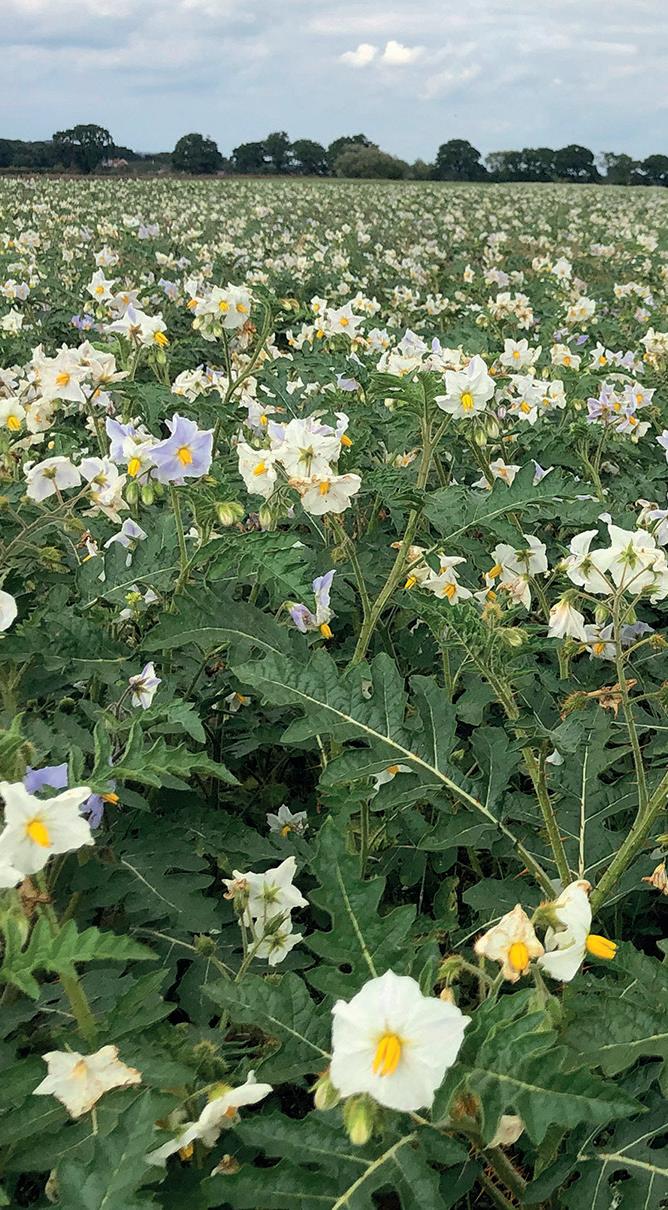
The plants work by inducing PCN egg hatch and acting as a host but preventing the development of new nematode females which, if performed correctly, can cause a significant decline in PCN populations.
Trap crops have been grown in the UK for some 15 years, but a limited supply of seed means only a small area is grown here. Inconsistent
DeCyst project findings
rReduce both species of PCN by up to 85%
rContribute up to 12 tonnes per hectare of green manure
rSuitable for all soils including peat and sands
rDo not produce tubers and can be grown anywhere in the rotation, although a break year after potatoes to avoid
establishment has also affected adoption and it is hoped that by better understanding best practice, such as sowing dates, weed control and general management, trap crops will become more appealing to growers.
Production
The team behind the work held an open day at a Shropshire farm with a long history of potato production and high PCN counts of 30-120 eggs per gram of soil.
Harper Adams University nematologist Dr Matthew Back said: “We need to be looking closely at refining how to reduce PCN throughout the entire
Drilling techniques
JTwo replicated trials explored drilling techniques using a Vaderstad standard approach, a precision flower drill and broadcasting.
The trials were sprayed with glyphosate, rolled and drilled at a depth of 0.5-1cm and followed with 100kg/ha of nitrogen on July 4. One of the trials received a Sumo pass.
Richard Griffith, senior trials agronomist and DeCyst seed sales coordinator for Produce Solutions, said: “Broadcast seed was spread by hand and then Cambridge rolled at 90 degrees to the first Cambridge roll. In hindsight, it may have been worth Cambridge rolling drilled plots twice also. Conditions were so hot and
PCN dormancy is advised
rBest drilled into a fine, firm seedbed between mid-May and the end of June using a cereal or precision drill
rSimple to destroy by chopping and ploughing at a convenient time in October/ November
Source: Produce Solutions
rotation, but at this stage, there is more we don’t know about trap crops than what we know.”
Within the trials, nutrition, seed rate and drilling technique were reviewed through plant counts, emergence patterns and timing, aerial ground cover and crop volume, and PCN egg counts before and after trap cropping. Final counts are being worked on.
PCN specialist Dr Bill Watts, trials manager at Produce Solutions, said: “While nutrition and seed rate can be important factors affecting trap crop success, drilling technique is the critical factor for early and uniform trap crop establishment.
“We have found success when drilling no deeper than 10mm into soil with a bit of moisture or before a rain shower. Seed to soil contact is important and the trap crop seeds are small, so consolidation with a roll can be very useful. If conditions are right and best practice drilling techniques have been followed, seed rate manipulation could be possible.’’
Nutrition is an important factor in establishment and rooting of all crops, including the trap crops.
dry, which may have affected establishment. The seed needs a firm, fine seedbed.
“The standard [Vaderstad] approach worked really well. The next best approach was the precision drill, which could be down to the accuracy of seed depth. The seeds are very small, so depth is critical. At the moment, I would not go down
26 TECHNICAL POTATOES FEBRUARY 2023
Trap crops can offer an 85% reduction in PCN
RICHARD GRIFFITH
off to the best start
applications to trap crops has an impact on efficacy against PCN.” The three species showed differing performance throughout the season.
Dr Watts said: “Prickly had a fantastic year because of the hot, dry conditions. Broadleaf favours a more normal year but still performed well in 2022.”
Podium, the newest crop being explored, appears to perform better under cooler, wetter conditions, but after delayed emergence it grew to provide excellent stands in some trials.
Tomalin said: “Seed procurement has its challenges, so reduced seed rates could offer economic savings, provided efficacy is unaffected. Current recommendations for achieving 40 plants/sq.m are now somewhat historic, so they are being reviewed.
Previous work on trap crops has shown 100kg/ha of nitrogen appears to be the optimum rate, so the trials went one step further to explore the role of P and K.
All plots received 100kg/ha N as standard, plus either 100kg/ha P, or 100kg/ha K, or 100kg/ha of all three.
Dr Watts said: “As a team we have made a number of crop assessments to help determine the importance of trap crop factors under investigation. There is

the broadcast route. You are much better off drilling it for consistency and consolidation.
“Previously, some DeCyst growers haven’t given the trap crops the attention they require, because they are not cash crops. That mindset needs to change, especially when trap crops can offer an 85% reduction in PCN.”
significant evidence showing how nutrients such as P and K affect biomass in most crops, but because 2022 was such a hot and dry season, establishment of some trap crop plots was patchy.
Nutrient applications

“This has resulted in a cloudier picture than we’d have liked, but we can pick up this line of enquiry again in 2023. The truly exciting results are due to come imminently. We will see if P/K nutrient
An additional benefit may be realised as crops which are chopped and incorporated into the soil can add organic matter and increase carbon storage, he added.
Soil samples for PCN are currently being tested and data will be reviewed this spring for the coming season’s trials which will be drilled in May.
Dr Watts said: “When the weather got cooler, Podium came through really well. It was only during the cold spell we had over Christmas that the leaves went, although the stems are still alive at our Bridgnorth site. Podium may be able to be drilled later than the other DeCyst products, which is an area we will be pursuing.”
Seed rate trials aimed for a plant count of 40 plants per sq.m at 20kg/ha seed rate. Seed rate was then increased or decreased by a third to try to see if this target could still be achieved at a lower rate and see whether trap crop efficacy was affected when reducing or increasing seed rate. Establishment ranged from 20-80 plants/sq.m.
Potato agronomist Graham
Project partners
JTaking part in the twoyear project, funded by Defra’s Farming Innovation Programme and UKRI’s Transforming Food Production Challenge (Innovate UK), are Produce Solutions, Crop Health and Protection (CHAP), Harper Adams University and VCS Potatoes, supported by five potato growers in
“One of the challenges we face is how to best fit these trap crops into the rotation. Perhaps after vining peas or carrots. Ideally it would be following winter barley, but dry weather is a big challenge. One farmer is investigating a method of companion planting DeCyst with his other broadacre crops.”
Legacy
As the trials continue the team hopes to explore if the trap crops leave a legacy effect on the viability of PCN egg.
Looking at plants counts, Prickly showed high germination under all seed rates in the dry and hot conditions. Broadleaf high and standard seed rates achieved approximately the same plant establishment, although plant establishment suffered at the lower seed rate. Groundcover was very similar between seed rates for both species however.
Mr Tomalin said: “Broadleaf showed sporadic big plants in the East trials, while Podium was slightly more uniform.”
Shropshire and East Anglia – T.C. and N. Taylor, J.M. Bubb and Son, M.E. Furniss and Sons Farms, James Foskett Farms, A.F. Machinery and independent research agronomist Dr I. Grove.
Growers wishing to find out more about the work or DeCyst seed can contact Richard Griffith at richard.griffith@ producesolutions.co.uk
27 POTATOES TECHNICAL FEBRUARY 2023
MORE ONLINE
DeCyst-Prickly thrived in 2022’s hot, dry conditions.
Early intervention with an integrated pest management (IPM) control programme is recognised as being essential for the long-term sustainable control of potato pest potato cyst nematode (PCN). But how can growers bridge the gap between understanding the complex biology of the pest and using that within an IPM approach, rather than deploying the chemical crutch of nematicides?
That ‘chemical crutch’ in the form of fosthiazate (Nemathorin 10G) is under pressure from supermarket protocols, maximum residue level limits, environmental stewardship and public opinion.

Within Europe, fosthiazate’s approval was extended for a further year in September 2022, which means the threat of revocation of authorisation within the next few years remains.
CRD has aligned the expiry date of the authorisation for
With the continuing availability of chemical nematicides under threat, what might a sustainable approach to potato cyst nematode control look like? Teresa Rush reports.
Managing PCN threat without nematicides

both active and product as October 31, 2024. ISK, the approval holder, with Syngenta, is committed to supporting the renewal of the active in both GB and EU.
Eric Anderson, senior agronomist, Scottish Agronomy, says: “We’ve also got the conundrum of alignment or non-alignment with the EU PCN
package. We will know more when the review is started here.”
Against this backdrop there is a need to focus on alternative, non-chemical control approaches to PCN, including the use of resistant and tolerant varieties, controlling potato volunteers and considering what can be done with respect to increasing the role of IPM in a rotational context.
In Scotland, the average ware variety resistance score for Globodera pallida currently is 2.2 on a 1-9 scale.
This means that, in theory, to grow an intolerant variety without granular nematicides would require a rotational length of 13 years to be sustainable.
And there is a similar issue with respect to G.pallida in East Anglia.
Mr Anderson says: “There is a big problem building and it needs to be grasped. The industry is not doing enough.
“We are missing an opportunity here. We’ve got to implore end users and retailers and processors to engage with this process within a timescale that is realistic and with varieties that are sustainable.”
Analysis
He cites work conducted by Dr Sebastian Eves-van den Akker at the Crop Science Centre in Cambridge, which, using DNA analysis, has shown that pathotypes of G.pallida are much more heterogeneous and variable than G.rostochiensis and, if grown frequently, partially resistant varieties may lead to selection of virulent populations.
28 TECHNICAL POTATOES FEBRUARY 2023
X
Drone imagery showing patches in a potato crop with severe damage by potato cyst nematode. Healthy crop to the left is free of the pest.
ALLSTAR®
Potatoes, but not as we know them.
Brighter, more uniform potatoes that are out of this world

Xemium® in an in-furrow formulation for soil-borne Rhizoctonia control
Better looking potatoes with fewer skin blemishes
Helps crops develop faster and produce more potatoes
Easy to apply through all current equipment
Reliability and formulation technologies backed by BASF agricentre.basf.co.uk
Allstar® is a registered Trade Mark of BASF. Allstar® contains fluxapyroxad. © BASF 2022. All rights reserved. Use plant protection products safely. Always read the label and product information before use. For further product information including warning phrases and symbols, refer to agricentre.basf.co.uk.
TECHNICAL POTATOES
Mr Anderson says: “What we can say from this is that the genetic diversity of G.pallida in field populations in UK compared to that of rostochiensis poses a challenge for deploying resistance which is both durable and effective against G.pallida.”
But resistance is only part of the picture and tolerance must also be considered. Tolerance is defined as the yield response of a potato crop under attack from nematodes in relation to a nematode-free crop.
However, while resistance can be reliably scored on a 1-9 score scale derived from Pf/Pi values, there is currently no similar approach for tolerance.
Potential
Recent research has investigated the potential for using determinacy, as measured by crop height, as a proxy for tolerance.
In glasshouse trials, stem height has consistently produced segregation between PCN-tolerant and intolerant varieties and importantly, the same effect was also seen in field trials.
“There’s a clear trend that varieties with PCN tolerance have tall stems. Indeterminate

varieties are taller than determinate varieties and, in the work, that could be linked to tolerance. Stem height is a gateway not a solution. So, genetic markers for determinacy are currently
being investigated,” says Mr Anderson.
Yet if resistant or tolerant varieties are to be used effectively at farm level there is a need to characterise PCN populations within the field and to understand the probability of finding PCN in soil samples, he adds.
How detectable PCN cysts are depends on the volume of soil sampled. At the EU standard sampling rate of 1,500ml, there is a 92% chance of detection. A non-statutory 400ml sample gives a 52% chance of detection, but if a lab subsamples only 100-200ml, the chance of detection goes down significantly at lower populations within the field.
“It is incredibly important that we appreciate the implications on management decisions on any action taken within the last year.
“You will want to know the number of eggs and juveniles per gramme of soil in your field. You’re going to want to review those with the intention of knowing whether your actions have worked.”
There is also an urgent requirement for accurate identification of species and

reliable quantification of each species, which is not something that can be done looking down a microscope, says Mr Anderson.
“I suggest we need to move to PCR and qPCR within regular laboratory analysis,” he says. Good management of potato land through the rotation is another aspect of an IPM approach to PCN control, as the presence of groundkeepers increases the amount of PCN within a growing season by 16-fold.
Control
Work underway tackling new approaches to groundkeeper control includes the Soil Essentials KORE Artificial Intelligence project, which is using retrainable machine vision cameras to identify volunteer potatoes.
Within a rotational context biofumigation has emerged as an effective, non-chemical, alternative strategy to managing PCN. But there is currently very poor understanding of the glucosinolate and isothiocyanate volatiles that are present within each of the different species used for biofumigation, says Mr Anderson.
“Our current understanding is that propyl 2-ethyl, 2-phenyl ethyl and benzyl isothiocyanate are the most important, but we don’t have good profiles of these. We need to have that for the future if we’re going to use them most effectively.”
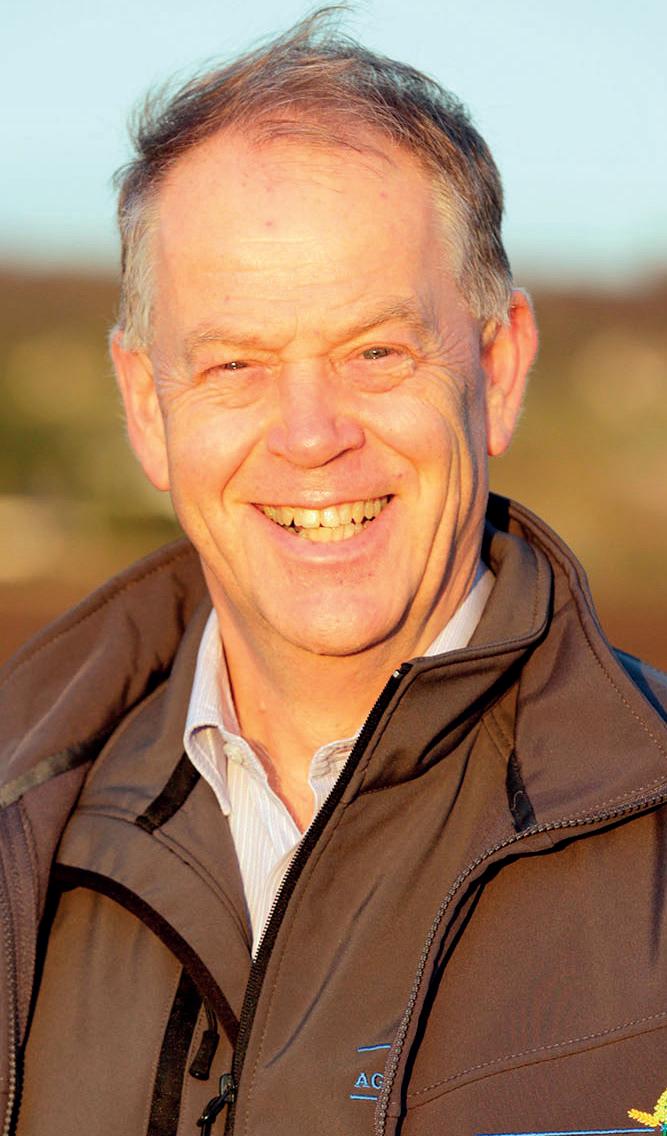
30
FEBRUARY 2023
Cysts of PCN Globodera pallida on the roots of potatoes.
There’s a clear trend that varieties with PCN tolerance have tall stems
ERIC ANDERSON
You will want to know the number of eggs and juveniles in your field
ERIC ANDERSON
The agronomy of biofumigation crops also affects their efficacy, with soil pH and N and S nutrition being particularly important.
Trap cropping can also be an effective tool in the PCN control toolkit. Growing Solanum sisymbriifolium (Decyst-Prickly or sticky nightshade) has been shown to reduce PCN populations by more than 75%. But inconsistent establishment has impacted upon the adoption of these crops in the UK.
“They are non-native species and have proved difficult to establish,” says Mr Anderson.




Recent work has investigated the performance of two other solanceous trap crops – Solanum scabrum and Solanum chenopodioides – to determine the best species and agronomic guidelines for effective PCN suppression and/or control.
Practical findings include the importance of drilling these trap crops at the right depth. Moisture retention is also very important - double rolling helps. And adequate amounts of nitrogen and sulphur must be applied to get the best out of trap crops.
Other work
In other research work, findings from a PhD project completed recently at Southampton University found that reserpine, a relatively cheap and available off-the-shelf product derived from the root of a tropical plant called snakeroot, elicited long-lasting impairment of the ability of invasive second stage PCN juveniles (J2) to invade the host root.
And BBSRC has funded a team in Scotland, which will start work on a six-month project in May 2023 to evaluate the application of chitinous amendments to soil as a means of controlling PCN.





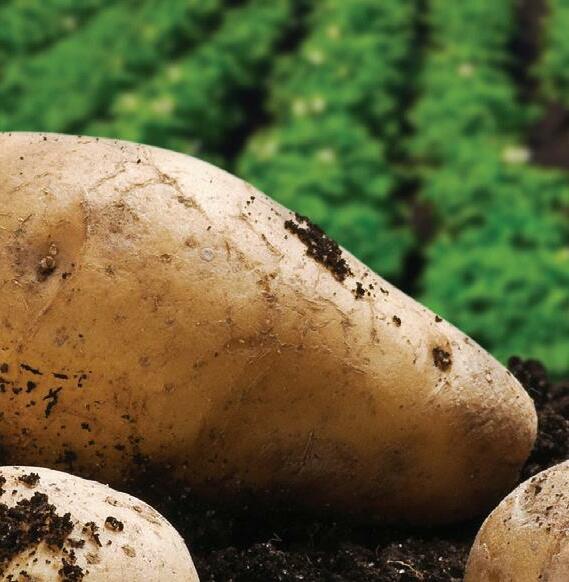
“The project is totally different to anything that’s been
done before, as we will be looking at soil communities to identify changes induced by the soil amendments.

“This will include changes to bacterial, fungal and nematode populations and highresolution eggshell analysis will identify any effect on PCN viability and whether that is due to molecular eggshell degradation, physical effects or whether saprophytic fungi are speeding up the natural decline in viability,” says Mr Anderson.

Developing a sustainable PCN strategy and managing the PCN threat in a world without nematicides will require growers and their advisers to step outside their comfort zones, he says.
“We’ve got to understand the complexity of the biology of PCN, accepting that this is hard. And to accomplish anything, we’ve got to have a strategic plan. There’s a need to be farmer-centric and a need to be farmer-led in our approach.
“A strategic plan must look at all the things we can do and then narrow down the things that are achievable within a timescale that id practical,” he says.
Same Field \ More Yield
•
•
POTATOES TECHNICAL 31 FEBRUARY 2023 For more benefits and trial results visit: polysulphate.com For info email: plantnutrition@icl-group.com ICL potato trials have proven results:
Higher yields
Improved dry matter
Increased nutrient use efficiency
•
•
•
Better skin finish
Reduction in sugars
We’ve got to understand the complexity of the biology of PCN, accepting that this is hard ERIC ANDERSON
JEric Anderson was speaking at the Cambridge University Potato Growers Research Association 33rd Annual Potato Conference.
CUPGRA Conference
Recommended Lists get
Quality over quantity was the theme at the launch of the AHDB Recommended Lists 2023/24, with 28 new varieties added and large yield increases seen, particularly in barley and oilseed rape. Alice Dyer and Teresa Rush report.
The latest edition of the AHDB Recommended Lists (RL) sees a relatively small number of varieties added, including one new Group 2 breadmaking winter wheat variety, KWS Ultimatum, and one new Group 3 biscuit wheat variety, RGT Wilkinson.
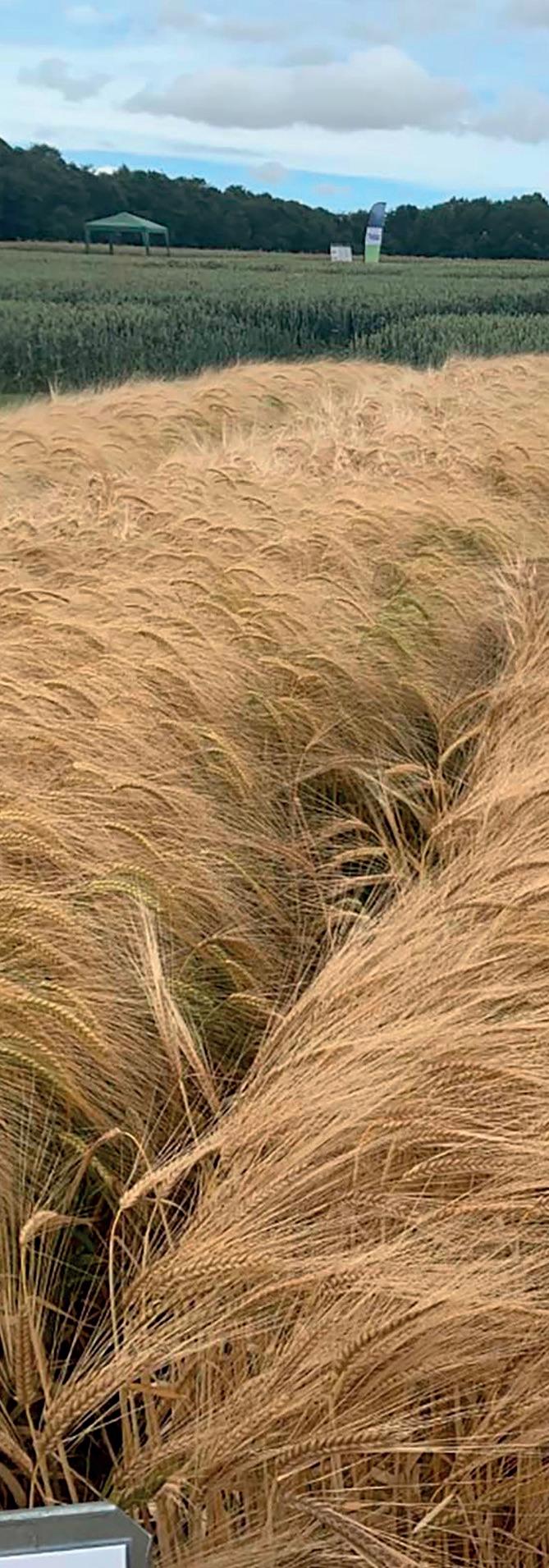
KWS Ultimatum offers yields of 101% in the UK, rising to 103 in the North, based on limited data, putting it 3% ahead of Extase. With a similar Hagberg Falling Number of 287, Ultimatum offers the strongest spec weight in its category at 79.6kg/hl.
Dr Paul Gosling, RL manager, says: “It has a similar protein to Palladium at 12.3%, but it is a bit
later maturing at +1. It looks like it might be potentially suitable for export. It is a bit weaker on septoria at 6.4, but stronger on fusarium with a 7.”

Biscuit wheat RGT Wilkinson joins the Group 3s with a gross output of 101%. It has a
JThe winter oat list saw one new addition in the form of husked variety, Cromwell. With a yield of 102%, Cromwell has a 7% advantage over the current market favourite, Mascani, which was first recommended in 2004.

relatively high HFN for the Group 3 sector at 264, is rated medium for distilling and is suitable for export. RGT Wilkinson has good resistance to mildew (8) and yellow rust (7) and moderate resistance to brown rust (5) and septoria (5.5). It also carries the Pch1 eyespot resistance gene.

Dr Gosling says: “No Group 3s have very good septoria ratings and many have Cougar in the parentage. Wilkinson doesn’t, so hopefully will hold up.
New markets
“It also has uks branding, which neither Brium or Astronomer have, so there is potential for new markets.”
The list also includes two new feed varieties for the East/West region. With the highest septoria rating for Group 4 soft wheat on the new list at 6.7, LG Redwald offers a step up in both treated (107%) and untreated (92%) yield.
Recommended for the North, KWS Zealum has a gross output of 102% and a similar HFN to Skyscraper at 218. It is expected to be of interest to distillers in
the North and has a strong disease package, with a 9 for yellow rust, a 6 for eyespot and an average 5.8 for septoria. With some strong competition in the Group 4 hard wheats, DSV Oxford has also been recommended for the East/ West regions where its gross outputs are 104% and 105% respectively.
Recommended only for the North region is soft Group 4 KWS Zealum, which is likely to be of interest to the distilling market.
TECHNICAL VARIETIES 32 FEBRUARY 2023
Winter oat
No Group 3s have very good septoria ratings and many have Cougar in the parentage
DR PAUL GOSLING
RGT Wilkinson has good resistance to mildew and yellow rust and moderate resistance to brown rust and septoria.
small but mighty boost
Changes to disease

JIn response to recent pathogen population changes, AHDB has refined its approach to septoria tritici disease ratings in winter wheat, last year introducing the one-year resistance rating.
However, for 2023/24, a two- and three-year septoria dataset was calculated, but the differences were very small, so AHDB will only publish the normal threeyear dataset.
Resistance
For yellow rust, the RL has previously only tested adult plant resistance.
First malting barley addition since 2018
Brown rust watch list
JAHDB has announced it is exploring a brown rust watch list, which will take the same format as the yellow rust list, following its success in identifying vulnerable varieties.
Dr Gosling explains: “Given the yellow rust list’s success in predicting varieties vulnerable to a fall it makes sense to try and do the same
for brown rust. We haven’t seen such big changes in brown rust ratings as yellow rust in recent years, but some varieties have seen significant shifts in their ratings and we hope this new list will highlight them early on so growers and agronomists can pay them more attention and beef up fungicide programmes if needs be.”
JThe winter barley list saw its first malting barley newcomer since 2018, in two-row variety Buccaneer, from Saaten Union. Buccaneer offers a significant yield increase over the established two-row malting varieties, Craft and Electrum, alongside good disease resistance.


Dr Gosling says: “With an output of 100% treated and 87% untreated, it is well above the current market dominators. It is very similar in quality and lodging, but offers a step up in rhynchosporium at a 7.”
However, AHDB will now classify varieties as R for resistant and S for susceptible in the seedling stage, based on testing by the United Kingdom Cereal Pathogen Virulence Survey, and AHDB’s field data.
Dr Gosling says: “Adult plant resistance to yellow rust only becomes active at stem extension.
“The presence of yellow rust at T0 and T1 does not mean adult plant resistance has failed, it may just not have kicked in yet. This can cause confusion around spray timings.”
Caution
For eyespot, the 2023/24 list will only feature trials where plants were naturally infected with the disease, which means ratings are bracketed and should be treated with caution, adds Dr Gosling.
33 VARIETIES TECHNICAL FEBRUARY 2023
More Recommended List news over the page.
Saaten Union brought the first malting barley since 2018 to the new RL, in the form of two-row Buccaneer.
Yield leap for OSR
The latest oilseed rape RL welcomes one new conventional variety and five new hybrids.
Turing by LSPB is the new highest yielder on the UK-wide list at 107%. It has good light leaf spot at 7 but is slighter weaker on stem canker than its comparators at 5.
Offering a UK gross output of 105% and rising to 106% in the East/West region, Vegas, also from LSPB has a strong disease package with a 9 for stem canker
and an 8 for light leaf spot. Recommended just for the East/West region at 106% is Murray, which features good stem stiffness and stem canker at 8, plus light leaf spot at 7.
Significant leap
Recommended only for the North, LG Wagner offers northern growers a significant leap in yield at 108%. It has the added security of pod shatter and TuYV resistance, it is a shorter hybrid with stiff stems scored at 8, combined with a 7 for light leaf spot resistance.

Also from Limagrain is Attica, which is recommended for all regions at 107% gross output. It has good stem canker (7) and is also well-rated for turnip yellows virus (TuYV) and pod shatter.
New pulses offer stability and reliability
JFor pea and beans, consistency was a standout feature of the varieties joining the PGRO Descriptive Lists (DL).
Six new combining peas and one new winter bean join the 2023 lists, and a further three new spring bean varieties were added to the DL at a later date following national listing.
This is more than double the number of new varieties added to the list for 2022.
Senior PGRO technical officer
Dr Chris Judge said: “High yielding varieties have maintained their good performance and other traits, such as disease ratings, also retain similar scores to before, with the addition of new supporting data.

Maturity

“For example, the list now includes a score for downy mildew and rust on winter beans. Hopefully the new varieties added to the list are also stable
The only conventional to be added is Tom, with an output of 102%, 1% above previously highest yielding, Acacia.
Dr Gosling says: “It is an incremental increase in yield for
and reliable in the years to come.”
Among the combining peas, Glam has a yield of 108% and has the latest maturity among the yellow peas, while LG Ajax has a yield of 103% and good resistance to powdery mildew.
Green pea Butterfly joins the list with a yield of 109%, with earlier maturity and larger seed size than Carrington. KWS Gotham and Kiravi are both later maturing green pea varieties
34 TECHNICAL VARIETIES FEBRUARY 2023
Tom does not have pod shatter or TuYV as these are harder traits to breed into conventionals
DR PAUL GOSLING
High yielding varieties have maintained their good performance
DR CHRIS JUDGE
Dr Paul Gosling
LSPB brought three new OSR varieties to the list.
Business Development Manager
Agriconnect is a business unit within the Arc network, a global events, data, and media platform. Arc is a fast-growing global events, data, and media platform with a varied portfolio content led portals, magazines, and events. Agriconnect’s mission is to empower, inspire, and connect people and business in agriculture by creating trusted content and connections that help the industry thrive.
Since 1844, the brands of Agriconnect have been the trusted source of information for farmers and with brands like Farmers Guardian, events, like LAMMA and Farm Business Innovation, and digital platforms, like FG Insights, Agriconnect continues to bring together the British farming community.

THE ROLE:
• We are now looking for a motivated and driven salesperson to join our Sales team.
• The main function of the role is to develop business through growth in revenue, yield, and to increase customer numbers. You will be required to identify new opportunities and influence companies’ media buying habits within the agricultural sector. Due to the ever-changing nature of the industry, this person will have the ability to spot new avenues and exploit market trends.
• Hours: 35 hours per week – Mon – Fri
• Location: Preston – temporary hybrid remote
• Salary: Competitive, dependant on experience.
SKILLS & EXPERIENCE:
• Own, support and fully develop specific market sectors
• Conduct sales presentations by telephone, email or face to face to existing and prospective clients in order to develop existing business and generate new business wherever possible.
• Advise existing and new customers on the most effective solution to meet client needs within the Agriconnect portfolio.
• Continually seek and develop new sales & opportunities.
• Ability to accurately forecast future sales
a conventional variety, but we know we need to keep them on the list. It is very stiff at 9 and has a 7 for light leaf spot, one point ahead of Acacia and Campus, but similar disease and
with competitive yields of 107% and 105% respectively.
New marrowfat variety
Takayama becomes the top yielding marrowfat, with a yield of 96%, 10% up on Sakura.
Takayama has a thousand grain weight (TGW) of 350g, a smaller seed size than Sakura. It also tops the marrowfat category in terms of resistance to downy mildew with a rating of 6.
Bonneville is the only new winter bean addition to the
earliness other than that. It does not have pod shatter or TuYV as these are harder traits to breed into conventionals.”
Clearfield variety Beatrix CL from DSV was also added.
2023 list. Its yield is above average at 102% and it has the second highest protein content on the list
Spring beans
Of the three new spring bean varieties – Genius, LG Stego and Futura – Genius, from LS Plant Breeding, is now the top yielding variety on the DL with a yield of 110%. It has the same maturity as Lynx (6) and a good standing ability (8).
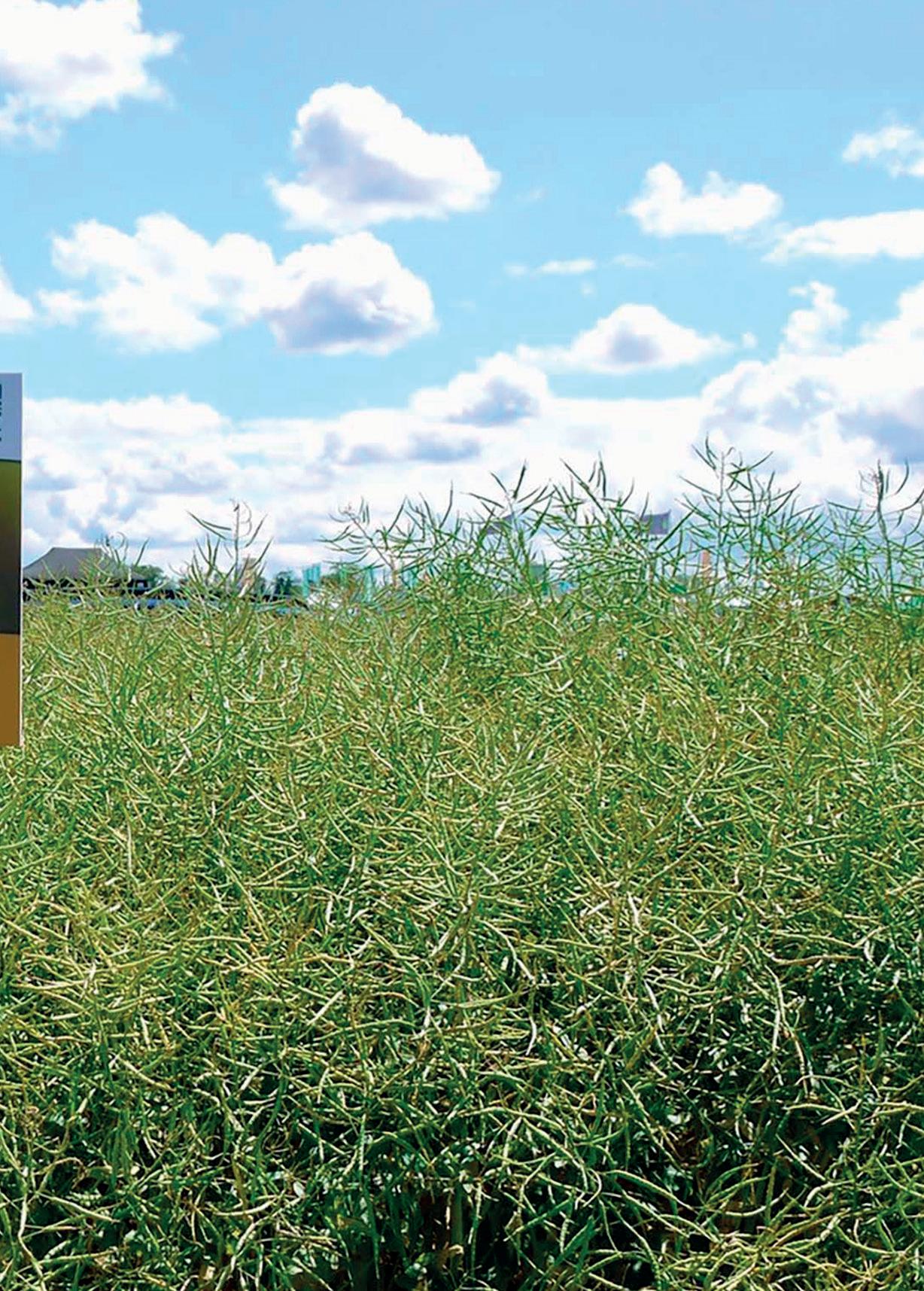
• Keep abreast of all current trends, activities and relevant news within agriculture and specific sector
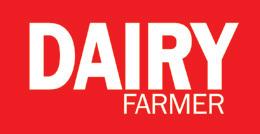
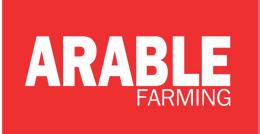
• An interest in agriculture
• Highly motivated & driven, with an ability to meet ambitious performance goals
• Be enthusiastic and motivated to continually explore new opportunities, whilst possessing a natural inquisitive nature
• Excellent communication written and interpersonal skills
We offer an excellent package including:
• A competitive basic salary
• 25 days holiday increasing to 27 after two years
• An extra day off on your birthday
• Free life assurance
• Contributory pension scheme
• Employee assistance programme
Arc has ambitious plans for growth, and this is an opportunity to be part of our continuing success story whilst enjoying a fabulous work/ life balance.
We strive to create a culture that is open and respectful, where differences are valued and celebrated. We want everyone to be able to reach their full potential, so we are committed to cultivating a company that promotes inclusion and belonging.
To apply for this role, please email amber.tabiner@agriconnect.com
35 VARIETIES TECHNICAL FEBRUARY 2023
IPM approach needed for beet weed control
Currently there are 10 herbicide actives available for weed control in sugar beet in the UK, two of which can be used only on Conviso herbicide-tolerant crops, bringing the total down to eight.

And of those eight, three provide the building blocks for weed management in the beet crop.
The presence of these active materials in more than 100 herbicide products available for sugar beet might understandably provide a sense of security, but as newly-appointed British Sugar technical support manager Pam Chambers points out, their future availability is by no means certain, with the approval of use for several due for renewal within the next two years.
Crucial
She says: “We’ve got three key actives that are really critical to us: phenmedipham, metamitron and ethofumesate. They are what I call the building blocks, they can be used as actives on their own or they can be used in tank mix combinations. But they are crucial to us for weed control at present.”
One herbicide active she will be keeping a close eye on is phenmedipham, approval for which expires on July 31, 2023 in the EU and December 31, 2024 in Great Britain - at present.
“The rapporteur state was Finland and it came as a huge surprise to everybody that in May 2022 they concluded this active was an endocrine disruptor. But task force members for this active,
UPL and Bayer CropScience, say they have sufficient data to say that it does not meet those criteria, and we’re lobbying hard with this.”
Ms Chambers describes the GB situation with phenmedipham as ‘a little bit of an unknown’.
The task force submitted a renewal dossier to the GB regulator in January 2022 and at the time of writing (mid-January 2023) awaits a response.
“At the moment, the approval expires in 2024, but do remember these expiry dates can be changed.”
Another herbicide active with an uncertain future is the sulphonylurea triflusulfuron-methyl (Debut, Shiro and others).

Products containing this material help growers targeting difficult-to-control weeds, including brassica species, cleavers and mayweed.
“Within Europe, triflusulfuron-methyl has been classified as having endocrine disruptor properties, so a renewal would not
be granted. But there is a possibility of [use of] a derogation called Article 4.7 [of Regulation (EC) No 1107/2009]. That’s where an active
is considered essential for use for a crop to continue to be profitable.”
Triflusulfuron’s approval for use in Europe was due to expire on December 31, 2022.
“But I believe that will be extended for at least another year. That then gives the Commission time to say what they are going to do, including whether they will they grant a derogation under 4.7 or not.”
In Great Britain, approval for this active expires at the end of December 2024.
British beet going forward
JOther factors likely to affect the ongoing availability of chemical control options in sugar beet include resistance to herbicides; the small area of sugar beet grown in the UK relative to larger areas grown in France, Germany and Poland, for example, and the development of new, non-chemical weed control technologies.
While the GB sugar beet area is expected to increase to close to 95,000 hectares for the next campaign, up from around 88,000-90,000ha currently, this area remains considerably lower than those of France, Germany and
Poland. France, for instance, grows about 400,000ha of beet.
Manufacturers looking to introduce new products or actives might develop them according to European requirements.
“And that may override what we actually want here in GB,” says Ms Chambers.
“Currently we rely mainly on chemical-only control and it works well and it’s good, but there are risks. Going forward to 2030, we are going to be looking at more of a combination of chemical and mechanical weed control and precision weeding,” she concludes.
36 TECHNICAL WEEDS FEBRUARY 2023
With a potentially shrinking herbicide armoury, there are set to be challenges ahead when it comes to managing weeds in sugar beet. Teresa Rush reports.
A combination of chemical and cultural options will be needed for weed control in sugar beet.
JPam Chambers was speaking at the BCPC Weeds Review 2022, held at NIAB, Cambridge
Technical view
The latest chapter of the weed control programme
A winning combination of actives that make a true difference to the grass-weed programme

BEST IN CLASS


5% more grass-weed control than the next best contender*

DEBUT FOR TCM a superior weed active*


STAR ATLANTIS


Coming soon to a field near you. Springtime: the weeds return! In the battle against black-grass, Italian ryegrass and brome, there’s a new active. Thiencarbazone has joined forces with mesosulfuron and iodosulfuron to create a new, more effective, post-emergence herbicide: Atlantis Star. Together, they take on a wide range of grass and broadleaved weeds, delivering strong performance against resistance and reducing the scourge of seed return.


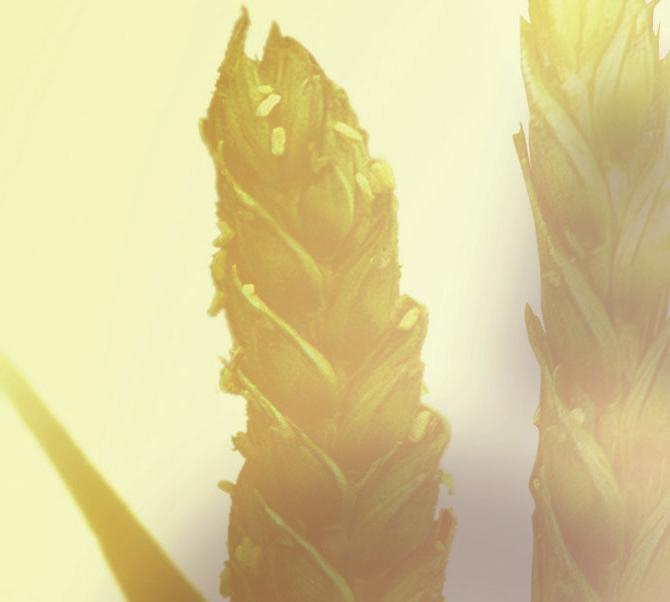





Get the full story on Atlantis Star at cropscience.bayer.co.uk/atlantis-star *Atlantis Star (mesosulfuron, iodosulfuron and thiencarbazone) offers up to a 5% improvement in control of black-grass and Italian rye-grass and up to 10% increase in brome control when compared to Pacifica Plus (iodosulfuron, mesosulfuron and amidosulfuron). Atlantis Star contains mesosulfuron, iodosulfuron and thiencarbazone. Atlantis Star is a registered Trade Mark of Bayer. Use plant protection products safely. Always read the label and product information before use. Pay attention to the risk indications and follow the safety precautions on the label. For further information, including contact details, visit www.cropscience.bayer.co.uk or call 0808 1969522. © Bayer CropScience Limited 2023.
Any grower with a ryegrass weed population on-farm should treat it as a big problem, warns one leading agronomist. Arable Farming reports.

Careful use of post-ems can counter ryegrass
Italian ryegrass and black-grass have many similarities, but there are some important differences on what control strategies work best. Springapplied post-ems are a case in point; research shows that susceptibility to ALS-chemistry is much more common in ryegrass than black-grass.
John Cussans, weed biology and management specialist at NIAB, who led the 2021 NIAB/ Bayer ryegrass survey, says: “When it comes to Italian ryegrass management, we can’t rely on the black-grass template. “Cultural control approaches

JItalian ryegrass has been a problem for farm manager Ben Binder over nearly two decades at the Belmont Estate, Kent.

He says: “We never stopped using Atlantis entirely and resistance test results show it was the right decision, but we still need the pre-ems to perform. From the walking I’ve done in December and January, pre-em control hasn’t been as good this year, so we need to get as much as possible from the post-ems this spring.
“Trials and resistance testing on-farm have shown several spring post-ems should still have something to offer against ryegrass. But on a field scale, we have had the best results from Atlantis-type products, the other options don’t give enough control.”
Mr Binder has used Proverb
that have served us so well in black-grass management are acting differently in Italian ryegrass. The same is true of
Italian ryegrass susceptibility to post-em chemistry Susceptibility
herbicides. Think about the weed sensitivity of the populations you have in the field and tailor your programme accordingly.”
The 2021 survey resistance tested 197 populations, finding nearly half still susceptible to
Atlantis-type chemistry (HRAC Group 2), while pinoxaden (HRAC Group 1) was still effective against many populations as well.
“If you surveyed people and asked how many think ALS
Continues on page 40.
(mesosulfuron + iodosulfuron + thiencarbazone) which is the same formulation as Atlantis Star and which has been available on a limited distribution for two seasons. Overall, he assesses the control as reasonable, but a lot depends on application conditions, he says.
Poor result
“There are so many factors involved in Atlantis performance that you can easily get a poor result if you’re not careful.
“Light intensity is key; applying on a clear day with bright sunshine usually gives better results than on a dull day, irrespective of the date. Obviously, you can’t apply in freezing weather and spray from mid-morning to mid-afternoon to get the drying time.”
38 TECHNICAL SPRING WEEDS FEBRUARY 2023
Sensitive to ALS chemistry and pinoxaden 25.9% Sensitive to ALS only 19.7% 65.5% Sensitive to pinoxaden only 19.7% Resistant to ALS and pinoxaden 34.5
}
Source: NIAB/Bayer CropScience ryegrass survey, 2021.
John Cussans
In the field Ben Binder, Kent
Light intensity is key; applying on a clear day with bright sunshine usually gives better results than on a dull day
BEN BINDER
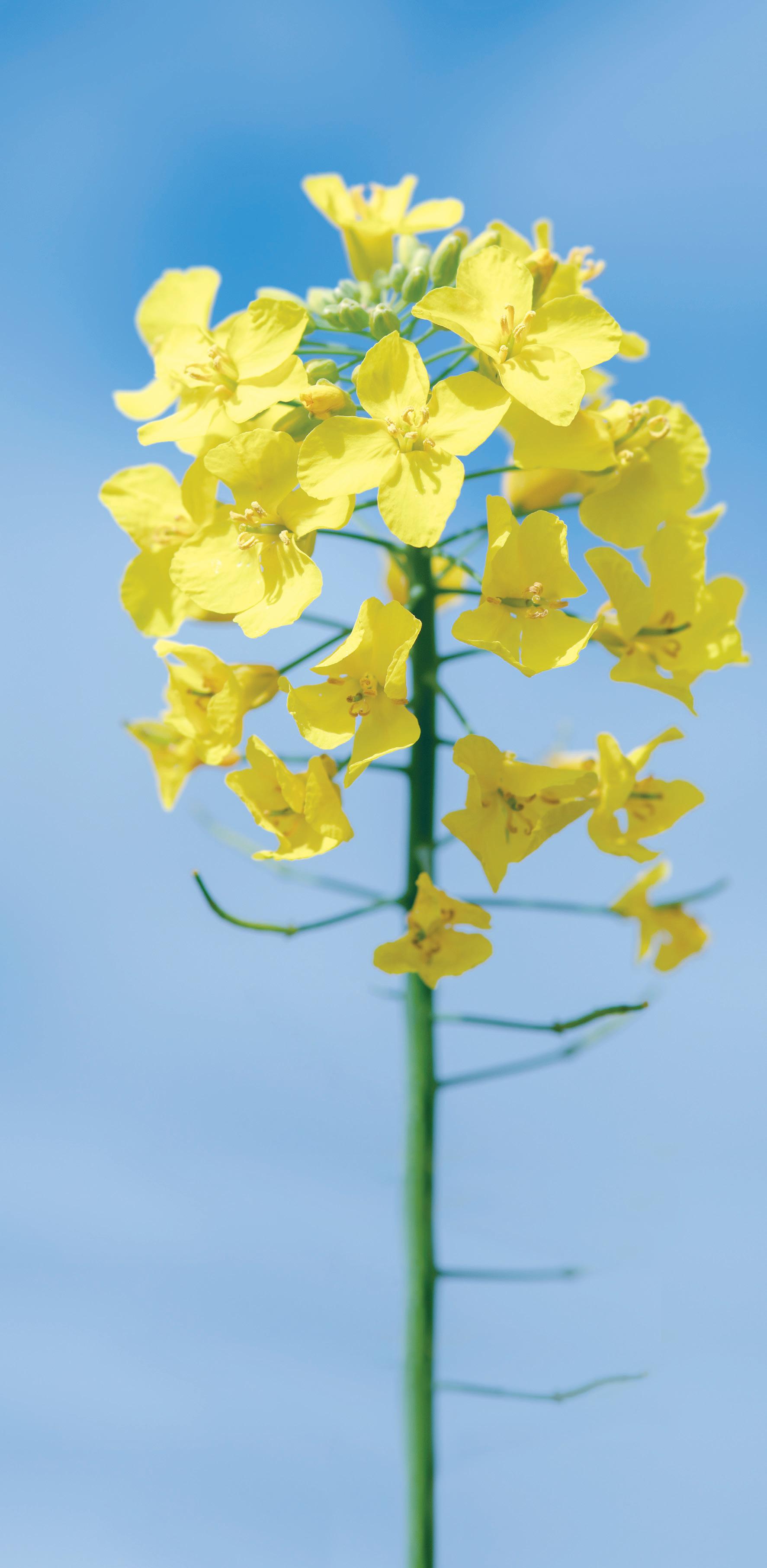
EVEN A SLIGHT LEAN. REDUCES
16% Plant Growth Regulator Caryx ® Caryx® is a registered Trade Mark of BASF. Caryx® contains metconazole and mepiquat-chloride. © BASF 2022. All rights reserved. Use plant protection products safely. Always read the label and product information before use. For further product information including warning phrases and symbols, refer to agricentre.basf.co.uk. STRENGTHEN IT. STRAIGHTEN IT. CARYX IT. Use Caryx® , the number one PGR* to reduce lodging, increase rooting and optimise canopy size. *Source: 2018-2022 AgriInsight ™ - Kynetec
YIELD BY
doesn’t work on Italian ryegrass, I expect it would be a much higher number than what we found in the survey,” says Mr Cussans.
“It’s not because those people aren’t having problems controlling Italian ryegrass, but the source of the problem is perhaps not what they imagine it is.”
This view is shared by Bayer business development manager Tom Chillcott who has seen a similar situation in Bayer’s own resistance testing programme.
Herbicide resistance

He says: “In 2021 and 2022 we tested 17 ryegrass samples submitted by farmers or agronomists for herbicide resistance. Ten of these came back as susceptible to ALS-chemistry,” he says.
“This spring, farmers can use the latest version of this chemistry, Atlantis Star, which includes thiencarbazone alongside mesosulfuron and iodosulfuron. The addition of thiencarbazone












improves grass-weed control, including ryegrass, by 5-10%.”
Tests in the field are one thing but seeing the difference in the field is another. Agronomist Andrew Blazey of Prime Agriculture and chairman of the Association of Independent Crop Consultants submitted two samples to the ryegrass survey from farms in the East Anglia. In both cases, the farmers wanted to know more about the ryegrass problem which needed ever more attention to keep it under control.
He says: “I don’t think you can ever get completely in control of ryegrass, but you can keep it manageable. On the two farms, we noticed ryegrass was popping up in more places from the usual problem fields, so it was important to have a better understanding of it.
“On one farm, the resistance tests came back broadly as expected: ‘RR’ to ALS and pinoxaden and reduced control





from pre-ems too. About four years ago we had already realised the extent of the ryegrass problem and the farmer is fully on board with managing resistance. He sows a reduced area of second wheats and aggressively controls patches with glyphosate and carries a knapsack sprayer in the cab during T2 and T3 applications to spray off any individual plants or small patches.
Surprise
“In hindsight, we should’ve done the resistance testing three or four years ago to be sure about what we were dealing with because it is not always predictable, as the sample from the other farm showed. The second result surprised me, it came back as susceptible to ALS and pinoxaden, even though we used Pacifica (mesosulfuron + iodosulfuron) and Broadway Star (pyroxsulam + fluroyxpyr) fairly extensively on-farm.
“Given my experience on the farm, I’m not sure the result that came back is reflective of the situation in every field, so we are looking at doing some strip trials this spring to test ALS-performance.”
Looking at the results from the whole survey, Mr Blazey thinks there is a lesson in this to look at application technique.
“It’s not the case that a susceptible resistance test means you can apply a post-em whenever and however and expect to get control. John Cussans and the team at NIAB apply products in a glasshouse, to a dry leaf, ensuring





consistent coverage and so on. Conditions for a field application will never be as good, but there are ways we can increase the chances of a good result.

“Farmers looking to hit grass-weeds when they are small in February ought to think of it as a ‘one-tank-a-day’ operation. Realistically, there is a two-hour window from midday to 2pm to spray with sufficient drying time before dusk and dew formation.”
He points out that it is essential to have active growth and a lack of rain or strong wind, so getting a good result with a post-em requires patience and a clear idea which fields will benefit from an application to prioritise sprays.
For farmers with any sort of ryegrass problem, Mr Blazey insists they get the fundamentals right before they start thinking about herbicides which are the cherry on top.


“Anyone with ryegrass should treat it as a big problem, regardless of the resistance status. Hygiene and husbandry are key to managing the problem in the long-term. Ryegrass seed tends to hang on to the combine for longer; blow down the combine between each field and clean cultivation equipment too.
“Cultural control techniques are familiar to everyone from black-grass, the general rule is they all work for ryegrass, but not quite as well, so you need more of them and really good attention to detail.”
40 TECHNICAL SPRING WEEDS FEBRUARY 2023
UREASE INHIBITOR NitroShield Protecting your nitrogen Improves Nitrogen Use Efficiency Reduces ammonia losses by 70%+ Contact us today 01526 396000 Visit www.omex.com Email agriculture@omex.com
In 2021 and 2022 we tested 17 ryegrass samples. Ten came back as susceptible to ALS-chemistry
TOM CHILLCOTT
I don’t think you can ever get completely in control of ryegrass, but you can keep it manageable
ANDREW BLAZEY
Proven to hit the mark year after year.
Trusted by growers and agronomists up and down the UK, Broadway® Star delivers an outstanding performance in winter wheat against yield robbing grassweeds as well as troublesome broad-leaved weeds.
Broadway Star is my go-to spring product for ryegrass and wild oats with the added bonus of enough activity on broad-leaved weeds to be able to forget any further need for herbicides. ”
Matthew Copley, Farm Manager, North Yorkshire
It’s an essential part of our whole rotation approach to controlling brome grasses with the added advantage of hitting cleavers and wild oats. A flexible and very effective herbicide. ”
Michael Hambly, Farmer, Cornwall
Great spring clear up of grassweeds and difficult broad-leaved weeds. There’s a lot more tame oats to control now and Broadway Star fits this situation perfectly. ”
Mark Bellamy, Agronomist, Lincolnshire
I’ve used Broadway Star for over 10 years. It works on a good range of weeds - especially wild oats and cleavers. In a lot of fields it is the only herbicide needed for spring weed control. ”
David Short, Agronomist, Hertfordshire
Rye grass
Wild oats
Broad-leaved weeds Brome
Broadway® Star gives excellent control of brome species, ryegrass and wild oats in wheat. It is also effective against a wide range of broad-leaved weeds. Apply for cost-effective and proven control.
Hit your problem hard. Talk to your advisor or find out more at www.corteva.co.uk/broadwaystar
ADVERTORIAL
“
“
“
“
USE PLANT PROTECTION PRODUCTS SAFELY. Always read the label and product information before use. For further information including warning phrases and symbols refer to label. Corteva Agriscience UK Limited, CPC2 Capital Park, Fulbourn, Cambridge CB21 5XE. Tel: 01462 457272. ®, ™ Trademarks of Corteva Agriscience and its affiliated companies. © 2023 Corteva. Broadway ® Star contains florasulam and pyroxsulam. Discover more at corteva.co.uk Technical Hotline: 0800 689 8899 E-mail: ukhotline@corteva.com
them
them
Hit
early. Hit
hard.
Keep in the know corteva.co.uk/signup @CortevaUK
An OSR establishment study, undertaken in late autumn 2022, canvassed the experience of growers across the country planting more than 30,000 hectares of winter OSR for 2023. Teresa Rush picks out some of the key findings.
Study gives OSR confidence boost
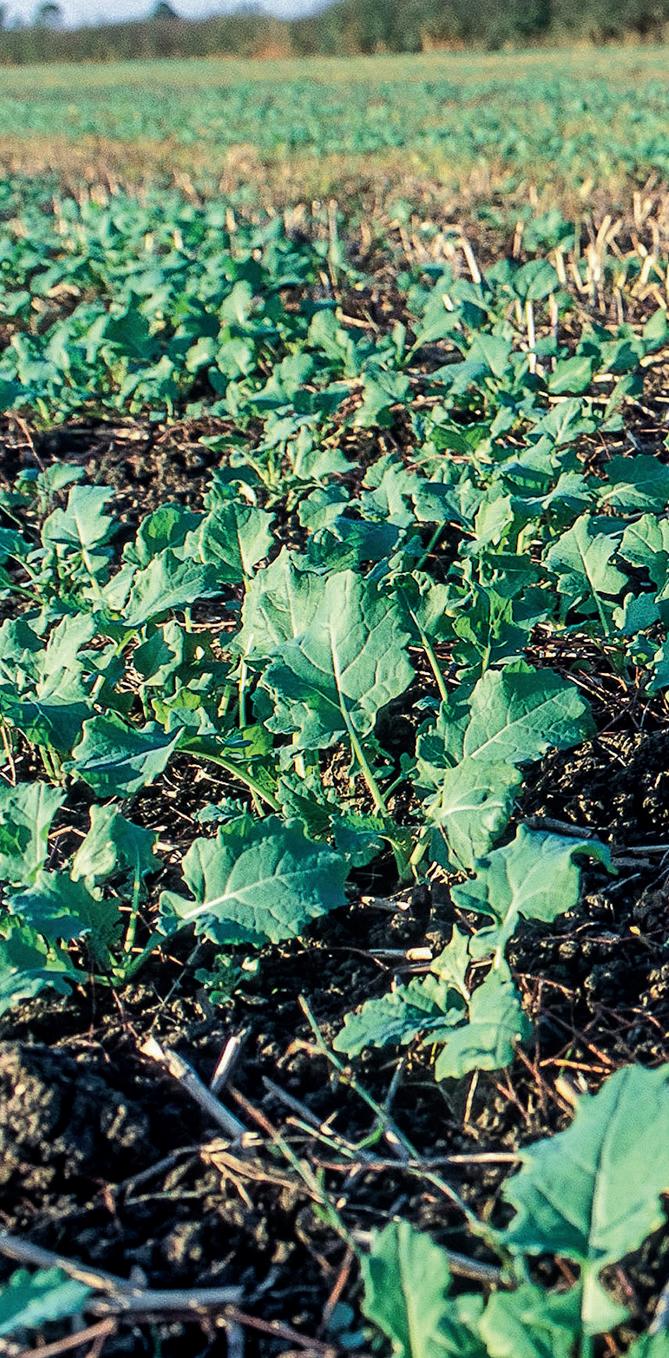
At 106 hectares, the average planted area was almost 20% up on the previous season and almost back to the average 110ha of 2019, with just under half the growers surveyed in the Dekalb national establishment poll planting more oilseed rape than last season and less than one-fifth of growers less.
Varieties
A broad cross-section of almost 60 varieties of six main types are being grown, with the swing to hybrid varieties and decline in pure lines evident among mainstream ‘double low’ growers last season continuing (see Figure 1).
Establishment
Direct drilling has become almost as popular as minimum tillage as the main establishment regime, with around four in every 10 growers employing it last autumn and only 3% continuing to rely on the plough (see Figure 2)
Driven by the very dry early
The poll and sample
autumn, there was a clear reversal in the trend to earlier drilling recorded in the past three years of Dekalb studies, with more than 40% of growers sowing the bulk of their crops before August 20, compared to 55% in 2021 (see Figure 3).
Moisture levels at sowing were noticeably worse than the last most problematic establishment season of 2019, with all regions experiencing particularly dry seedbeds.
Most growers report receiving sufficient rainfall since sowing, with those in the northern regions
three years of studies provide a good basis for benchmarking establishment experience. Results were analysed from more than 290 growers from England, Scotland and Wales planting more than 30,000 hectares of winter OSR for the 2023 harvest.
receiving more than those in southern England.
Bayer seed campaign manager and poll co-ordinator Lizzie Carr-Archer says: “The real clincher in moisture terms is the amount of rainfall received after sowing, rather than the conditions at drilling.”
All growers are employing one or more of the six most popular establishment management techniques; minimising soil movement continues to be the most widely used, with seedbed fertiliser also being employed by half or more growers.
At less than 5% of the crop area, the amount of redrilling necessary was much less than the 14% recorded in the very poor season of 2019/20 and similar to that of 2020/21.
Almost 5% of the drilled/ redrilled land is likely to be the subject of claims under one of the 2022 season establishment schemes offered by seed suppliers.
Accounting for further crops written off over winter, this suggests overall crop survival to spring is likely to be more like the 90% of the past two seasons than the 67% of 2019/20.
This prospect is reinforced by an average score of 7.3 on the 0-10 scale (where 0 = complete failure and 10 = perfect establishment), with almost 80% of this season’s crop rated 7.0 or better
42 TECHNICAL OILSEED RAPE FEBRUARY 2023
JThe online Bayer CropScience study was undertaken in late October/early November 2022 to assess the relative success of winter oilseed rape establishment across the country in the face of this season’s pressures. Identical core questions to the previous
Data comparing 2022 with 2019. SOURCE: Bayer, Dekalb Direct drilling Minimum tillage Subsoiler seeding Plough-based 0 10 20 30 40 50 60 70 80 90 100 2022 2019 Proportion of growers 28% 40% 39% 18% 3% 35% 27% 10%
Figure 2: Establishment regime changes
SOURCE: Bayer, Dekalb Mainstream hybrids Pure line varieties Clearfield Clubroot resistant HOLL HEAR Proportion of varieties grown 50% 33% 7% 4% 2% 4%
Figure 1: Main variety types
for establishment and just 7% rated less than 5.0.





























Moisture conditions at sowing had much less of an effect on establishment than cabbage stem flea beetle (CSFB) pressure, with an average difference of less than 1.0 establishment point between very dry and reasonable conditions. Rainfall after sowing, however, had a much greater effect. The average establishment score difference between almost none or very little rain and a decent amount being virtually identical to that between little and significant CSFB pressure.
CSFB






































All regions experienced more pressure from CSFB than seen in the previous two seasons, but the level of challenge from the pest was much lower than the last bad CSFB season of 2019/20.
The earliest sowings continued to see the least challenge from the pest, with particularly marked year-on-year increases in CSFB pressure reported for later sowings (see Figure 4).
Even though greater CSFB pressure has meant a higher proportion of growers spraying insecticide at establishment this season, this has not led to a decline in the proportion of those deliberately avoiding spraying to encourage predators. Almost half of direct drillers (48%) are now deliberately avoiding insecticide spraying.


















“It is really encouraging to see the proportion of growers deliberately avoiding insecticide spraying increasingly slightly, from 33% last season to 37%,” says Ms Carr-Archer.









The major impact of CSFB















Figure 3: Sowing date distribution (2022)
Figure 4: CSFB pressure at establishment


continues to be underlined in an average establishment score difference between the least and most significant pressure from the pest – across all sowing dates and moisture conditions at and after sowing – of 3.0 points. Despite coming under greater CSFB pressure, by virtue of being sown rather later than pure line varieties, hybrids showed their value by establishing every bit as well.



Spreading organic manures and seedbed fertiliser application were the only management techniques giving noticeably higher establishment scores when employed in the absence of any other.










“This season’s poll gives particular confidence to those not letting the very dry, early autumn put them off sticking with or increasing their winter OSR for 2023,” says Ms Carr-Archer.
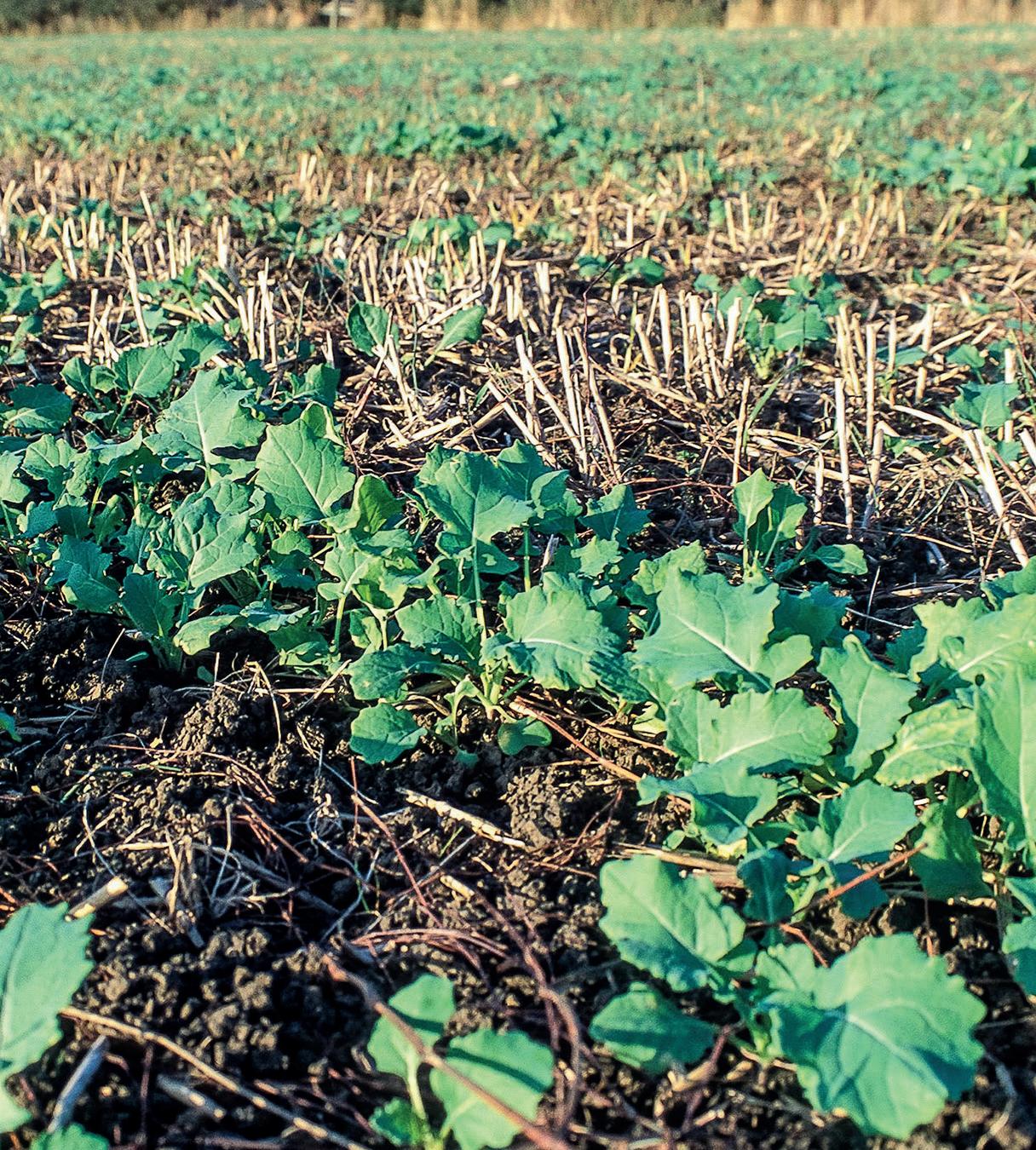








43 OILSEED RAPE TECHNICAL FEBRUARY 2023 Issues for
Terms and conditions apply O�er available to new subscribers only Receive the magazine weekly direct to your door via Royal Mail Website access 24/7 plus read on the go with our FG app FREE Arable Farming and Dairy Farmer digital magazines FG Rewards PLUS more! Why subscribe? Scheme SUBSCRIBE AND SAVE SUBSCRIBE AND SAVE
es f
Growers surveyed reported an average crop establishment score of 7.3 on the 0-10 establishment scale (where 0 = complete failure and 10 = perfect establishment).
July August 1-7 August 8-20 August 21-31 September 1-15 September 16 or later Proportion of crops 1% 5% 7% 35% 38% 19%
SOURCE: Bayer, Dekalb
Intense challenge Substantial challenge Moderate challenge Little or no challenge 0 10 20 30 40 50 60 70 80 90 100 August 7 and earlier August 8-20 August 21-31 September Proportion of growers 9% 5% 4% 5% Data shown by sowing date. SOURCE: Bayer, Dekalb 43% 48% 12% 55% 28% 22% 52% 24% 20% 48% 27%
Convention has it that legumes such as beans and peas benefit most from bacterial inoculants, but a British firm has been investigating how bugs can be beneficial for wheat too. Arable Farming reports.
Inoculate to accumulate in wheat
ho wouldn’t say yes to a seed treatment which offered improved germination rates, early vigour, better phosphate uptake and increased nutrient acquisition?

Especially when the evidence is borne out by significant yield increases and a very respectable return on investment (ROI)?
Dr Bruce Knight, founder and chief executive of Nottingham-based Legume Technology, says: “It’s underlining the old adage – your crop’s yield potential is determined by what happens in the first 10 days.
“If you don’t have a happy, healthy crop when it comes out of
Wthe ground, there’s an immediate yield loss right there, a loss that you’ll never recover, no matter what you throw at the crop later.”
Dr Knight has spent six years investigating use of the bacteria bacillus as a seed treatment.

Ubiquitous in soil, this genus of bacteria is well known by biologists for its ability to elicit beneficial responses in commercial crops. Here, it has been observed to contribute to the plant’s immune system, nutrient absorption, improved root structure and even some nitrogen-fixing capabilities.
Toxins
Other species are known to produce natural toxins, warding off insect attack, or secreting antimicrobial compounds that inhibit fungal pathogens.
Widely used in industrial fermentation for the production of high-performing enzymes and compounds such as riboflavin –better known as vitamin B2 – many bacillus species are classified Generally Regarded As Safe (GRAS), allowing their use in food manufacturing without specific approval.
Dr Knight says: “While it may be novel in crop protection, it’s this kind of classification and recognition that makes bacillus attractive to work with.
Bacillus-treated peas: 2022 field trials
“We first tried it in 2017 in a study we commissioned with the Processors and Growers Research Organisation. We were looking to add something to our rhizobium inoculant to provide legumes such as peas with an additional benefit.
“Initially the focus was on third-party seed treatments, including a folic/humic acid biostimulant. We also tried mycorrhiza, a fungal biostimulant with which we had extensive experience going back to the company’s beginnings in 2000.
“While both the biostimulant and mycorrhizal treatments demonstrated some benefits, neither was enough to astonish us and merit any further investigation for commercialisation. But the bacillus did.”
Dr Knight says while the projected ROI – based on improved yield – from the biostimulant and mycorrhizal treatments was around £11 per hectare and £20/ha respectively, bacillus indicated a possible £52/ha ROI.
Root mass
“We found bacillus was endowing the plant with better lateral rooting and greater root mass, which in turn was allowing rhizobacteria to improve nodulation on the roots.”
Pea success has continued, with further trials to tweak the product and understand its abilities across a variety of soils and conditions. Dr Mike Thomas, Legume Technology’s
44 TECHNICAL SEED TREATMENTS FEBRUARY 2023
Characteristics Untreated Rootfix Difference Height (cm) 45.40 53.14 +17.0% SPAD 44.47 47.95 +7.8% Pods per plant 6.02 8.06 +33.9% Peas per plant 18.4 33.7 +83.1% Source: Legume Technology
Bacillustreated plants exhibit better tolerance to temporary periods of abiotic stress, such as drought
DR MIKE THOMAS
Trials of a bacillus seed treatment for wheat are underway in the UK following observations of germination and yieldboosting effects in trials in Canada.
research and development manager, says the constant improvement of the product gave £189/ha benefit in 2021 and even better results in 2022.
He says: “Peas’ short growing period make early establishment essential. We wanted to demonstrate how bacillus could be a valid treatment for crop establishment so, in conjunction with a major UK pea producer, we selected sites with recorded problems of crop establishment or low yields.
“All four sites showed betterment and on two sites there was a significant improvement in the crop: increased pods per plants, and improvements in plant density, height and chlorophyll content.”
The observation that bacillus influenced rooting was one of the initial motivations for assessing its performance in cereal crops; that, and its already confirmed ability to solubilise nutrients (such as phosphate) to increase bioavailability.
Glasshouse trials carried out by the University of Nottingham compared bacillus strains with conventional, chemical treatments to assess effects on low-temperature – 7degC –germination of wheat.
“Results were better than we expected,” says Dr Thomas.
Outperformed
While all the treatments eventually reached the same end point –around 98-99% germination by day eight – the bacillus formulation was always ahead of the pack and consistently outperformed the standard fludioxonil seed treatment, claims Legume Technology, providing maximum germination a full two days ahead.
“We also discovered during pot trials with rice that bacillus-treated plants exhibit better tolerance to temporary periods of abiotic stress, such as drought. Their greater root surface area improves water absorption, even when water is in short supply. What’s more,
higher levels of soil bacteria also increase biofilm production at the root/soil barrier, which further increases water retention in the rhizosphere.”
As the focus switched to wheat, the team identified new, additional bacillus strains to add to the product – aided by 2022’s new partnership with the Spanish biostimulant specialist GreenUniverse, which brought access to a whole new library of novel strains.
“Although bacillus is common in all soils, inoculants work best when you use an unconventional strain,” says Dr Knight.
“It needs a special ability –think of it as a bacterial ‘superhero power’. In this case, we’ve got strains that, individually, provide good germination and early vigour, stimulate plant hormone production and aid phosphate and potassium mobilisation.
“It’s this combination that creates a synergistic effect.”
Last year also saw the first field trials of bacillus in wheat, as well as barley and maize, conducted in Canada. The company’s historic focus on soyabeans provides opportunities to try products in a variety of other rotational crops – bacillus-treated seed is said to have outperformed conventional treatments in all cases.
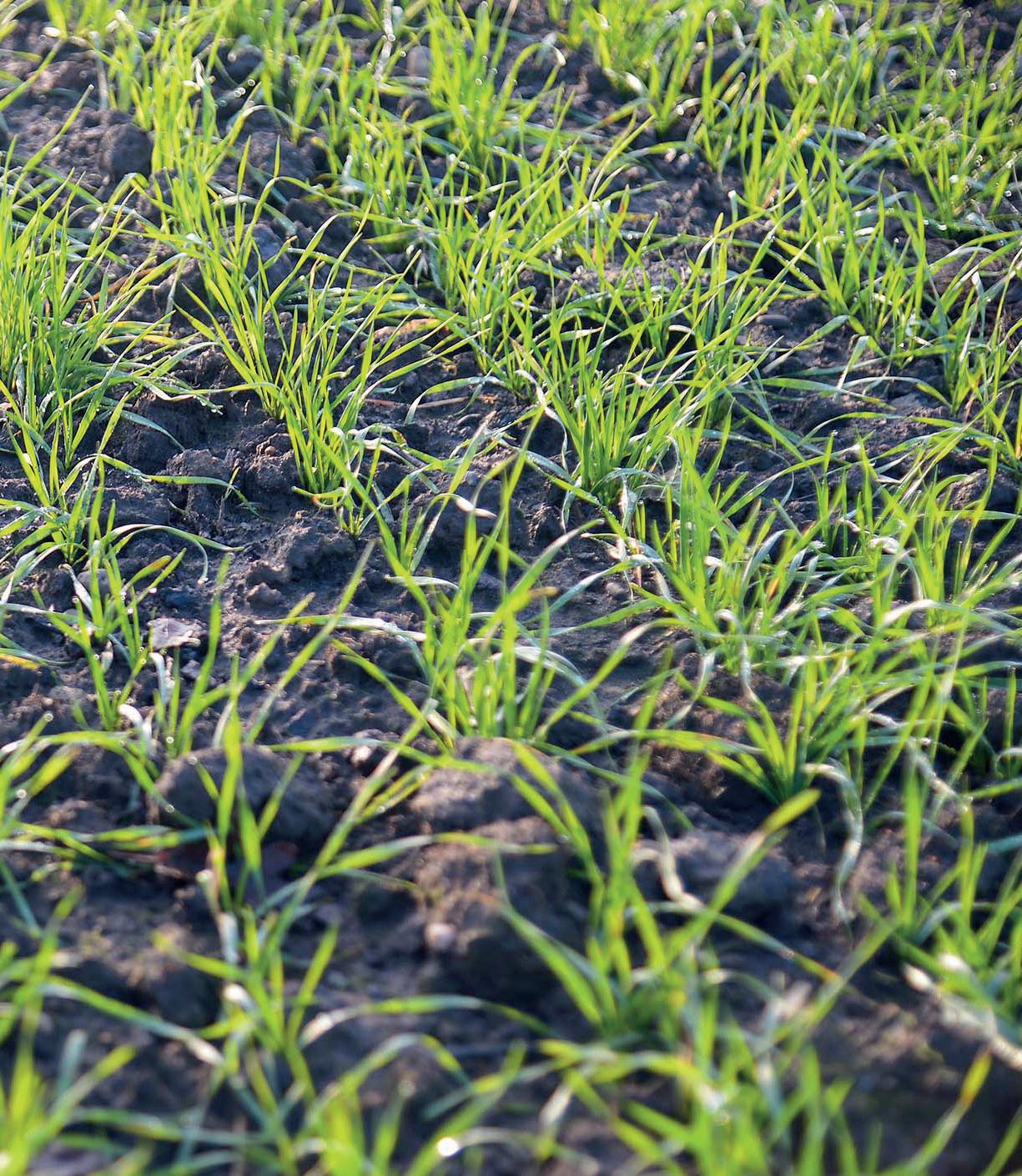
Dr Knight says: “Winter wheat exhibited a significant yield increase, with a 7.5% boost over untreated seed and a 5:1 ROI. We expect to see these
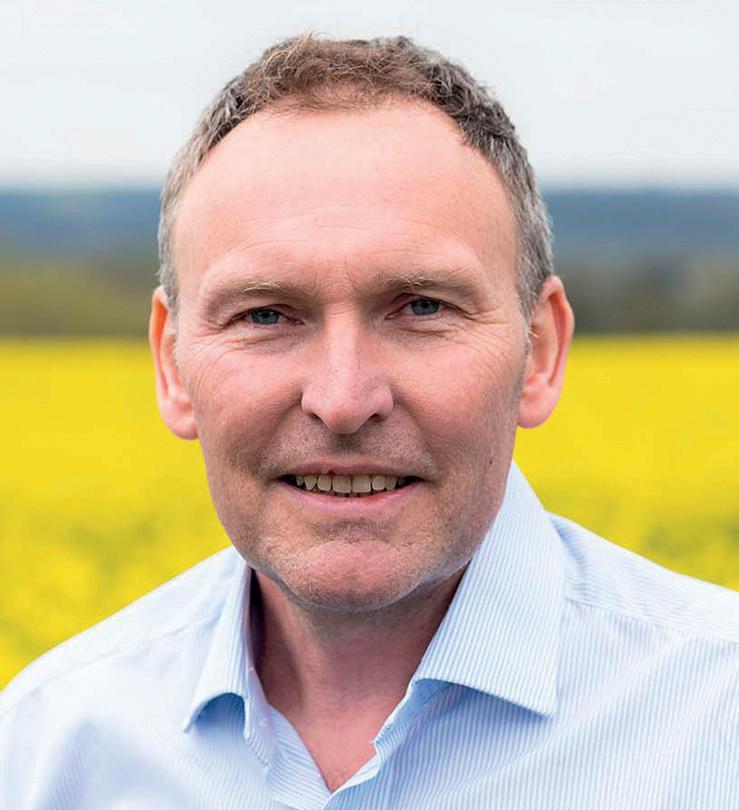
same results repeated domestically when we validate those trials this year.”
The UK places no restrictions on using bacillus as a seed treatment. However, the company’s existing production commitments – all its products are manufactured in the UK – means they will focus on completing those UK field trials during spring, with an expected market launch in autumn this year.
“There’s a lag between current legislation and the science; there’s no route to formally register a novel bacterial inoculant like bacillus.
Quality control
“But as a science-led company, we’ve a full dossier, including large volume production schematics, quality control and testing protocols, full bacterial genome analysis to show their safety and provenance, and the field trials to show efficacy. All this puts Rootfix on track for launch in several EU countries too.”
Dr Knight says pricing for Rootfix won’t be confirmed until a distribution agreement is confirmed.
“But it’s a conventionally applied, bulk seed treatment, easily carried out by a merchant. Depending on seed rate, it might cost around £15/ha. At current wheat prices, that represents very good value in anticipation of an extra 0.6t/ha for treated crops.”
45 SEED TREATMENTS TECHNICAL FEBRUARY 2023
Winter wheat exhibited a significant yield increase, with a 7.5% boost over untreated seed and a 5:1 ROI
DR BRUCE KNIGHT
Delving into septoria
A new study to unravel the genetic basis of septoria tritici resistance in wheat is underway. Andrew Blake reports.
How is it that a wheat variety which resists septoria for some time suddenly succumbs to the disease?
That is what a Birmingham University team hopes to discover through access to AHDB Recommended List trial sites.
Molecular plant pathologist Dr Graeme Kettles is collaborating with Dr Megan McDonald of the university’s school of biosciences on the project.
Dr Kettles says: “We work on the same pathogen but have different expertise, so finding out what was happening to cause resistance breakdowns in UK wheat fields seemed like a natural collaboration.”

The variety Cougar showed consistently high levels of resistance until 2015 when moderate levels of the disease were observed.
Initial AHDB-funded work led by the NIAB United Kingdom Cereal Pathogen
Virulence Survey team showed a septoria variant could overcome

some of Cougar’s resistance genes. Since then, varieties with Cougar in their parentages have suffered more from the disease than might have been expected.
Based on RL harvest 2022 results, the Cougar strain of septoria now appears more widespread, but there is evidence it is still localised to certain regions.
The use of Cougar in breeding programmes means the RL 2023/24 features several varieties with Cougar in their backgrounds.
Academic interest welcomed
JRuth Bryant, RAGT breeding pathologist, says: “As breeders, we always welcome interest from the academic community on subjects that are important to us.
“Septoria is our most economically important disease of wheat in Europe so the more we understand about it, the better.
“Breakdown of the Cougar resistance has been extremely disappointing for the wheat breeding community as many of our newer varieties contain this resistance and there are limited alternative genetic options.
“Deploying resistance genes in a strategic way is extremely difficult because there are so many other factors that
However, varietal resistance is due to the cumulative effect of multiple genes. So, the contribution of Cougar resistance and the shift in disease resistance in each of these varieties differs.
The new study began last summer and is open-ended, says Dr Kettles.
Funding
The project currently has no dedicated funding, but was helped by a small pump-priming grant from the University of Birmingham in 2021.
“AHDB has supplied information about its UK-wide network of trial sites and given us permission to sample at these locations. This allowed us to identify several sites across the UK with particularly high septoria disease pressure,” says Dr Kettles.
These sites are likely hotspots for mutations in the fungus which lead to the emergence of new, more virulent isolates, he says.
are important in a commercial variety. In an ideal world, we would ensure that each variety we released contained numerous resistance genes that were durable, mechanistically different and came without negative effects on other traits, such as yield and quality.

“Although we have some idea of the science behind septoria resistance, we are much more ignorant about the pathogen.
“If Birmingham University can uncover the scientific reason for the breakdown, we should be able to use this information to protect other resistances and perhaps improve our disease monitoring systems.”
“So far, we’ve produced a collection of more than 600 fungal isolates that were causing disease in AHDB trial sites in the 2022 season. This project has the potential to evolve into a long-term monitoring program that would allow us to monitor specific changes in the fungal population over time.”
The research has two aims.
“Firstly, we want to know the identity of the fungal genes that mutate and allow the fungus to ‘break’ previously effective wheat resistance,” he says.
“Secondly, we want to use genome sequencing to understand the diversity present in the UK fungal population.
“When this information is brought together, we should have a very effective tool to rapidly identify potentially dangerous changes in the pathogen population from one year to the next.”
He likens the exercise to the huge sequencing effort which
RESEARCH IN ACTION 46 FEBRUARY 2023
If you understand how a pathogen is changing, then you can deploy measures to limit or stop the damage
DR GRAEME KETTLES
The sampling team, left to right: Dr Megan McDonald, PhD student Haider Ali and Dr Graeme Kettles.
went into understanding how the Sars virus, which causes Covid-19, evolved.
“As in our battle against Covid-19, if you understand how a pathogen is changing, then you can deploy countermeasures to limit or stop the damage.”
In practice, the work with AHDB has involved visiting several field sites and sampling thousands of
leaves with obvious symptoms of septoria disease.
“Once we get them back in the lab, we have the rather laborious task of ‘picking’ fungal fruiting bodies from leaves under a microscope and then growing them on agar plates.
“Once we have each isolate in culture, these are then frozen to make a collection that will be accessible for many years. Our

Find Jobs Faster

future work will make use of whole genome sequencing to understand the differences between these isolates.
Organism
“During our initial culturing from infected leaves, we noticed septoria was often accompanied by growth of a red yeast-like organism that is currently unidentified.
Sussing septoria
rBirmingham University study from summer 2022
rAHDB trial sites access


rAims to provide a tool to give early warning of septoria resistance breakdown
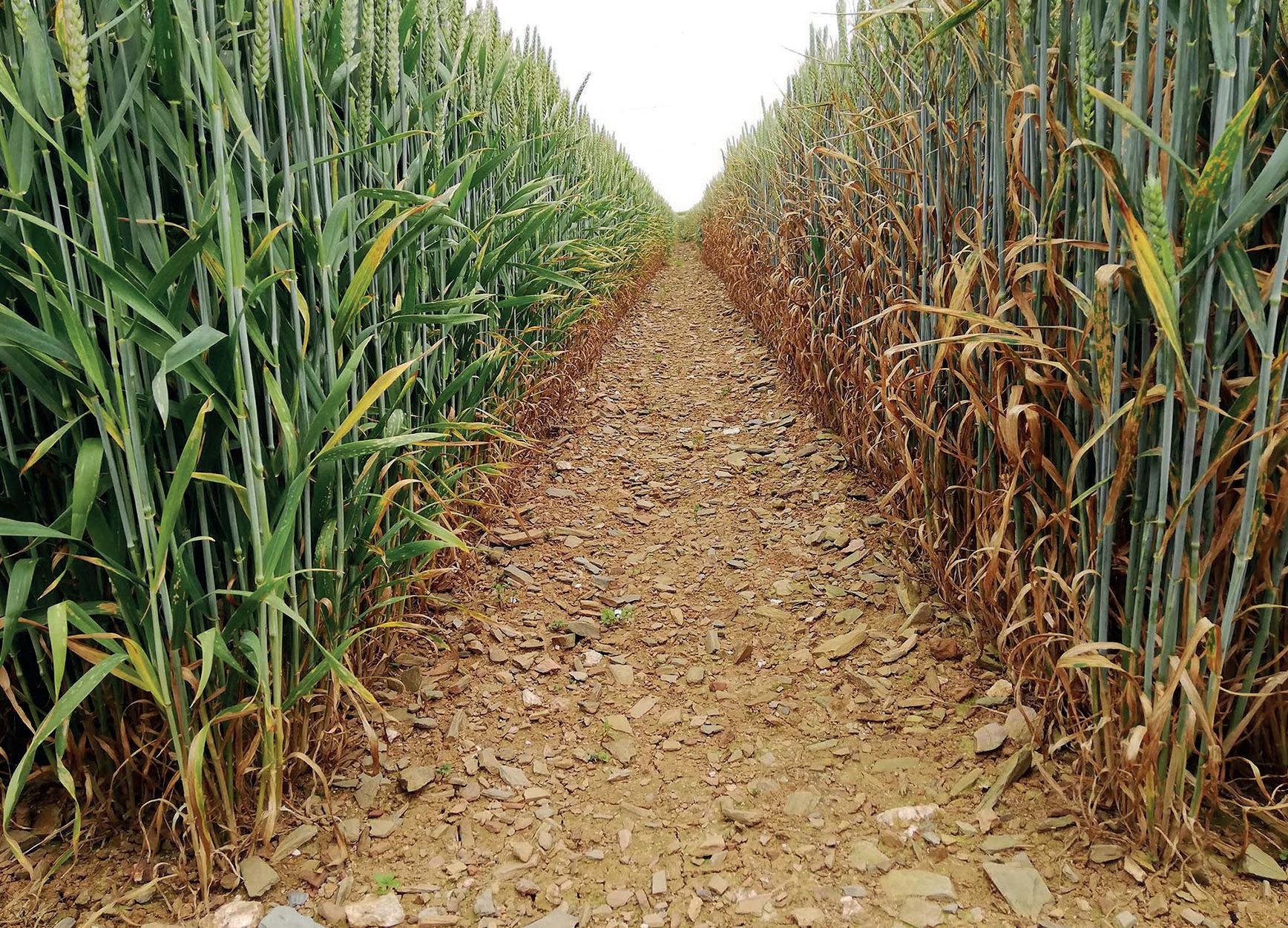
rInitial £5,000 funding from the university; UK Research and Innovation grant sought
“An undergraduate student has begun a side project to identify this hitchhiker and uncover its relationship to septoria.”
Given the project has only recently begun, there are no major findings to report, he admits.
“This project currently has no dedicated funding, although we are applying to UK Research and Innovation for significant backing which could allow us to use our new collection to understand how the UK septoria population is changing.
“With that we hope the collection we now have will allow us to get to the bottom of why this fungus is such an adaptable and dangerous pathogen.”
By understanding how the pathogen rapidly adapts to varietal resistance, it may one day be possible to predict resistance breakdowns and issue early warnings to growers, Dr Kettles says.
47 RESEARCH IN ACTION FEBRUARY 2023 JobsInAgriculture Jobs in your field Let us keep you updated by email and never miss another great job JobsInAgriculture.com
the latest jobs in your inbox with our free email alert service
Receive
defence collapse
AHDB-funded research at Birmingham University is aiming to develop a way of rapidly identifying changes in the septoria population.
One promising application in arable farming for autonomous machines is soil sampling. Jane Carley reports on research to help multiple robots work together efficiently.
Robots working together to boost soil health
Amulti-robot system can identify problematic soils significantly more quickly than using random sampling.
Additionally, multi-robot systems have the ability to study a wider range of soil health indicators than some other precision farming approaches.

That is according to Laurence Roberts-Elliott, a postgraduate researcher at the University of Lincoln, who says satellite imaging and remote sensing offer a quick way of acquiring data over a large area.
“Drones can cover more ground than robots, so multiple units are not needed. But robots can be used to study a range of
the project

soil health indicators, including compaction,” he says.
Soil compaction is recognised as a key driver of soil degradation, which can challenge agricultural productivity.
Compaction
Addressing compaction on a field scale can incur high fuel costs and while a targeted approach is much more cost effective, it requires knowledge of spatial variability to identify
compaction hotspots in a field.
As such, high resolution mapping of soil compaction is essential to address such issues while minimising remediation input costs.
Soil compaction is traditionally measured manually with handheld instruments – a time-consuming and costly process. Manual sampling often takes fewer measurements to reduce time requirements, obtaining low-resolution data, and does not prioritise areas that should provide the greatest increase in map quality.
Using an automated penetrometer mounted on an agricultural robot platform to collect and analyse soil penetration resistance data allows sampling at different depths and mapping in 3D.
However, single-robot ground-based soil mapping is too slow to compete with manual sampling and is less
optimal than performing the same task with multiple robots, as they can each localise their sampling to different regions of the field, requiring each robot to travel less distance between samples.
“Soil mapping is a coverage problem, but with large spatial variations in soil compaction, sampling should be optimised using dynamic sampling, identifying the locations which provide the greatest information gain to environment modelling,” says Mr Roberts-Elliott.
Sampling
“A multi-robot system can also parallelise the sampling process and reduce the overall sampling time.”
In this study, he used a 2D simulation to incorporate multiple robots in soil compaction mapping, testing different methodologies to further reduce
48 MACHINERY PRECISION FEBRUARY 2023 52 Latest kit shines bright at LAMMA – tractors and loaders 54 Trailers and tankers on show 56 Technology and robotic highlights 58 Sprayers and spray tech 61 Cultivators and crop establishment equipment Also in this section
JLincoln Agri Robotics is a £6.4 million project funded by the Expanding Excellence in England fund via Research England.
About
While early work at Lincoln Agri Robotics has focused on single robots, research now looks to co-ordinate the work of multiple machines for greater efficiencies.
the time required to create an accurate map.
The modelling framework deployed abstract robots as agents located within the cells of a 2D grid representing an open arable field.
“A major challenge in multi-robot systems is ensuring efficient co-ordination among
the robots. Multi-robot task allocation is one of the many strategies commonly used to address this challenge,” says Mr Roberts-Elliott.
Dr Jaime Pulido Fentanes, of Lincoln’s agri-robotics team, who previously led work into single-robot soil compaction mapping using Saga Robotics’ Thorvald agricultural robot platform, deployed a method known

PRECISION AND TECHNOLOGY in
a lighter package
Light and Effective

Designed to work with light tractors to limit soil compaction and reduce fuel consumption.
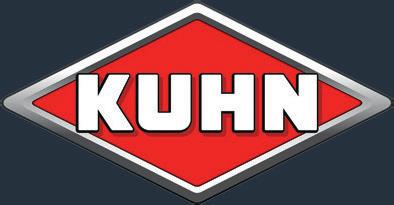
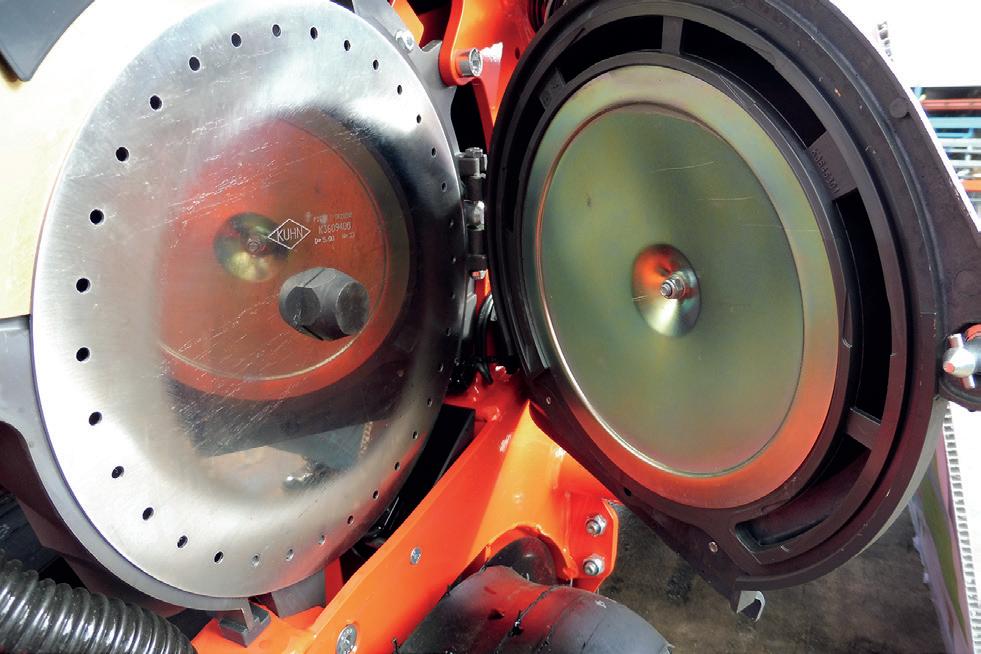

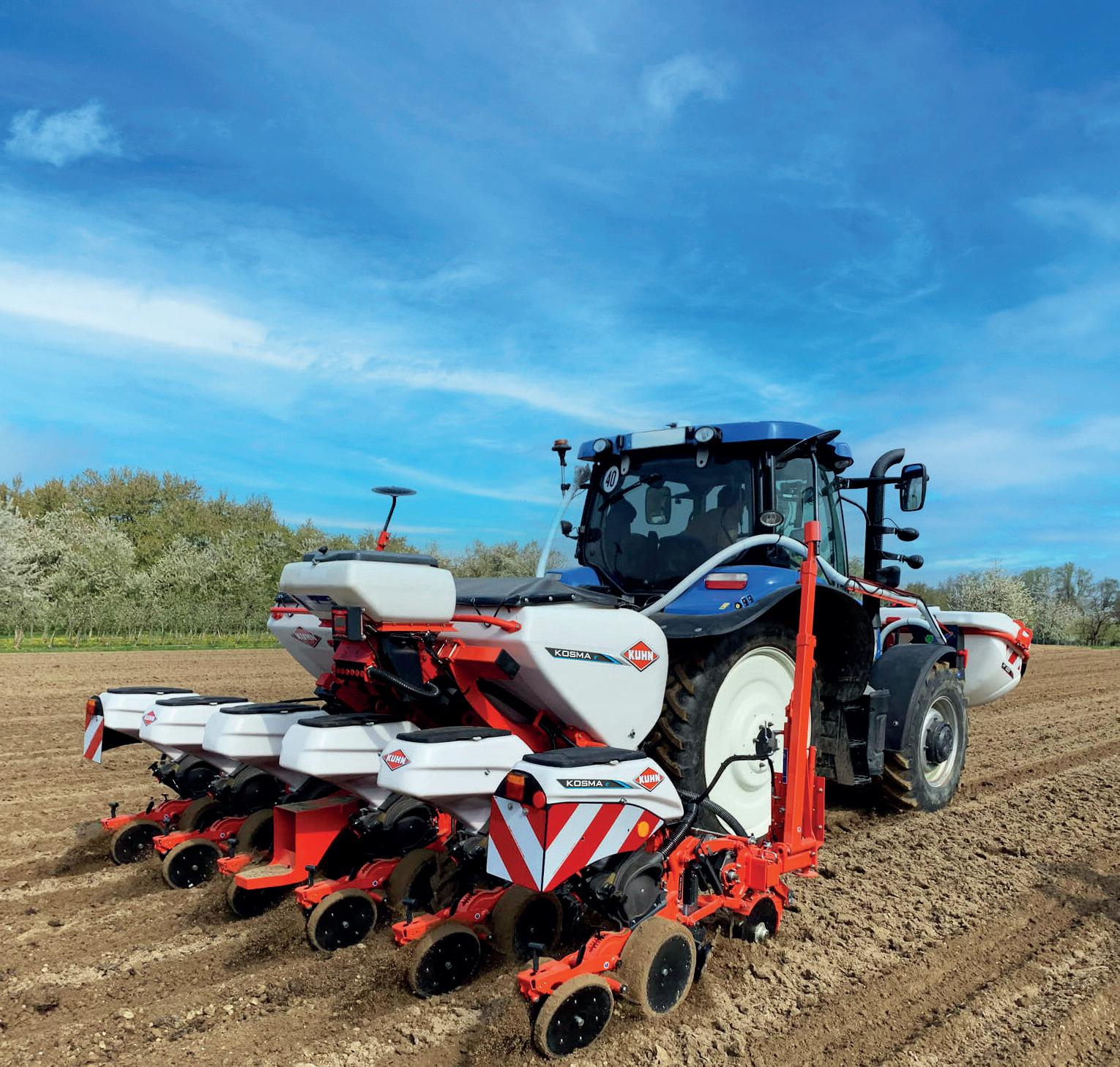
49 PRECISION MACHINERY FEBRUARY 2023
KOSMA
precision seeding unit
Lightweight
The variance in samples is a measure of uncertainty which helps guide the sampling locations
LAURENCE ROBERTS-ELLIOTT X
MACHINERY PRECISION
as ‘kriging interpolation’ to predict soil property values in unsampled locations, using the value and position of sampled data, and to identify informative sampling locations.
The method gives estimated values for any spatial location and provides a variance function that indicates the accuracy of estimation for any point in the map.
Mr Roberts-Elliott extended this approach for simultaneous identification of multiple task locations for a multi-robot system, reducing the number of samples needed for accurate mapping.
“Interpolation of the samples gives a prediction of the soil property values. The variance in samples is a measure of uncertainty which helps guide the sampling locations – it prioritises areas of the field where the uncertainty is greater.
Variations
“Task allocation and dynamic sampling is more optimal for a multi-robot system. A single robot may take random samples and then be targeted to the greatest variations.
“Using dynamic sampling, the data is refreshed each time a sample is collected so the interpretation of sampling sites is constantly improving,
guiding the choice of sites to look for data,” says Mr Roberts-Elliott.
Multi-robots are currently co-ordinated via a central server. This may be extended to a more distributed (localised) system in the future to avoid issues with internet connection. The robots work independently but avoid collisions with each other using path planning and sensors.
Task allocation and path planning systems used in the work can be extended to avoid robots retreading ground they have already driven over during the sampling mission, reducing the soil compaction contributed by the robots themselves, adds Mr Roberts-Elliott.
Each robot is allocated an initial location and subsequent locations are planned in two ways – from absorption of the data collected and an auction-based approach with the robot ‘bidding’ for the next task dependent on how far it is from a sampling site.
“This is designed to reduce the amount of time spent travelling between the sampling tasks and increase efficiency of the sampling path,” Mr Roberts-Elliott says.
The results showed that the ‘auction-based’ method, combined with random sampling of unsampled cells, came out top, achieving the best performance across four of the seven metrics recorded.
Methodology
While the simulation was based on data from Saga Robotics’ Thorvald robots used in the single robot research, the methodology is agnostic of robot platforms so can be easily deployed on other systems.
The low complexity of this study, when compared to 3D simulations, meant experiments could be conducted very quickly. But a move to 3D simulation in the next phase of research will study how to direct sampling at
different depths, before progressing to building software for real-life experiments.
“The more performant methodologies for multi-robot soil mapping identified using this abstract simulation will later be implemented as a physical multi-robot soil mapping system, saving vast amounts of time that would be required to adequately test a wide range of approaches using a real-world multi-robot system,” says Mr Roberts-Elliott.
“It will be interesting to see how it will scale with different numbers of robots in various field sizes. There’s also the potential for adding sensors for other soil properties, especially where they are related, such as soil moisture and compaction, and this could also inform sampling locations.

“Faster sampling may also allow us to more accurately capture soil properties across the field that vary a lot over time, e.g. soil moisture.”

50
FEBRUARY 2023
There’s also the potential for adding sensors for other soil properties, especially where they are related
LAURENCE ROBERTS-ELLIOTT
Use of a multi-robot system can identify problematic soil more quickly than random sampling, say Lincoln University researchers.
IntroducingVäderstadNZExtreme1250-1425







51 PRECISION MACHINERY FEBRUARY 2023 Learnmoreatvaderstad.com NZExtreme Seedbedpreparation atanewlevel
performancewhenitcomestoseedbedpreparation.
High-qualitydesign,excellentfieldperformanceandagreatcapacity-Introducingthe all-new12.5to14.25mwideheavy-dutytineharrowVäderstadNZExtreme1250-1425. Withdepthprecisionasitsspecialty,NZExtremesetsanewstandardforfield
Using field robots to carry out soil sampling allows a wider range of information to be gathered than using other sensing methods.
Valtra Q Series

JBridging the gap between Valtra’s T and S Series, the Q offers a power range of 230hp to 300hp delivered from an Agco Power 7.4-litre, six-cylinder engine and CVT transmission.
Standard features include Valtra’s twin airbag front suspension, with hydraulic capacities extending to 200 litres/minute and a maximum rear lift capacity of 10 tonnes.
The new look cab provides a digital pillar display giving the operator essentials and a smart touch-screen delivering operator controls and adjustments.
Custom build options are available to suit operator needs, with auto comfort air suspension on the cab. Smart touch options extend to include extra screens for GPS guidance and camera systems.
Held at the NEC, Birmingham, and returning to its traditional January slot, LAMMA offered visitors an opportunity to view a wide range of new machinery and technology. Jane Carley, James Huyton and Toby Whatley report.


Latest kit shines at LAMMA
Tractors and loaders
Deutz Fahr 6.4 Series

JDeutz Fahr extended its mid-power range with the introduction of the new 6.4 Series, offering further options in its range of compact high-horsepower four-cylinder tractors.
The 6.4 delivers 136156hp with boost from the company’s in-house assembled FARMotion45 Stage V engine.
The brand aims to deliver a versatile mid-range tractor capable of draft and loader

applications. Units can be specified with the RV powershift transmission or alternatively the TTV continuously variable transmission version.

Category 3 rear lift with a capacity of 5,870kg as standard or 9,170kg with assister rams. Front axle suspension is available alongside mechanical or pneumatic cab suspension. For precision farming applications, the iMontor can be specified providing full IsoBus control.
Bobcat TL25.60

JBobcat returned to the compact telehandler market with the introduction of the 2.5-tonne capacity TL25.60, which can lift to 5.9 metres.
At just 1.9m tall and 4.14m long, this model is firmly aimed at the poultry market to access lower buildings and, handily, the carriage can also accommodate attachments from the company’s skid
steers, which may already be a fixture in this type of business.
Powered by the firm’s 75hp D34 engine, it has 30kph hydrostatic drive and fourwheel steer, while a full-size cab with simple fold back driver’s door window avoids the cramped feeling usually associated with this type of machine.

MACHINERY LAMMA
52 FEBRUARY 2023
Fendt Gen 7 700 Vario
JFendt’s new Gen 7 700 Vario was a highlight of the company’s stand, featuring Agco’s new Core 25 Agco Power Tier V engine and the Fendt iD low rev high torque

system, designed to reduce fuel consumption.
With some crossover into the 800 Vario at 203-283hp, the compact design is likely to appeal to Gen 6 customers
Volvo L110H Agriculture
JWell-established in the quarrying and construction sector, Volvo has had a mixed history in agriculture.
Following a realignment of the UK business, distributor SMT GB has a renewed focus on the agricultural sector, with a range of machines from 12-23 tonnes specifically adapted for agricultural users.
Changes include torque lock-up transmissions offered as standard, a wider choice of tyres, an automatic reversible cooling fan and additional LED lighting.
The demonstrated L110H loader is the second largest in the range and is powered using a 7.8-litre 260hp, 1,255 N/m Volvo engine. The 20t machine uses Volvo’s unique torque parallel boom which is claimed to allow the tear-out advantage of a Z-bar system alongside the improved visibility of a parallel lift system.
Operators can choose from several cab options including joystick or three-spool boom operation and combined steering wheel/joystick direction control.

looking for more power without going up in series.

Fendt also highlights its manoeuvrability with a separate drive to the front axle pulling the tractor through the turn.
Manitou MLT850-145
JOccupying a position midway through the brand’s Ag-XL telehandler range, the French manufacturer MLT850-145 is designed to offer loading shovel capabilities with additional forward reach. Power is supplied from a 141hp Yanmar Stage V engine with the model claiming the highest tear-out force of the Manitou range.
Maximum lift and reach capacities extend to five tonnes and 7.6 metres
respectively, with up to 200 litre/minute hydraulic flows with flow sharing.
Three specification levels are offered, with options including LED lighting, auto-lubrication and offside and boom-head cameras.
The overall machine width of 2.48m allows for a wider cab and cooling pack, and an overall height of 2.58m. Manitou says the increased height allows improved visibility across the whole machine.
Continues over the page.

53 FEBRUARY 2023
Merlo Multifarmer 44.9CS

JShown for the first time at a major UK event and representing the largest model in the range, the 170hp, Stage V Multifarmer 44.9CS from Merlo is claimed to be positioned to offer a full-capacity telehandler with the additional feature of a three-point linkage and pto for operation as a secondary tractor.
A maximum lift capacity of
Krone GX wagon
JLaunched to the UK market at the event, the GX wagon from Krone represents the manufacturer’s move into the field logistics sector.


The design uses many features on the firm’s ZX and TX forage wagons and silage trailers, including hydraulic suspension and conveying floor for unloading. Currently offered in two models, the 440 and 520 with 44cu.m and 52cu.m capacity respectively, can be fitted with twin or triple axles with a choice of electric or mechanical steering.
The sides of the unit can be hydraulically lowered allowing a reduced drop height when working with root crops in
4.4 tonnes is offered, with a maximum lift height of nine metres for the machine’s telehandler functions. The rear linkage provides a 7.5t capacity and a two-speed pto.
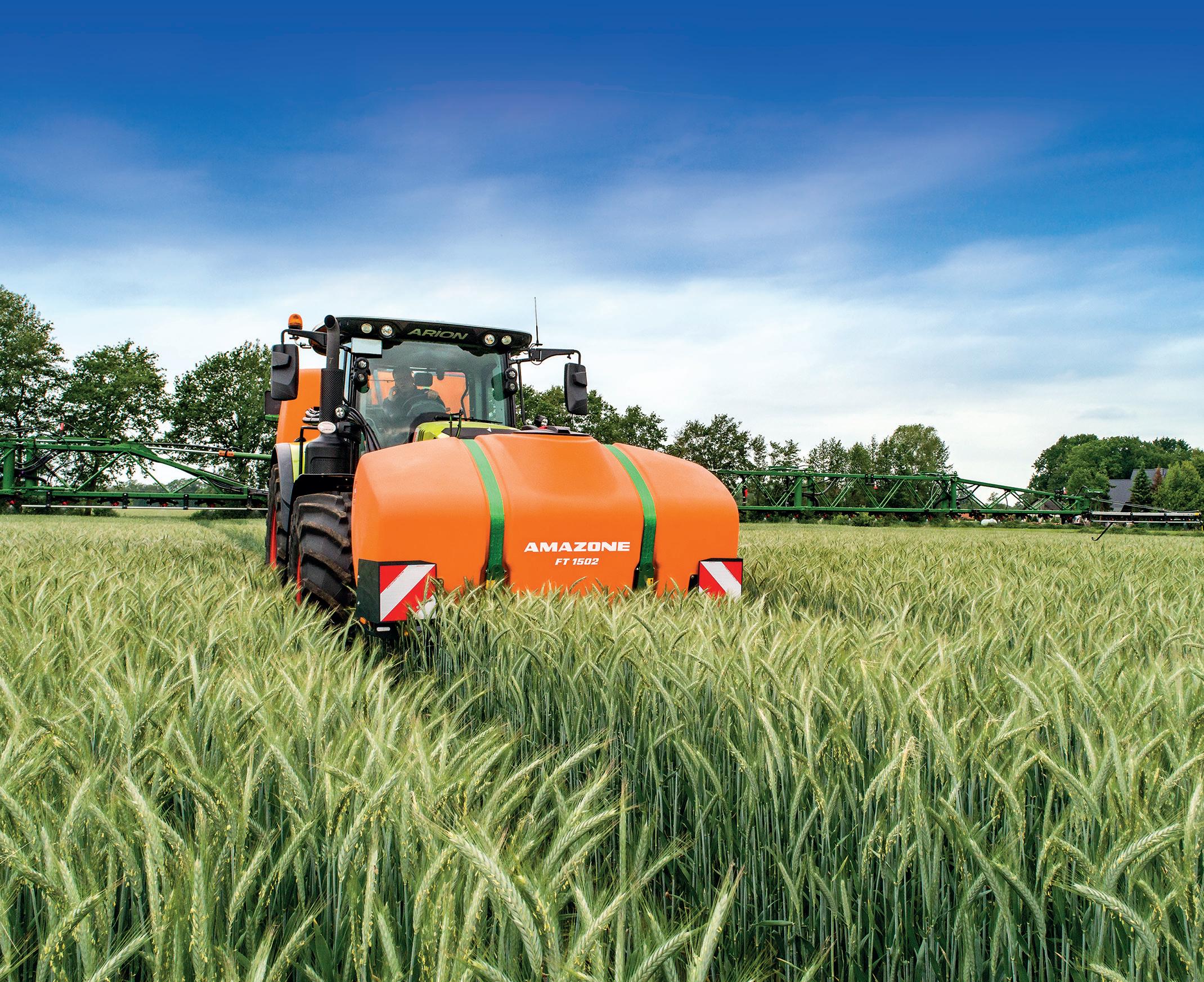
Up to four rear spools are offered with 125 litre/minute hydraulic flows.
The manufacturer claims the combination offers users
the ability to operate the machine as a conventional handler with the additional ability to power implements including slurry pumps, wood chippers and snowblowers
Trailers and tankers
without the need for a secondary tractor.
The CS model includes full cab and boom suspension alongside a 40kph road speed. Prices start from £140,000
addition to a folding mesh cargo cover to secure the load.
Compression
Unloading is achieved using a conveying floor and moving
headboard, which is claimed to prevent compression of the load.
Users looking to unload evenly over a clamp or drying floor can specify the ExactUnload option. This adjusts the unloading
HM Trailers HL20
JCommanding a significant presence on the HM Trailers stand, the triple-axle HL20 hook lift is designed to allow users greater flexibility by expanding the range of tasks for which the trailer chassis can be used, says the firm.
Demonstrated with a 20-tonne half-pipe body, a range of bodies can be supplied including tankers, flatbeds and grain/silage combinations.
speed of the conveyor based on the unloading area length and forward speed of the trailer.
The maximum gross weights of the two models are 31 and 34 tonnes.

Despite the trailer length, the unit does not include steering axles due to the point loads when lifting full containers onto the bed.
Unloading
However, both the front and rear axles can be raised to improve manoeuvrability, and the whole chassis lowered to reduce the ramp over angle when loading and unloading skips.
54
FEBRUARY 2023
MACHINERY LAMMA
JKaweco, best known for its saddle tankers for the Claas Xerion, exhibited an example from its trailed tanker range, with trailing shoe applicator from preferred supplier Bomech, part of a range spanning nine to 30 metres. There is a wide choice
of tanker sizes and options from farmer to contractor specification up to triaxle versions, but the 18,000litre tandem axle is the most popular model in the UK.

Kaweco offers the Easybus control system which operates via its own or tractor terminals.
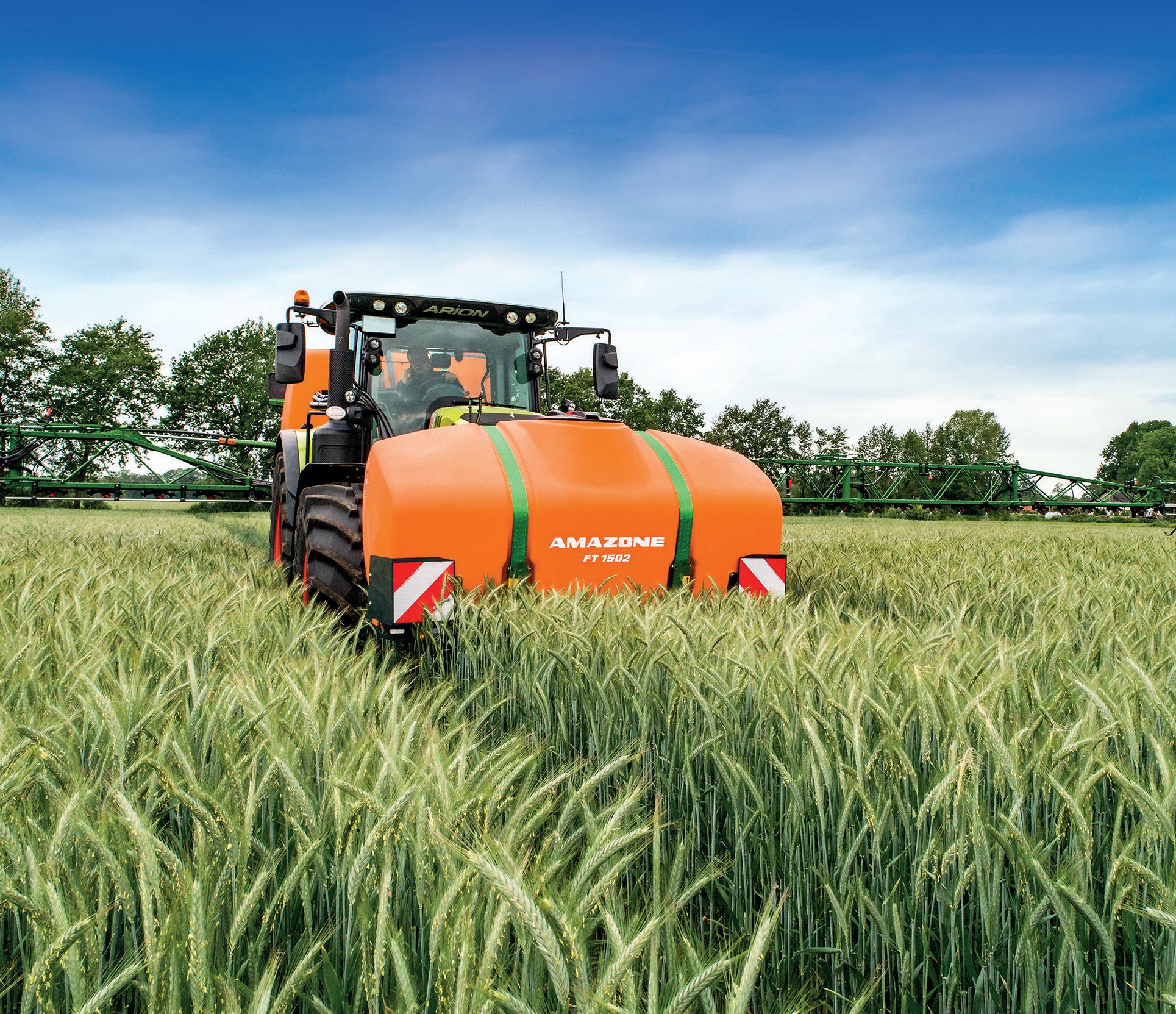
Leading from the front
The AMAZONE FT front tank, you wouldn’t even know it was there
With the AMAZONE UF sprayer, its reputation goes before it. That well-proven formula of induction bowl performance, boom ride and nozzle control coupled with its exceptional build quality and reliability has made the UF what it is today.

When you are looking for increased work rates from a wraparound sprayer combination, there’s adding just extra capacity and then there’s adding AMAZONE convenience and comfort. All that connects the AMAZONE FT to the rear-mounted UF sprayer is just a cable and 2” feed and return pipes. After that technology takes over and you don’t even know a front tank is there.
Simplicity, performance, capacity, AMAZONE.






















Contact your local dealer or phone us on 01302 755 725 www.amazone.co.uk myAMAZONE for higher output https://amazone.co.uk/myAMAZONE
over the page.
The perfectly balanced extended capacity Amazone UF Sprayer
Continues
Kaweco trailed tankers
Veenhuis injectors updated
JAgri Industry Solutions showed the new Veenhuis Fullject X-line grassland injector, developed with partner Schuitemaker.
The toolbar uses a linkage to allow movement and pressurisation of the disc as well as reducing maintenance requirement. Models are up to 15 metres and the injector uses Veenhuis’ macerator, designed to ensure even
distribution of slurry using positive pressure to maintain consistency on sideling ground.
The company says disc injectors have enduring popularity in the Netherlands due to the clean sward left behind and emission-beating placement.
Discs are constructed of three parts and are straight cut to ensure slurry is placed in the slot in hard conditions.
Technology and robotics
JFrench manufacturer Naio’s Orio field robot made its UK debut with importer Burdens, offering autonomous tool carrier capability for crops ranging from maize to salads and forestry. It can be fitted with a variety of tools, but Burdens expects particular interest for seeding, cultivations and mechanical weed control.


The robot is battery-powered with a claimed run time of eight hours, RTK guidance from field maps allows autonomous operation of Orio. Naio, which recently raised €32 million (£28m) capital funding, already has robots for vineyard and salad crop tasks in commercial production and launched a contract service in California last year.
Patchwork Technology
JPatchwork showed its latest Simply Steer retrofit autosteer kit, which offers RTK accuracy for under £5,000.
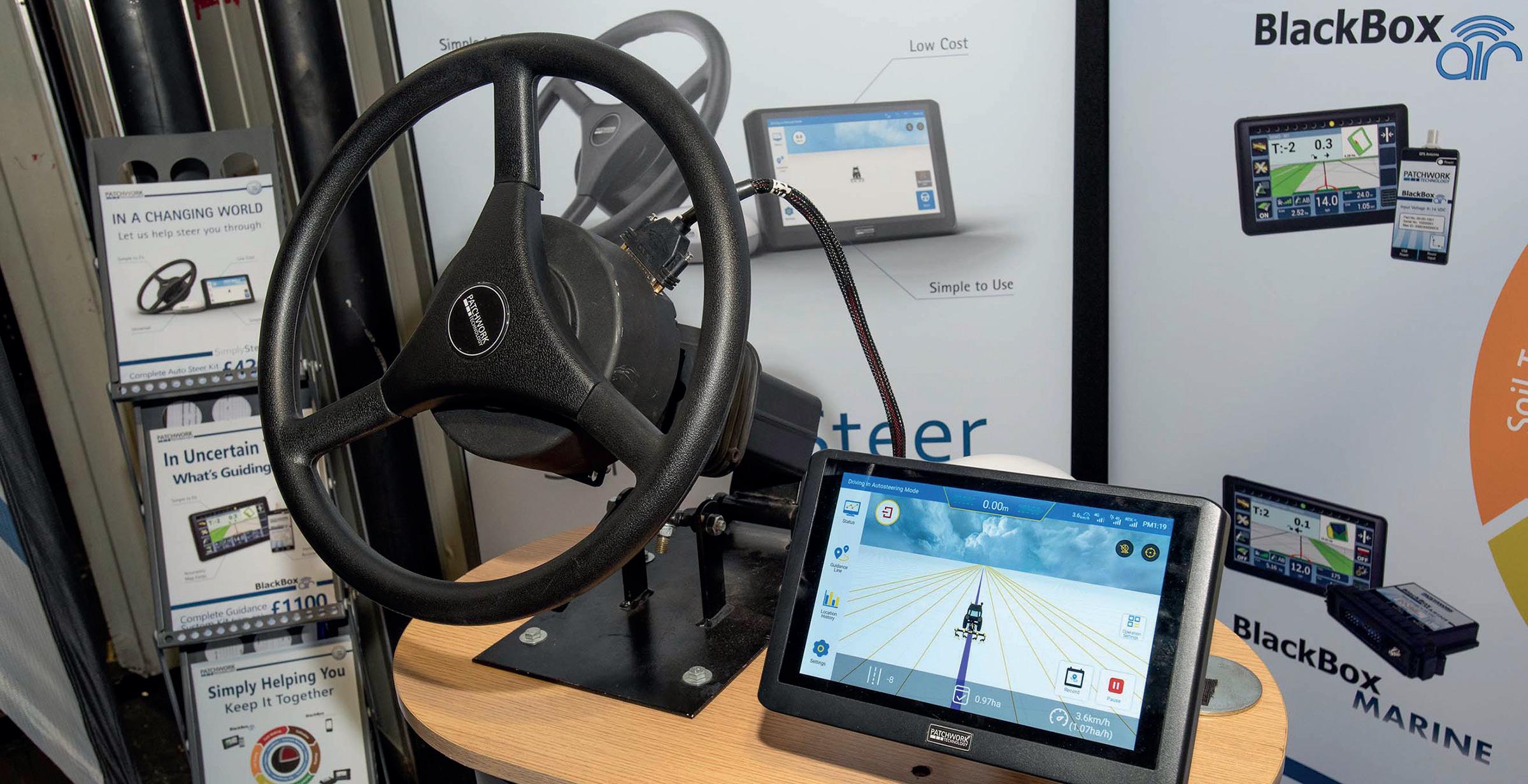
Designed for DIY fitting, the company says the kit can be up and running in half an hour, offering sufficient accuracy for drilling even with a basic Egnos signal.
RTK can be supplied by
tethering to a mobile phone, using minimal data, or with a roaming Sim.
The kit is aimed at farms with limited options for precision farming, the company has also seen demand for its data management services, which can be run from the company’s straightforward BlackBox terminal.



MACHINERY LAMMA 56 FEBRUARY 2023
Naio Orio
KTwo updates ejector trailer

JKTwo is now fitting hydraulic suspension to its Compact and Push ejector trailer, designed to balance the load on undulating or rutted ground, minimising compaction and allowing use for harvesting in difficult conditions.
BPW axles – hailing from the truck industry – provide this technology and 26.5in 600 tyres can now also be


fitted to further reduce ground pressure. The 20-tonne trailer has a capacity of 36cu.m, using a pusher mechanism to compress the load by up to 40%.
Height limited
The pusher can also be used for unloading rather than tipping the trailer, especially useful where height is limited.
Trimble modular displays

JDistributor Vantage Ag showed the latest Trimble GFX1060 and GFX-1260 10- and 12-inch screens, now offered as modular displays which can be customised to include IsoBusbased implement control, a


choice of guidance controllers and AutoSync for easy data sharing and work orders.
Upgrading is designed to be simple and remote access by Trimble service providers allows easy troubleshooting.
Continues over the page.

57 LAMMA MACHINERY FEBRUARY 2023 From combines to culitivators and everything in between, you’re sure to find what you need on FGBuyandSell.com. Start listing your items FREE today! Browse. Sell. Buy at FGBuyandSell.com
Kubota auto-steer extended
JKubota has introduced a new range of Topcon autosteer options for its M-Series tractors, which takes the technology to its M6002 range for the first time.
Topcon distributors LH Agro and Topcon Ireland will supply the auto-steering solutions through the Kubota dealer network, providing warranty, service and support.
Auto-steer kits include Topcon’s AGS-2 receiver and,
where required, Topcon’s AES35 motorised steering wheel to replace the tractor steering wheel. Additionally, customers can choose from a range of guidance screens including the 21.3cm X25, 31cm X35, 17.8cm XD and 30.7cm XD+ terminals.

Depending on the chosen kit, customers can also customise the task control options available, or choose from pre-configured bundles.
Metos UK DropSight

JMetos UK introduced DropSight, a simple-to-use spray coverage tool which works with a mobile phone to give spray operators instant information on the spray deposition efficiency of the sprayer.
UV liquid is placed into the sprayer tank and sprayed out, before leaf material from the crop is placed in a specially designed box where it can be photographed using a phone to allow the fluorescent droplets to be
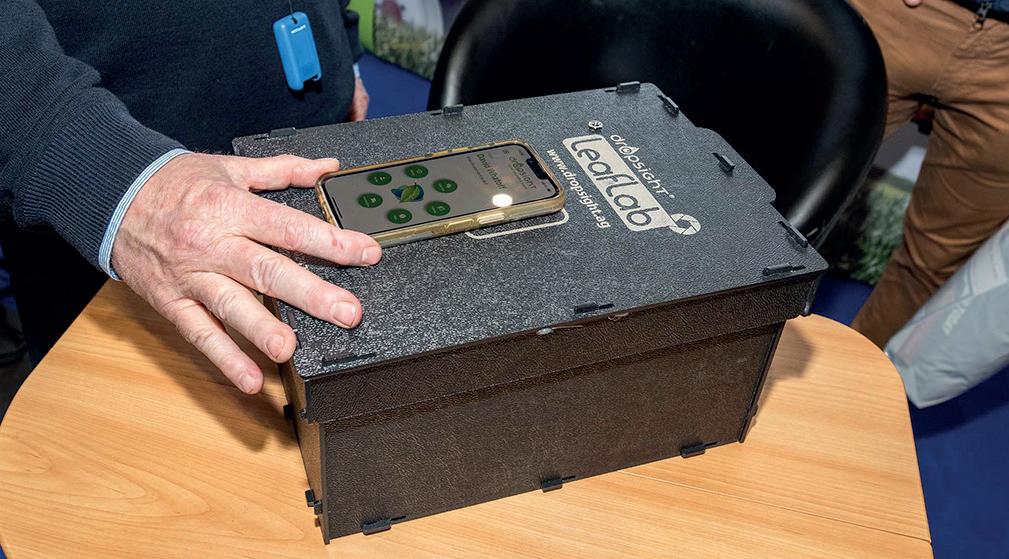
recorded. DropSight software recognises and quantifies the deposition of solution on each leaf, and measures and calculates the deposition efficacy of the spray application.
Operators can optimise nozzle selection and calibration, water volume, adjuvant selection, boom height and sprayer speed for best results.
The kit costs £495, which includes the first six months’ subscription.
JFilling a capacity opening in the Agrifac self-propelled range, the Condor Vanguard has a 6,000-litre tank and triple fold booms up to 48 metres. A narrow back frame helps

to improve boom ride, along with the latest version of StrictHeightPlus boom height control, which uses radar rather than ultrasound for enhanced consistency when

58 FEBRUARY 2023
Agrifac Vanguard
working as low as 300mm above the crop.

The company continues to progress with site-specific spraying, with parent company Exel developing its camera-
Horstine IsoBus controllers
guided spot spray system, designed to work with its pulse width modulation system. The Vanguard can also be fitted with 75- or 85-profile tyres for a larger footprint.

Househam Harrier
JHouseham Sprayers has made a number of improvements to the Harrier selfpropelled, which now has a new boom style to accommodate 25cm nozzle spacing with steel nozzle guards.
Boom height control is the latest Norac U7 system and 12 sections is standard with Hypro Duo React nozzle bodies. Individual nozzle control can be specified.
Househam’s Intelligent Transmission System works with the rate control system to regulate output when turning on the headland.
Michelin SprayBib tyres are fitted as standard, along with Claas-sourced cabs. A night spray package with additional floodlights and blue boom lights can be specified.

JChafer Horstine is now offering simple IsoBus controllers from partner Arag for its applicator range to offer rate control without the need for the previous Wizard switchbox. The company points out that products such as the TMAir, TwinAir and Microband

are often used alongside potato equipment, which may already have complex control set-ups to accommodate, so reducing cab clutter is welcomed by operators.
All are designed in-house, with the company offering full tech support.
Fendt Rogator updates
JFendt has made a number of updates to the Rogator selfpropelled sprayer including a new partnership with Altek to offer electronic nozzle control for improved accuracy for future functions, such as turn compensation and the company’s own developments in spot spraying.
The Fendt Conti-Rinse
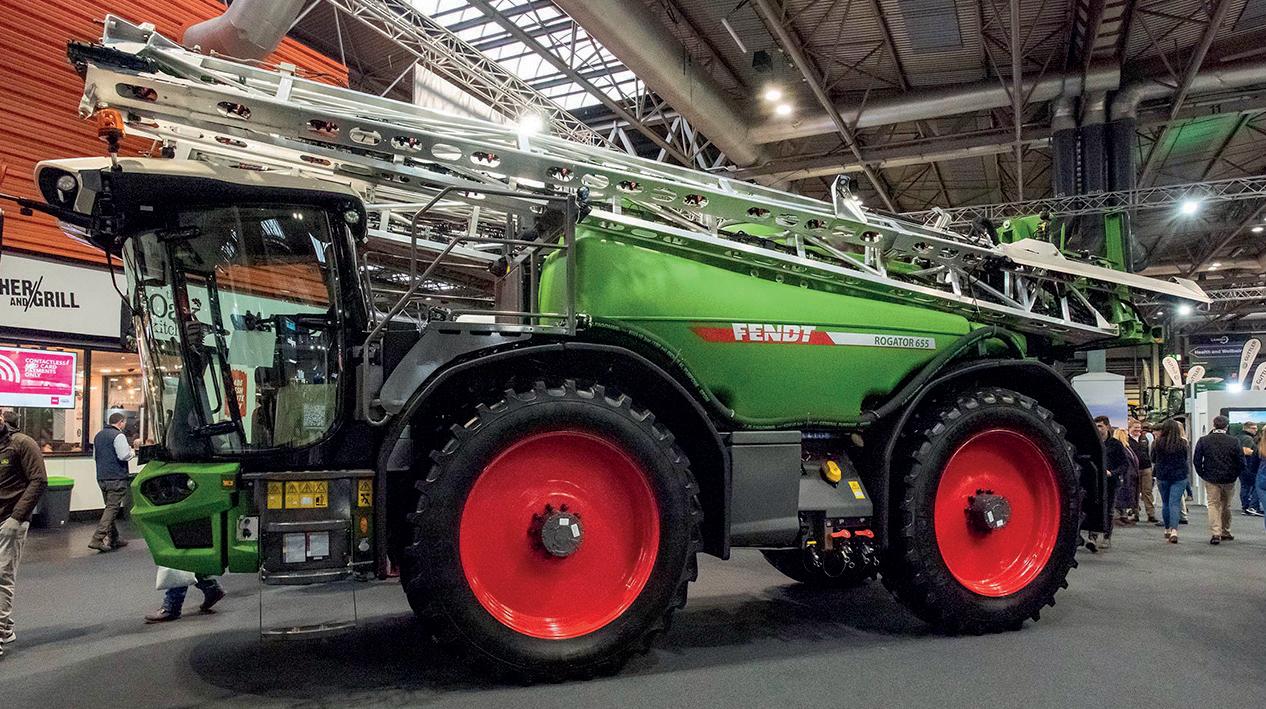
system now offers more efficient rinsing, using a new pump to fill from the clean water tank while still spraying out or travelling, thereby cutting downtime. Updated valves are designed for a longer running life and other improvements include a full LED light package and new cool box in the cab.
Continues over the page.
59 LAMMA MACHINERY FEBRUARY 2023
Sprayers and spray tech
Closed transfer looms
JDevelopments towards closed chemical transfer were on show from a number of plant protection manufacturers, with compatible spray cans the final link in the chain.

Syngenta’s new EvoPac design, for example, fits the Cleanload Nexus coupler, but can also be used to fill a conventional induction hopper.
The shape of the can makes for easier inversion onto the coupler and quantity graduations are printed
on the translucent cans in both directions for easy measurement of a part pack, whether inverted or not.
Cap and can are made of the same plastic compound for easy recycling.
Pentair Hypro, which is developing the Cleanload Nexus, says four leading sprayer manufacturers are looking at designs to incorporate the coupler on their machines as soon as the caps are rolled out.
Alpego Focus flail mower
JBest known for cultivators and drills, Alpego has updated its Focus line flail mower range to meet the needs of farms looking to manage vegetation in environmental schemes and mulch stubbles or cover
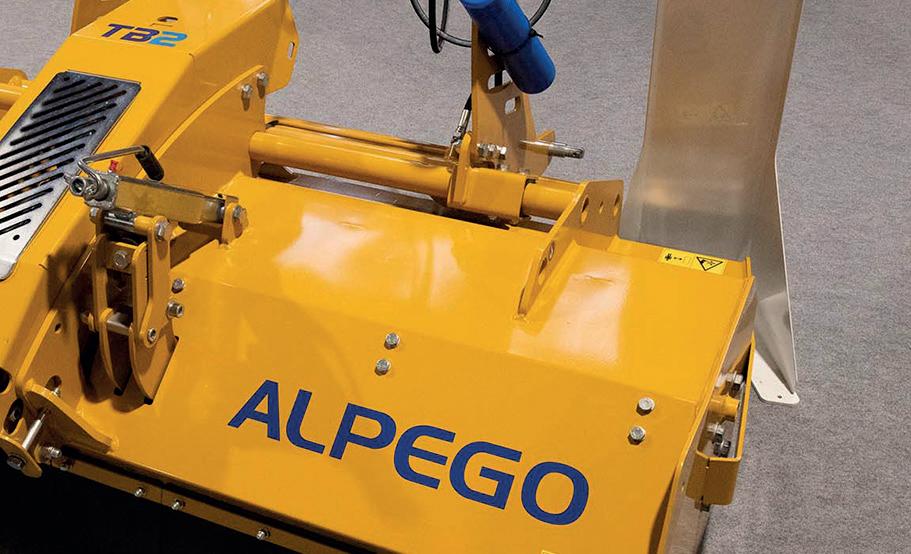
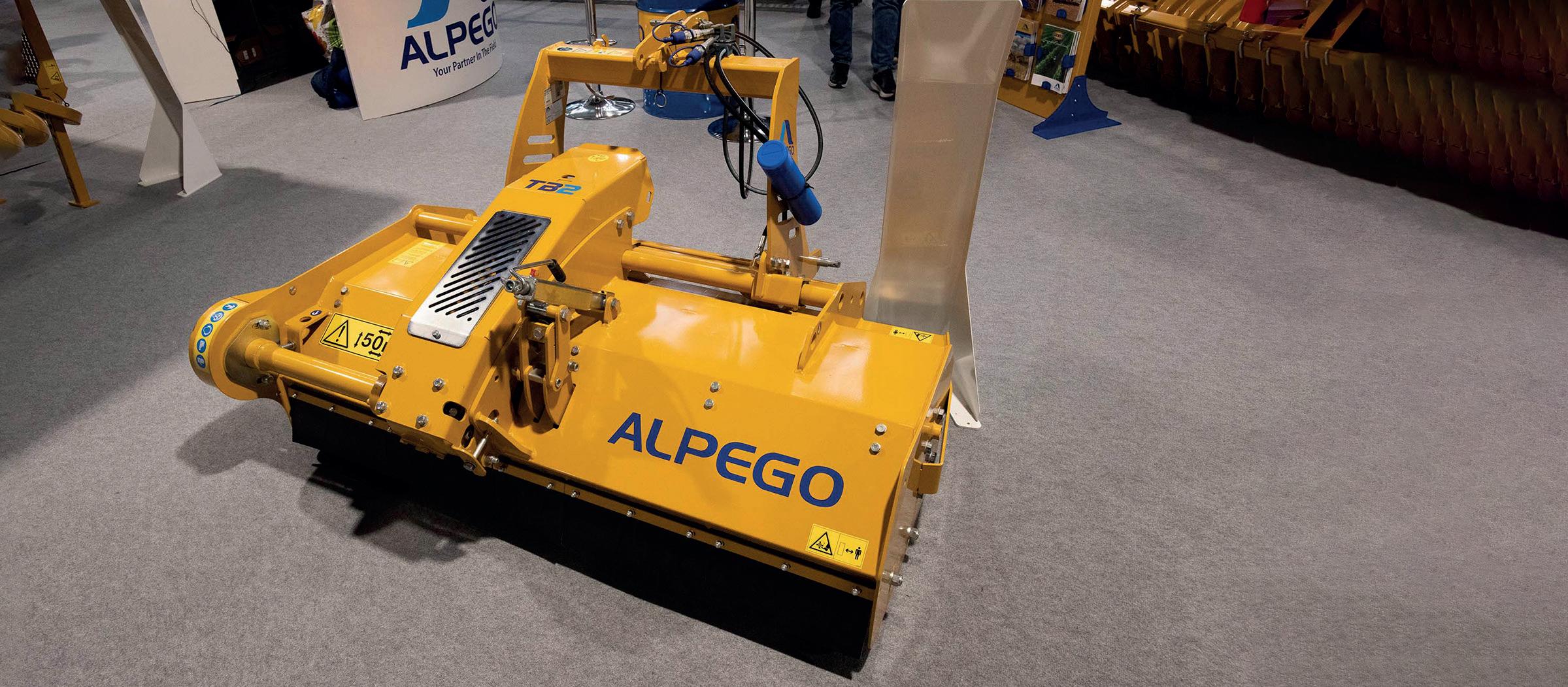
crops.
Rotors and gearboxes have



been beefed up to work with higher horsepower tractors. For example, the 2.8-metre cut TL50 can be combined with the front-mounted TR36 and TR56 models to give a cut width of 5m on a 200hp tractor.
A larger diameter roller is designed to handle heavier growth where material is cut less frequently.

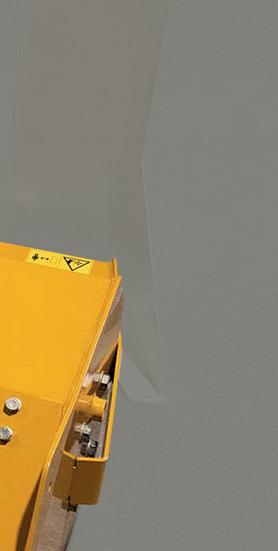
Teejet nozzle







JTeejet introduced the AccuPulse TwinJet APTJ nonair inclusion nozzle aimed at pulse width modulation applications and tested by JKI to offer 95% drift reduction. Its design recirculates the spray liquid before pushing it out of the orifice to produce a larger droplet, thus cutting drift.

Available in a full range of sizes, the nozzle can also be used on conventional nozzle bodies as a low drift option.

MACHINERY LAMMA 60 FEBRUARY 2023
New Energizer
JWeaving’s new six-metre
Energizer mounted cultivator offers shallow to medium depth post-harvest cultivation for tractors 180hp and above.
The machine has 36 tines using 40mm interchangeable points. The 167mm leg spacing allows improved trash flow through the machine, says the manufacturer.
Sectional replacement
Weaving’s unique V-ring roller allows sectional replacement of each ring without stripping apart the whole roller. Hydraulic rams offer adjustable depth control through the roller and aluminium spacers are used to set the final depth.
In transport, the machine folds to a width of 2.7 metres, with a LED road light kit.
Sulky Progress drill
JSulky’s latest combination drill can be specified with a single or split hopper, with the option to add a microgranule hopper for grain/fertiliser, sowing cover crop mixtures as straights or applying slug pellets or Avadex at drilling.
It is available in P2, P50 and P100 versions with Suffolk coulters, twin or single disc coulters respectively, and mounted on a power harrow or the Sulky XR two-row disc cultivator though it can be easily switched between the two.

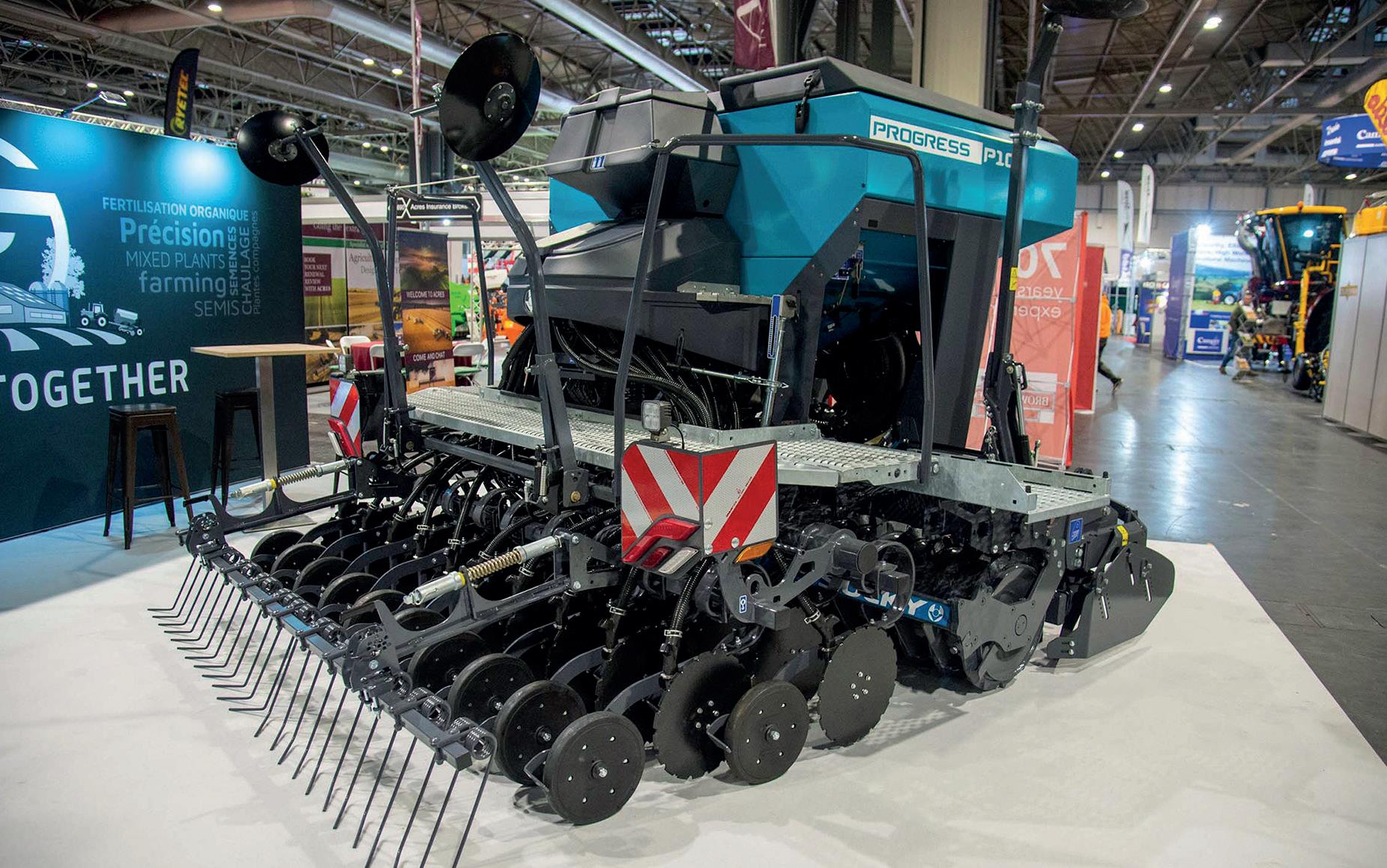
Control is via the Quartz 800 IsoBus terminal or tractor VT, allowing a choice of row configurations and half-width section control. Working widths are from three to six metres, with options including front tank versions.
Continues over the page.
61
FEBRUARY 2023
LAMMA MACHINERY
Cultivation, crop establishment and grain handling
Sumo inter-row cultivator
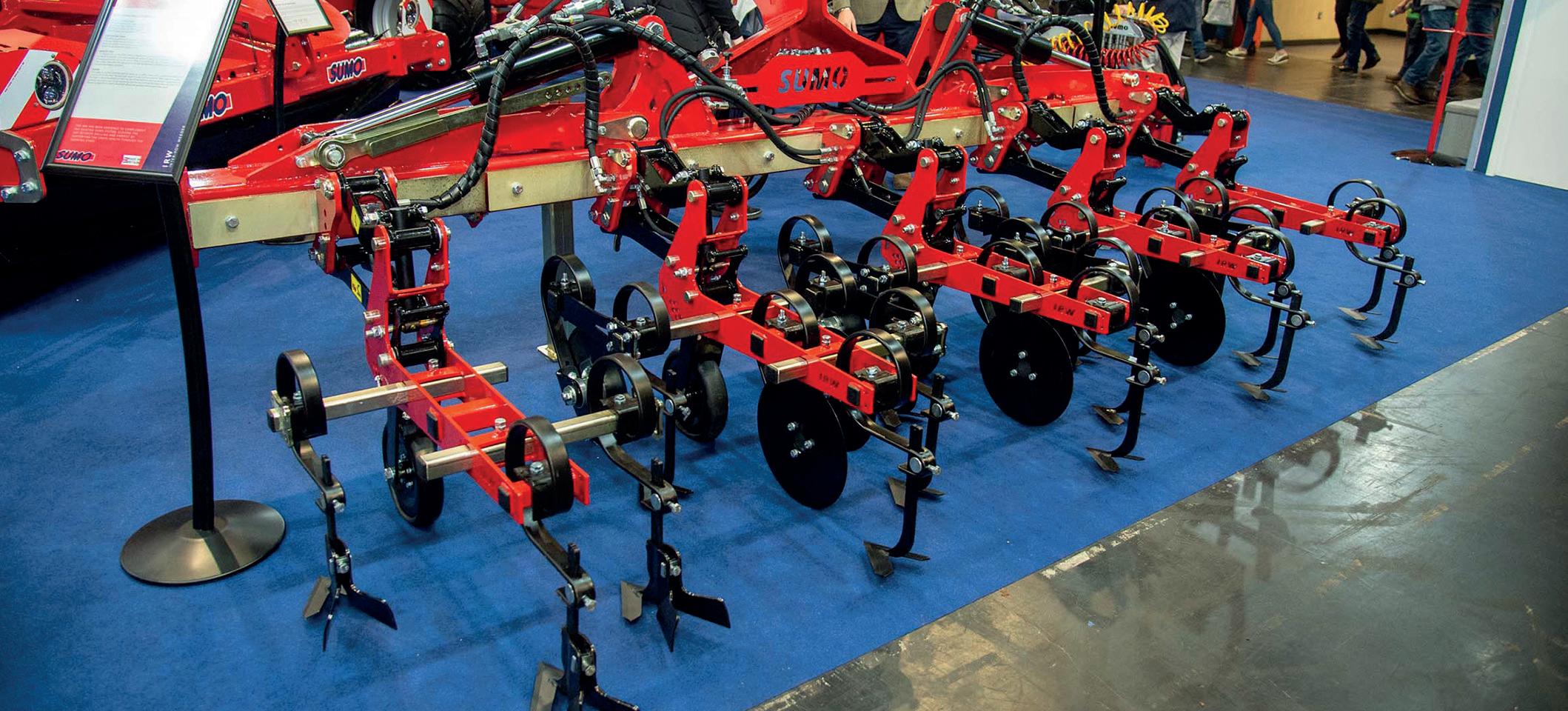
JDeveloped from the groundup as a new product, Yorkshirebased Sumo’s guided inter-row cultivator has been designed for use in cereal and row crops, including maize and beet. Currently offered as a six-metre machine with wider models up to 12 metres in development, the cultivator
uses hydraulically damped carriages offering working row widths of 180mm to 500mm, after which point individual carriages are used on each row.
Row following is offered using a Tillett and Haguesourced camera system working in conjunction with
McArthur mobile seed cleaning
JMcArthur Group showcased its mobile seed cleaning trailer, designed to allow oneperson set up and operation for seed cleaning and based around a vibrating cleaner from JC Machinery.
The company suggests its uses may include cleaning in wider rotations or where crops have higher specifications or added value markets due to the high-quality output. Interest
has also been shown in intercrops. The 3.5-tonne trailer can be supplied with an onboard generator or connected to an external power source.
Managing director John McArthur suggests the unit, which is said to have a payback period of three to five years, could provide a good opportunity for a contractor or for a group of farms to pool resources.
a hydraulic side-shift. Sumo claims the need for an interrow cultivator has arisen following customer demands for chemical-free weed control, together with the manufacturer’s ambition to offer a complete package of cultivation, establishment and weed control machinery.

Running ahead of the duckfoot tines, a pair of cutting discs are positioned to offer trash cutting, preventing the build-up of material on the legs. Alongside wider models, Sumo is developing a banded fertiliser placement system operating with the company’s existing front tank system.

Bednar Strip Master EN 6000

JBednar showed its new Strip Master EN 6000, which can be fitted with a macerator and distributor hoses to incorporate slurry as a nutrient while preparing cultivated strips for subsequent planting.
For each row, a pair of opening discs, controlled via
depth wheels, are followed by row cleaners and a subsoiler leg, with two slurry outlets which can be adjusted for depth of slurry injection. Discs either side of the outlets contain slurry in the strip.
Starting as soon as it is possible to travel, three or four
62 MACHINERY LAMMA FEBRUARY 2023
Grange Machinery
JHull-based Grange Machinery has expanded its product offering to include a dedicated strip tillage cultivator designed to work ahead of a maize planter.


The Preparator uses three rows of discs working in combination with a lowdisturbance leg. Offering a maximum working depth of 300mm in row centres from 0.45-0.8 metres, the design uses a hydraulically-adjusted second disc gang which can be moved longitudinally, increasing or decreasing soil engagement behind the leg.
A Guttler-sourced packer roll follows each cultivated strip, providing a weatherproof consolidated surface ahead of planting.
The machine is currently offered as a 3m mounted unit, with larger 4m and 6m versions in development. In addition to the banded cultivation, the implement can be fitted with a fertiliser distribution system delivering product behind each leg.
Grange says this design may be modified further to allow the unit to work as a drill to establish small seed crops.
Spreadpoint spray bowsers
JSpreadpoint introduced the WB range of spray bowsers from 6,000-18,000 litres, with stainless steel tank and fully customisable specification to include mix tank, choice of pumps and pipework, various platforms
and lockers. The 12,000litre model on display at LAMMA included a 3,000-litre mix tank to allow chemical premixing in the field for reduced spraying downtime, plus the standard 50kph tandem axle.
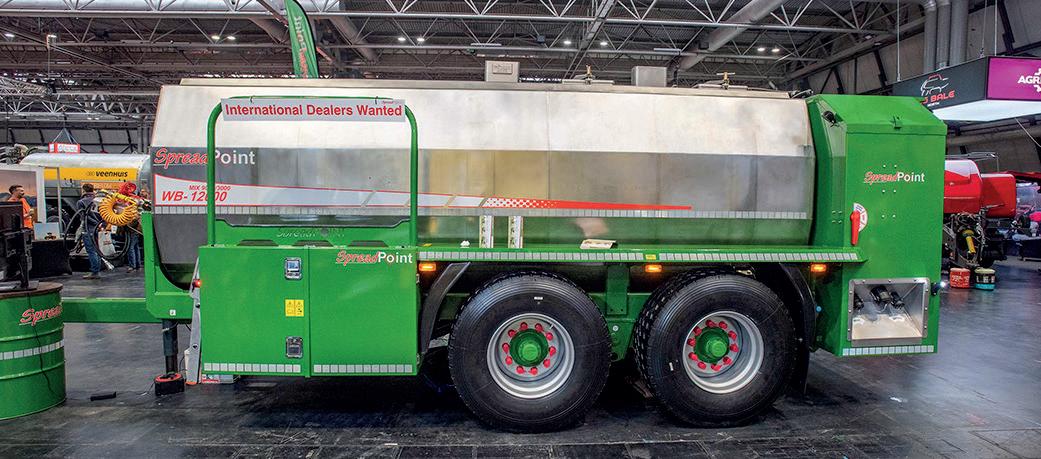
Standen Engineering planting developments
passes can be made ahead of the planter, warming the soil and allowing an early entry for crops such as maize, suggests the company. Working at six metres, row width can be set at 70, 75 and 85cm for maize or 45/50cm for sugar beet.
JStanden Engineering has added a square body option for its BX Bedformer series, designed to produce a square bed which allows for even filling of the destoner and creating a wider trench for stone spoil.
The Standen BX bedformer series includes two-, three- and four-bodied models with either standard bodies for heavier soils, where a traditional plough type is preferred, or convex ridger bodies and now, square bodies for light and stony land.
Shearbolt or auto-reset multi-directional legs can be specified.
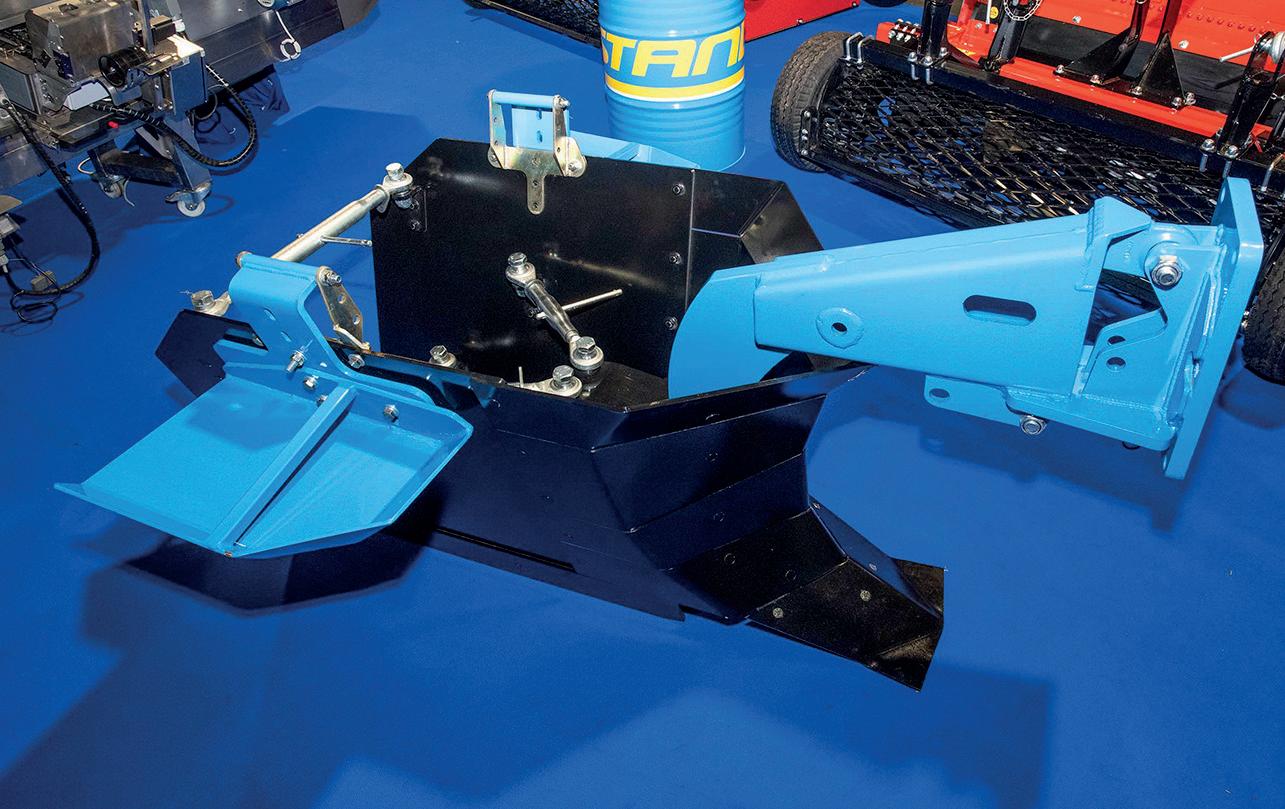
Standen is also to trial the four-row version of its new
SR200 cup planter this season with a special cup design to handle longer and larger seed. Said to be capable of forward speeds of up to
10kph, touch-screen controls operate the hydraulic space selector to give high levels of control over seed spacing and ensure accurate planting.
63 LAMMA MACHINERY FEBRUARY 2023
MATTCulley
Government’s ELM announcement has done little to boost confidence
The recent announcement at the Oxford Farming Conference by Farming Minister Mark Spencer on the subject of the Environmental Land Management schemes was welcome, but has done little to give confidence to growers seeking to make medium to long term management decisions for their farming businesses.
The good news of an additional management payment covering up to 50 hectares of land entered into the Sustainable Farming Incentive is a start, but it only masks the underlying problems and barriers of poor uptake and farmer engagement.
The slow rollout of standards and scheme progress gives little in terms of clarity and confidence, meaning growers know exactly what they are set to lose in terms of direct
About the author
rNFU crops board chairman Matt Culley is a fourth-generation farmer from Hampshire working in partnership with his parents and brother

rThe 720-hectare enterprise produces wheat, barley, oilseed rape, forage maize and rye for anaerobic digestion across varying soil types, from chalk and chalk loam to clay cap. This includes 170ha of owned and rented land and 540ha of contract farming agreements
rThe family also runs a pick-your-own soft fruit and summer vegetables business
payments, while having no clear vision of what they are set to gain from the new payment structures.
Once again, we ask Government for clear direction, schemes which are inclusive and available to every farm business and a package of standard offers which are simple, fit properly with existing Countryside Stewardship schemes and ultimately fairly reward farmers for taking part.
Barriers
Recently, some members of the NFU Crops Board travelled to Germany to meet with a seed breeders’ cooperative. Our hosts, Saaten Union have their headquarters based in the north of Germany, near Hanover, where we received presentations from representatives explaining the issues and barriers that are faced in Europe in terms of plant breeding and how they are trying to overcome them.
Breeding varieties that are marketable for such a large continent is challenging, as weather patterns, pests, soil types, and market demands vary significantly at that scale. To overcome these challenges and to remain competitive, Saaten Union is set up as a co-operative of seven major plant and seed breeding companies with significant farmer involvement.
Breeders are already increasing their focus on traits like nitrogen and nutrient use efficiency in crops such as wheat, rye and barley – this focus is not only driven by grower demands in terms of rising input
costs but also by the direction of EU farm policy especially the Farm to Fork strategy.
We also had the chance to give presentations and present case studies from crops board members about the challenges and barriers facing UK arable growers which breeding might be able to help with.
This was a good opportunity to explain how agricultural policy now differs from that of the EU, especially the move away from direct payments and towards payments for public goods, resulting in the potential for differing demands from growers and what they need from seed breeders.
One example of this, might be in the levels of interest in catch and cover crops here. We then travelled for a couple of hours south east to the Saaten Union biotechnology site, near the town of Quedlinburg.
One thing I did notice on our journey was the large expanse of autumn-sown crops, drilled hedgerow to hedgerow and treeline to treeline, very few margins, cover plots and buffer strips. Perhaps the soil in this region is too good not to produce anything but crops.
We enjoyed a tour around the biotechnology plant and a very good presentation on the difficulties of plant breeding for the future, while navigating the complex regulatory and political environment, was fascinating.
As in the UK, policy will affect so much of what we do and how we will grow crops in the future. It will be how we guide and respond to policy that ultimately really matters.
64 FEBRUARY 2023 TALKING POLICY
Staffing advice in the cost of living crisis
Agriculture is well known as a hard industry to recruit in, as well as a notoriously hard industry to get into for those who are not from a farming background.
So, with the UK facing a cost of living crisis, the prospect of supporting good employees
Get CPD points
JMembers of the BASIS register can now receive one CPD point for tuning into the podcast. Listen in to the podcast to find out how.
Social media
JFor the latest news and updates, follow us on social media:
LinkedIn:
rThe CropTec Show
through increasingly tough times may be daunting, but there are many things proactive farm businesses can be doing to help retain and attract good staff.

In this employmentfocused podcast, Alice Dyer finds out how to be a prominent employee and an appreciated employer.
Hear tips on standing out from the crowd, and CPD and training options.
Speakers:
rDave Back, labour auditor, DB Compliance.
rGeorge Mallender, recruitment consultant, MorePeople.

rJade Prince, business development manager, Basis.
Twitter:
r@ArableFarming
r@CropTecShow
r@AliceInWellies
Facebook:
rCropTec Show
rArable Farming
JThe show can be downloaded via croptecshow.com/crop-it-likeits-hot-podcast, or you can listen through Apple Podcasts or Google Podcasts. For more about our podcasts, email podcasts@agriconnect.com

More information
JThe Crop it Like it’s Hot podcast is produced by Arable Farming and CropTec Show. Released monthly, the show sees Arable Farming’s Alice Dyer talk to a range of arable experts to provide an alternative way of keeping up with agronomy and the latest arable developments.


65 PODCAST FEBRUARY 2023
Listen in BROUGHT TO YOU BY...
Dave Back, labour auditor, DB Compliance.
George Mallender, recruitment consultant, MorePeople.
Jade Prince, business development manager, Basis.
BASIS news Fresh future for NRoSO
At the end of January, BASIS Registration took over the role of administering the National Register of Sprayer Operators (NRoSO) on behalf of the Voluntary Initiative (VI) and plans are being developed between the two organisations to enhance the scheme and offer members more benefits.
Last year, the VI decided it was appropriate to re-tender for an organisation to administer the register of some 21,000 members who range from those using knapsack sprayers up to the large machines covering thousands of hectares of broadacre crops.
Dr Neal Evans, VI operations director, says: “A total of 16 organisations expressed an interest, although City & Guilds – which had administered the register since its launch – did not apply.”
The process was overseen by members of the VI Board and three short-listed suppliers were then interviewed.
Dr Evans says: “It was a strong

field. In the end BASIS Registration was awarded the contract due to its existing and proven track record in administering professional registers.”
While delighted to win the role, the BASIS team has a considerable amount of work to do in a relatively short time, according to chief executive Stephen Jacob, who aims to achieve synergy between existing BASIS professional

The latest news for BASIS and FACTS-qualified farmers and advisers.
registers and NRoSO. However, he stresses the NRoSO scheme will be operated separately.
Mr Jacob says: “We are in the process of recruiting a new and dedicated team to service NRoSO and its members.
“Answering to our head of education and training will be a manager, a team leader and six membership services advisers.
“The aim is to ensure a high level of service is provided to NRoSO members.”
Finalised
In addition, dedicated phonelines have been installed and a new website is being finalised.
While all parties are working for as smooth a changeover as possible, some glitches are inevitable. For instance, no new applications have been accepted since the end of 2022. But key stakeholders, such as Red Tractor, have been made aware and there will be some tolerance in the operation of assurance schemes for a short period.
Mr Jacob says: “The past two years have seen BASIS invest heavily in digital technology to deliver benefits to our professional registers.”
Dr Evans adds: “Our aim is to make the same benefits available to NRoSO members. And once we have completed the initial transfer, we will be looking to develop further benefits. For instance, the highly popular BASIS Classroom technology could be used to provide online training, enabling CPD points to be gathered at times which are convenient to sprayer operators.
“NRoSO is an important part of providing assurance to food processors, retailers and consumers that plant protection products are being used professionally.
“I believe the standard of sprayer operators in the UK is as high as anywhere in the world.
“Together with the National Sprayer Testing Scheme and integrated pest management planning, it is a vital part of the work overseen by the VI.”

66 FEBRUARY 2023
BASIS was awarded the contract due to its proven track record in administering professional registers
DR NEAL EVANS
BASIS plans to use its investment into digital technology to benefit NRoSO, after taking over administration of the scheme.
YOUR EVENT FOR AGRICULTURAL CHANGE





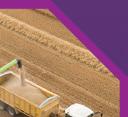














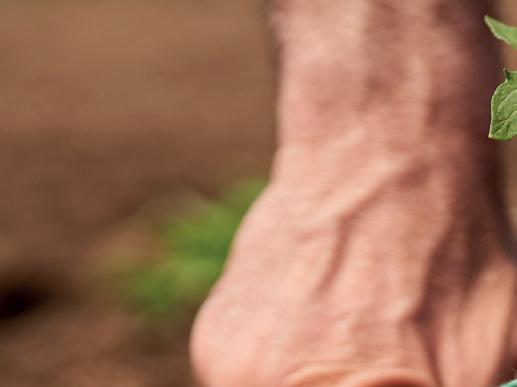
The Future Farming Expo will support Scotland and its farmers in order to make Scotland a global leader in innovative, profitable and sustainable agriculture.



WANTING TO VISIT?


The fast changing landscape for farming means strategic thinking, business resilience, new technology and rapid innovation are becoming more important on-farm, particularly as Scotland works towards its Net Zero goal.



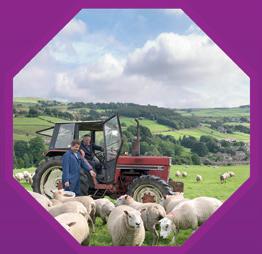








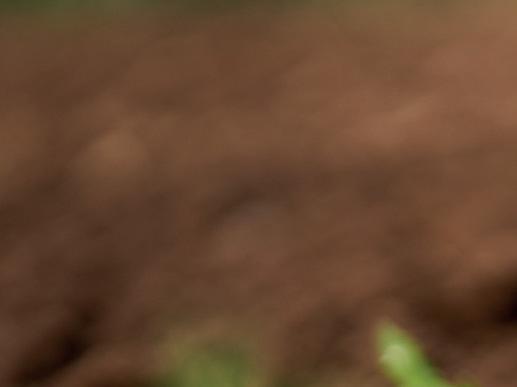
Topics Include:











Register for your FREE ticket www.futurefarmingexpo.com
2023 Livestock Diversification Arable
and Vertical Farming Robotics Renewables and Energy Carbon and Soils
and Personal Resilience
Horticulture
Business
ONE fendt.com | Fendt is a worldwide brand of AGCO
THING IS





So that tractor and office become one.
Goodbye paperwork! The new generation of Fendt tractors with FendtONE combines the driver’s workplace and office in a single operating system. This makes documentation simple, fast and intuitive. And you have more time for the essentials.


It’s Fendt. Because we understand Agriculture.

Learn more at www.fendt.com/fendtone SIMPLE: FendtONE
















































































































































































































































































































































































































































